TP Link Technologies TDW8961NDV4 300Mbps Wireless N ADSL2+ Modem Router User Manual TD W8961N
TP-Link Technologies Co., Ltd. 300Mbps Wireless N ADSL2+ Modem Router TD W8961N
Contents
- 1. User Manual (TD-W8961N)
- 2. User Manual (TD-W8961ND)
User Manual (TD-W8961N)
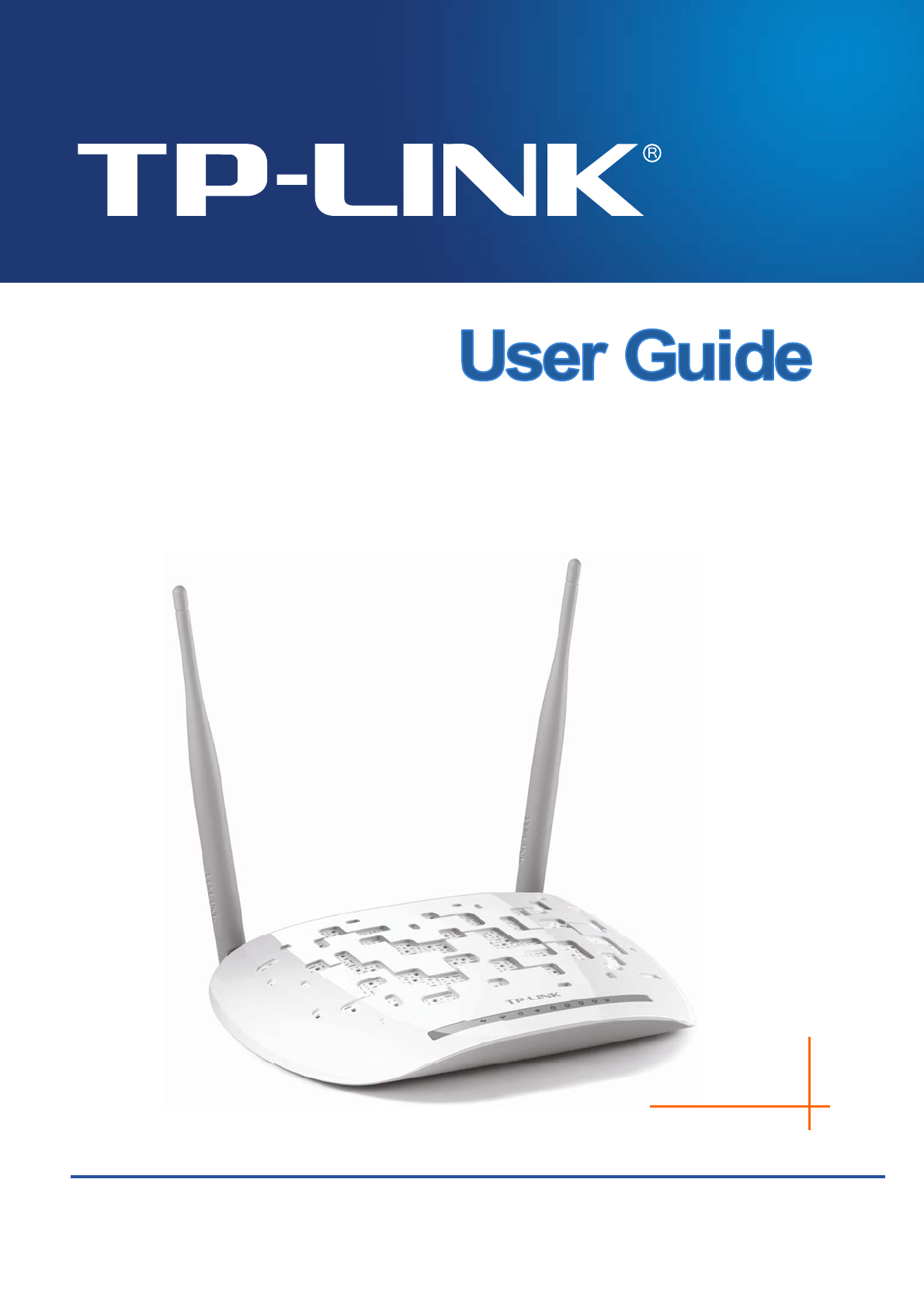
TD-W8961N
300Mbps Wireless N ADSL2+ Modem Router
REV:2.0.0
1910011338

COPYRIGHT & TRADEMARKS
Specifications are subject to change without notice. is a registered trademark of
TP-LINK TECHNOLOGIES CO., LTD. Other brands and product names are trademarks or
registered trademarks of their respective holders.
No part of the specifications may be reproduced in any form or by any means or used to make any
derivative such as translation, transformation, or adaptation without permission from TP-LINK
TECHNOLOGIES CO., LTD. Copyright © 2015 TP-LINK TECHNOLOGIES CO., LTD. All rights
reserved.
http://www.tp-link.com

FCC STATEMENT
This equipment has been tested and found to comply with the limits for a Class B digital device,
pursuant to part 15 of the FCC Rules. These limits are designed to pro-vide reasonable protection
against harmful interference in a residential installation. This equipment generates, uses and can
radiate radio frequency energy and, if not in-stalled and used in accordance with the instructions,
may cause harmful interference to radio communications. However, there is no guarantee that
interference will not occur in a particular installation. If this equipment does cause harmful
interference to radio or television reception, which can be determined by turning the equipment off
and on, the user is encouraged to try to correct the interference by one or more of the following
measures:
Reorient or relocate the receiving antenna.
Increase the separation between the equipment and receiver.
Connect the equipment into an outlet on a circuit different from that to which the
receiver is connected.
Consult the dealer or an experienced radio/ TV technician for help.
This device complies with part 15 of the FCC Rules. Operation is subject to the following two
conditions:
1) This device may not cause harmful interference.
2) This device must accept any interference received, including interference that may
cause undesired operation.
Any changes or modifications not expressly approved by the party responsible for compliance
could void the user’s authority to operate the equipment.
Note: The manufacturer is not responsible for any radio or TV interference caused by
unauthorized modifications to this equipment. Such modifications could void the user’s authority
to operate the equipment.
FCC RF Radiation Exposure Statement
This equipment complies with FCC RF radiation exposure limits set forth for an uncontrolled
environment. This device and its antenna must not be co-located or operating in conjunction with
any other antenna or transmitter.
“To comply with FCC RF exposure compliance requirements, this grant is applicable to only
Mobile Configurations. The antennas used for this transmitter must be installed to provide a
separation distance of at least 20 cm from all persons and must not be co-located or operating in
conjunction with any other antenna or transmitter.”

CE Mark Warning
This is a class B product. In a domestic environment, this product may cause radio interference, in
Canadian Compliance Statement
exempt RSS standard(s). Operation is subject
erference, and
luding interference that may cause undesired
me aux norms CNR exemptes de licence d’Industrie Canada. Le
is celles susceptibles de provoquer un
Industry Canada Statement
cifications.
NMB-003 du Canada.
s all the
du Règlement sur le
Korea Warning Statements:
있음.
NCC Notice & BSMI Notice
電波輻射性電機管理辦法
電機,非經許可,公司、商號或使用者均不得擅自變更頻
航安全及干擾合法通行;經發現有干擾現象時,應立
which case the user may be required to take adequate measures.
This device complies with Industry Canada license-
to the following two conditions:
(1) This device may not cause int
(2)This device must accept any interference, inc
operation of the device.
Cet appareil est confor
fonctionnement est soumis aux deux conditions suivantes:
(1) cet appareil ne doit pas provoquer d’interférences et
(2) cet appareil doit accepter toute interférence, y compr
fonctionnement non souhaité de l’appareil.
Complies with the Canadian ICES-003 Class B spe
Cet appareil numérique de la classe B est conforme à la norme
This device complies with RSS 210 of Industry Canada. This Class B device meet
requirements of the Canadian interference-causing equipment regulations.
Cet appareil numérique de la Classe B respecte toutes les exigences
matériel brouilleur du Canada.
당해 무선설비는 운용중 전파혼신 가능성이
注意!
依據 低功率
第十二條 經型式認證合格之低功率射頻
率、加大功率或變更原設計之特性或功能。
第十四條 低功率射頻電機之使用不得影響飛
即停用,並改善至無干擾時方得繼續使用。前項合法通信,指依電信規定作業之無線電信。低功率

射頻電機需忍受合法通信或工業、科學以及醫療用電波輻射性電機設備之干擾。
減少電磁波影響,請妥適使用。
安全諮詢及注意事項
●請使用原裝電源供應器或只能按照本產品注明的電源類型使用本產品。
●清潔本產品之前請先拔掉電源線。請勿使用液體、噴霧清潔劑或濕布進行清潔。
●注意防潮,請勿將水或其他液體潑灑到本產品上。
●插槽與開口供通風使用,以確保本產品的操作可靠並防止過熱,請勿堵塞或覆蓋開口。
●請勿將本產品置放於靠近熱源的地方。除非有正常的通風,否則不可放在密閉位置中。
●請不要私自打開機殼,不要嘗試自行維修本產品,請由授權的專業人士進行此項工作。
UkrSEPRO
Продукт сертифіковано згідно с правилами системи УкрСЕПРО на відповідність вимогам
нормативних документів та вимогам, що передбачені чинними законодавчими актами
України.
Safety Information
When product has power button, the power button is one of the way to shut off the product;
when there is no power button, the only way to completely shut off power is to disconnect the
product or the power adapter from the power source.
Don’t disassemble the product, or make repairs yourself. You run the risk of electric shock
and voiding the limited warranty. If you need service, please contact us.
Avoid water and wet locations.
This product can be used in the following countries:
AT BG BY CA CZ DE DK EE
ES FI FR GB GR HU IE IT
LT LV MT NL NO PL PT RO
RU SE SK TR UA US

TP-LINK TECHNOLOGIES CO., LTD
TP-LINK TECHNOLOGIES CO., LTD.
Building 24 (floors 1, 3, 4, 5), and 28 (floors 1-4) Central Science and Technology Park,
Shennan Rd, Nanshan, Shenzhen, China
DECLARATION OF CONFORMITY
For the following equipment:
Product Description: 300Mbps Wireless N ADSL2+ Modem Router
Model No.: TD-W8961N
Trademark: TP-LINK
We declare under our own responsibility that the above products satisfy all the technical
regulations applicable to the product within the scope of Council Directives:
Directives 1999/5/EC, Directives 2004/108/EC, Directives 2006/95/EC, Directives 1999/519/EC,
Directives 2011/65/EU
The above product is in conformity with the following standards or other normative documents
EN 300 328 V1.8.1
EN 301 489-1 V1.9.2 & EN 301 489-17 V2.2.1
EN 55022: 2010 + AC: 2011
EN 55024: 2010
EN 61000-3-2: 2006 + A1: 2009 + A2: 2009
EN 61000-3-3: 2013
EN 60950-1: 2006 + A11: 2009 + A1: 2010 + A12: 2011
EN 50385: 2002
The product carries the CE Mark:
Person responsible for making this declaration:
Yang Hongliang
Product Manager of International Business
Date of issue: 2015
EN 60950-1: 2006 + A11: 2009 + A1: 2010 + A12: 2011+A2:2013
CONTENTS
Chapter 1Introduction ......................................................................................... 1
1.1Product Overview.................................................................................. 1
1.2Main Features ....................................................................................... 1
1.3Conventions .......................................................................................... 2
Chapter 2Hardware Installation.......................................................................... 3
2.1The Front Panel .................................................................................... 3
2.2The Back Panel..................................................................................... 5
2.3Installation Environment........................................................................ 6
2.4Connecting the Modem Router ............................................................. 7
Chapter 3Quick Installation Guide ..................................................................... 9
3.1TCP/IP Configuration ............................................................................ 9
3.2Login ................................................................................................... 10
Chapter 4Software Configuration .................................................................... 14
4.1Status.................................................................................................. 14
4.1.1Device Info............................................................................................... 14
4.1.2System Log.............................................................................................. 15
4.1.3Statistics .................................................................................................. 16
4.2Quick Start .......................................................................................... 18
4.3Interface Setup.................................................................................... 19
4.3.1Internet .................................................................................................... 19
4.3.2LAN ......................................................................................................... 25
4.3.3Wireless................................................................................................... 30
4.3.46RD ......................................................................................................... 40
4.3.5Guest Network......................................................................................... 41
4.4Advanced Setup.................................................................................. 42
4.4.1Firewall .................................................................................................... 42
4.4.2Routing .................................................................................................... 43
4.4.3NAT ......................................................................................................... 44
4.4.4QoS ......................................................................................................... 47
4.4.5VLAN ....................................................................................................... 49
4.4.6ADSL ....................................................................................................... 51
4.5Access Management........................................................................... 52
4.5.1ACL ......................................................................................................... 52
4.5.2Filter ........................................................................................................ 53
4.5.3SNMP ...................................................................................................... 61
4.5.4UPnP ....................................................................................................... 61
4.5.5DDNS ...................................................................................................... 62
4.5.6CWMP ..................................................................................................... 62
4.6Maintenance........................................................................................ 63
4.6.1Administration.......................................................................................... 63
4.6.2Time Zone ............................................................................................... 64
4.6.3Firmware.................................................................................................. 65
4.6.4SysRestart ............................................................................................... 67
4.6.5Diagnostics.............................................................................................. 68
4.7Help..................................................................................................... 68
Appendix A: Specifications................................................................................... 70
Appendix B: Configuring the PC........................................................................... 71
Appendix C: Troubleshooting............................................................................... 75

TD-W8961N 300Mbps Wireless N ADSL2+ Modem Router User Guide
1
Chapter 1 Introduction
Thank you for choosing the TD-W8961N 300Mbps Wireless N ADSL2+ Modem Router.
1.1 Product Overview
The device is designed to provide a simple and cost-effective ADSL Internet connection for a
private Ethernet or IEEE 802.11n/ IEEE 802.11g/ IEEE 802.11b wireless network.
The TD-W8961N connects to an Ethernet LAN or computers via standard Ethernet ports. The
ADSL connection is made using ordinary telephone line with standard connectors. Multiple
workstations can be networked and connected to the Internet using a single Wide Area Network
(WAN) interface and single global IP address. The advanced security enhancements, IP/MAC
Filter, Application Filter and URL Filter can help to protect your network from potentially
devastating intrusions by malicious agents from the outside of your network.
Quick Start of the Web-based Utility is supplied and friendly help messages are provided for the
configuration. Network and Router management is done through the Web-based Utility which can
be accessed through local Ethernet using any web browser.
ADSL
The TD-W8961N supports full-rate ADSL2+ connectivity conforming to the ITU and ANSI
specifications. In addition to the basic DMT physical layer functions, the ADSL2+ PHY supports
dual latency ADSL2+ framing (fast and interleaved) and the I.432 ATM Physical Layer.
Wireless
In the most attentive wireless security, the modem router provides multiple protection measures. It
can be set to turn off the wireless network name (SSID) broadcast so that only stations that have
the SSID can be connected. The modem router provides wireless LAN 64/128-bit WEP encryption
security, WPA-PSK/WPA2-PSK authentication, as well as TKIP/AES encryption security.
1.2 Main Features
Four 10/100Mbps Auto-Negotiation RJ45 LAN ports (Auto MDI/MDIX), one RJ11 port.
Provides external splitter.
Adopts Advanced DMT modulation and demodulation technology.
Supports bridge mode and Router function.
Multi-user sharing a high-speed Internet connection.
Downstream data rates up to 24Mbps, upstream data rates up to 3.5Mbps (With Annex M
enabled).
Supports long transfers, the max line length can reach to 6.5Km.
Supports remote configuration and management through SNMP and CWMP.

TD-W8961N 300Mbps Wireless N ADSL2+ Modem Router User Guide
2
Supports PPPoE, it allows connecting the internet on demand and disconnecting from the
Internet when idle.
Provides reliable ESD and surge-protect function with quick response semi-conductive surge
protection circuit.
High speed and asymmetrical data transmit mode, provides safe and exclusive bandwidth.
Supports All ADSL industrial standards.
Compatible with all mainstreams DSLAM (CO).
Provides integrated access of internet and route function which face to SOHO user.
Real-time Configuration and device monitoring.
Supports Multiple PVC (Permanent Virtual Circuit).
Built-in DHCP server.
Built-in firewall, supporting IP/MAC filter, Application filter and URL filter.
Supports Virtual Server, DMZ host and IP Address Mapping.
Supports Dynamic DNS, UPnP and Static Routing.
Supports system log and flow Statistics.
Supports firmware upgrade and Web management.
Provides WPA-PSK/WPA2-PSK data security, TKIP/AES encryption security.
Provides 64/128-bit WEP encryption security and wireless LAN ACL (Access Control List).
1.3 Conventions
The modem router or device mentioned in this User Guide stands for TD-W8961N without any
explanations.
Parameters provided in the pictures are just references for setting up the product, which may
differ from the actual situation.

TD-W8961N 300Mbps Wireless N ADSL2+ Modem Router User Guide
3
Chapter 2 Hardware Installation
2.1 The Front Panel
Figure 2-1
The LEDs locate on the front panel. They indicate the device’s working status. For details, please
refer to LED Explanation.
LED Explanation:
Name Status Indication
On System initialization complete.
Flash
System initializing or firmware upgrading is in process. Do not
disconnect or power off the modem router.
(Power)
Off Power is off.
On ADSL line is synchronized and ready to use.
Flash The ADSL negotiation is in progress.
(ADSL)
Off
ADSL synchronization fails. Please refer to Note 1 for
troubleshooting.
On Internet connection is available.
Flash There is data being transmitted or received via the Internet.
(INTERNET)
Off
No Internet connection or the modem router is operating in
Bridge mode. Please refer to Note 2 for troubleshooting.
On The wireless function is enabled.
Flash
The modem router is sending or receiving data over the
wireless network.
(Wireless)
Off The wireless function is disabled.
On
A wireless device has been successfully added to the network
by WPS function.
Flash A wireless device is trying to connect to the network via WPS.
This process may take up to 4 minutes.
(WPS)
Off
The WPS function is disabled or the wireless device fails to be
added to the network in 4 minutes after WPS function is
enabled. Please refer to WPS Settings for more information.

TD-W8961N 300Mbps Wireless N ADSL2+ Modem Router User Guide
4
Name Status Indication
On The corresponding LAN port is connected.
Flash
The modem router is sending or receiving data over this LAN
port.
(LAN1-4)
Off The corresponding LAN port is not connected.
Note:
1. If the ADSL LED is off, please check your Internet connection first. Refer to 2.4 Connecting
the Router for more information about how to make Internet connection correctly. If you have
already made a right connection, please contact your ISP to make sure if your Internet service
is available now.
2. If the Internet LED is off, please check your ADSL LED first. If your ADSL LED is also off,
please refer to Note 1. If your ADSL LED is on, please check your Internet configuration. You
may need to check this part of information with your ISP and make sure everything have been
input correctly. Refer to 4.1.1 Device Info and 4.3.1 Internet for more information.
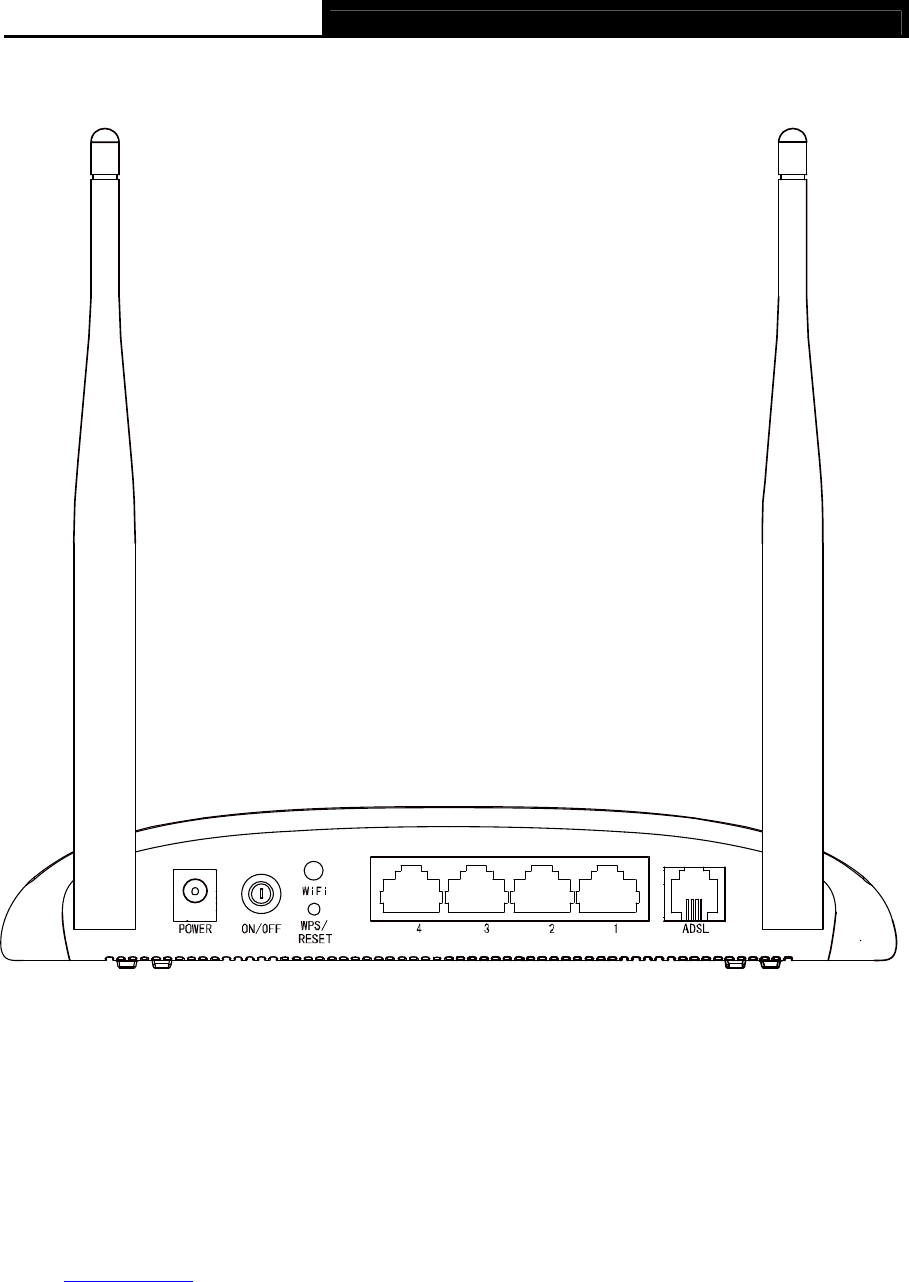
TD-W8961N 300Mbps Wireless N ADSL2+ Modem Router User Guide
5
2.2 The Back Panel
LAN LAN LAN LAN
Figure 2-2
POWER: The Power plug is where you will connect the power adapter.
ON/OFF: The switch for the power.
WiFi: The button for the wireless function.
WPS/RESET: The switch for the WPS function. If your client devices, such as wireless
adapters, support Wi-Fi Protected Setup, then you can press this button for about two
seconds to quickly establish a connection between the router and client devices and
automatically configure wireless security for your wireless network. For details, please refer
to WPS Settings. If you press this button for more than 8 seconds, you will enable the RESET
function. There are two ways to reset the modem router's factory defaults.
Method one: With the modem router powered on, press and hold down the WPS/RESET
button on the rear panel for at least 8 seconds until some LEDs go off, then release the
button.
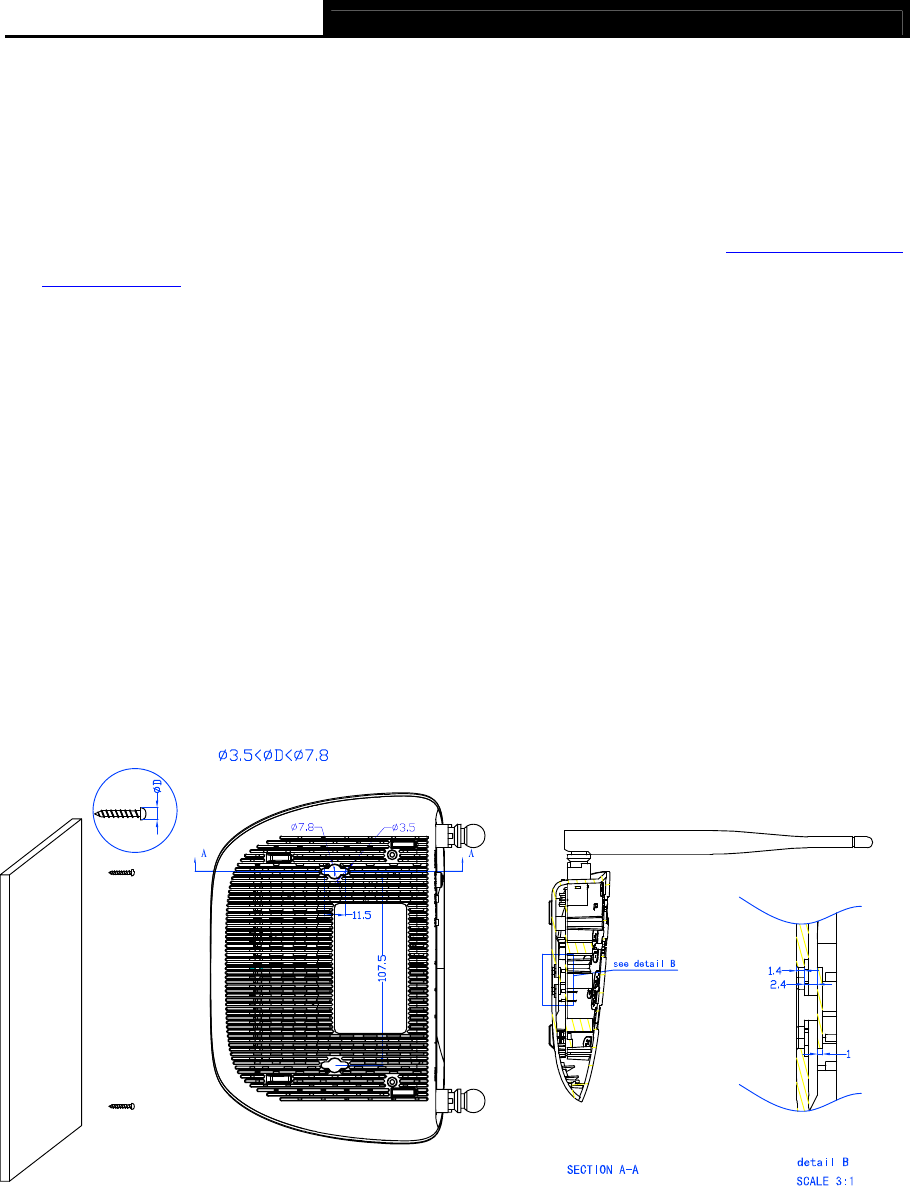
TD-W8961N 300Mbps Wireless N ADSL2+ Modem Router User Guide
6
Method two: Restore the default setting from “Maintenance-SysRestart” of the modem
router's Web-based Utility.
LAN 1, LAN 2, LAN 3, LAN 4: Through the port, you can connect the modem router to your
PC or the other Ethernet network devices.
ADSL: Through the port, you can connect the modem router with the telephone. Or you can
connect them by an external separate splitter. For details, please refer to 2.4 Connecting the
Modem Router.
Antennas: Used for wireless operation and data transmit.
2.3 Installation Environment
The Product should not be located where it will be exposed to moisture or excessive heat.
Place the modem router in a location where it can be connected to the various devices as
well as to a power source.
Make sure the cables and power cord are safely placed out of the way so they do not create a
tripping hazard.
The modem router can be placed on a shelf or desktop.
Keep away from the strong electromagnetic radiation and the device of electromagnetic
sensitive.
Generally, the modem router is placed on a horizontal surface. The device also can be mounted
on the wall as shown in the following figure.
Note:
The diameter of the screw, 3.5mm<D<7.8mm, and the distance of two screws is 107.5mm. The
screw that project from the wall need around 4mm based, and the length of the screw need to be
at least 20mm to withstand the weight of the product.

TD-W8961N 300Mbps Wireless N ADSL2+ Modem Router User Guide
7
2.4 Connecting the Modem Router
Before installing the device, please make sure your broadband service provided by your ISP is
available. If there is any problem, please contact your ISP. Before cable connection, cut off the
power supply and keep your hands dry. You can follow the steps below to install it.
Step 1: Connect the ADSL Line.
Method one: Plug one end of the twisted-pair ADSL cable into the ADSL port on the rear
panel of TD-W8961N, and insert the other end into the wall socket.
Method two:You can use a separate splitter. External splitter can divide the data and
voice, and then you can access the Internet and make calls at the same time. The
external splitter has three ports:
• LINE: Connect to the wall jack
• PHONE: Connect to the phone sets
• MODEM: Connect to the ADSL port of TD-W8961N
Plug one end of the twisted-pair ADSL cable into the ADSL port on the rear panel of
TD-W8961N. Connect the other end to the MODEM port of the external splitter.
Step 2: Connect the Ethernet cable. Attach one end of a network cable to your computer’s
Ethernet port or a regular hub/switch port, and the other end to the LAN port on the
TD-W8961N.
Step 3: Power on the computers and LAN devices.
Step 4: Attach the power adapter. Connect the power adapter to the power connector on the rear
of the device and plug in the adapter to an electrical outlet or power extension. The
electrical outlet shall be installed near the device and shall be easily accessible.
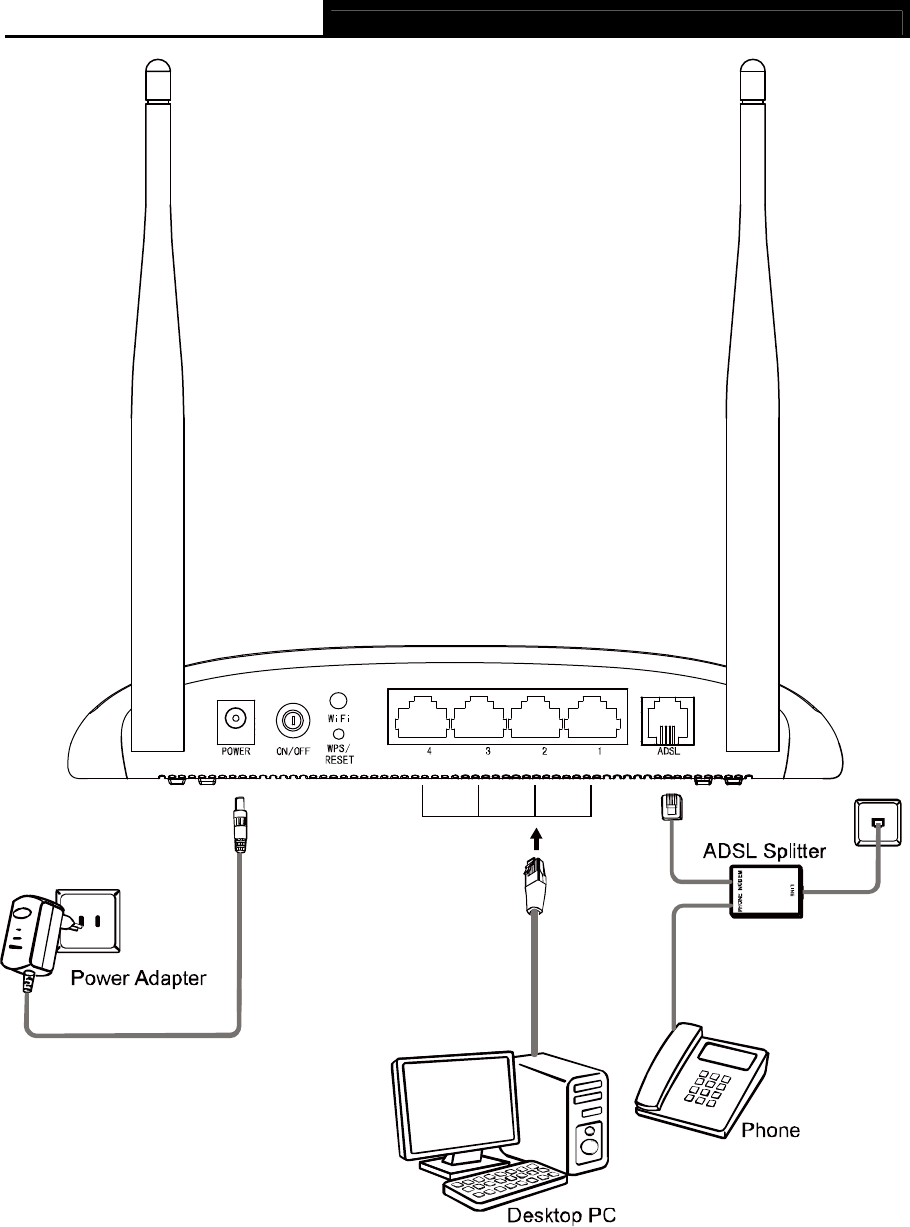
TD-W8961N 300Mbps Wireless N ADSL2+ Modem Router User Guide
8
LAN LAN LAN LAN
Figure 2-3
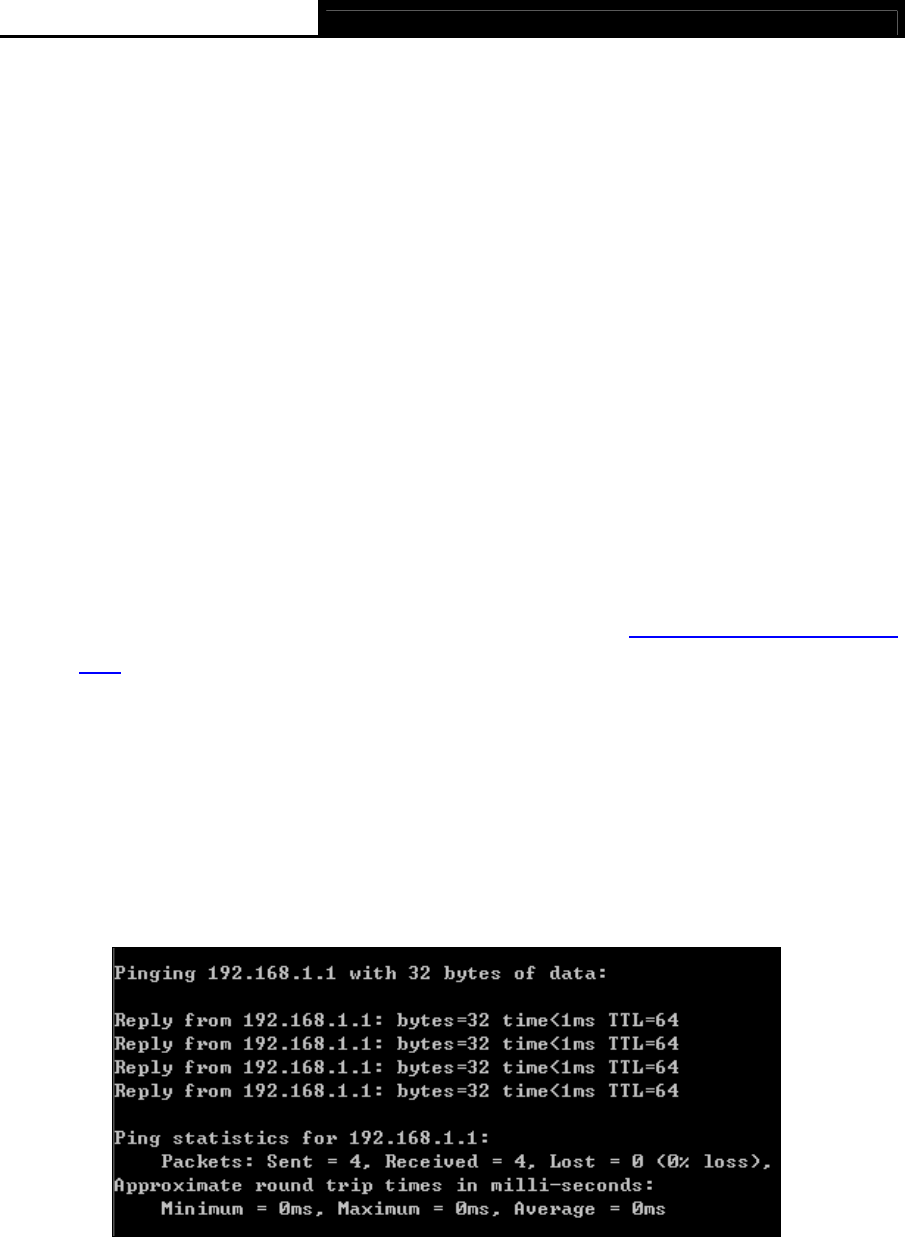
TD-W8961N 300Mbps Wireless N ADSL2+ Modem Router User Guide
9
Chapter 3 Quick Installation Guide
This chapter will show you how to configure the basic functions of your TD-W8961N 300Mbps
Wireless N ADSL2+ Modem Router using Quick Setup Wizard within minutes.
3.1 TCP/IP Configuration
The default IP address of the TD-W8961N 300Mbps Wireless N ADSL2+ Modem Router is
192.168.1.1. And the default Subnet Mask is 255.255.255.0. These values can be changed as
you desire. In this guide, we use all the default values for description.
Connect the local PC to the LAN/WAN port of the Modem Router. Configure your PC to obtain IP
address automatically in the following way.
Obtain an IP address automatically
1) Set up the TCP/IP Protocol in "Obtain an IP address automatically" mode on your PC.
If you need instructions as to how to do this, please refer to Appendix B: "Configuring the
PC”.
2) Then the built-in DHCP server will assign IP address for the PC.
Now, you can run the Ping command in the command prompt to verify the network connection.
Please click the Start menu on your desktop, select run tab, type cmd or command in the field
and press Enter. Type ping 192.168.1.1 on the following screen, and then press Enter.
If the result displayed is similar to the screen below, the connection between your PC and the
router has been established.
Figure 3-1
If the result displayed is similar to the screen shown below, it means that your PC has not
connected to the router.
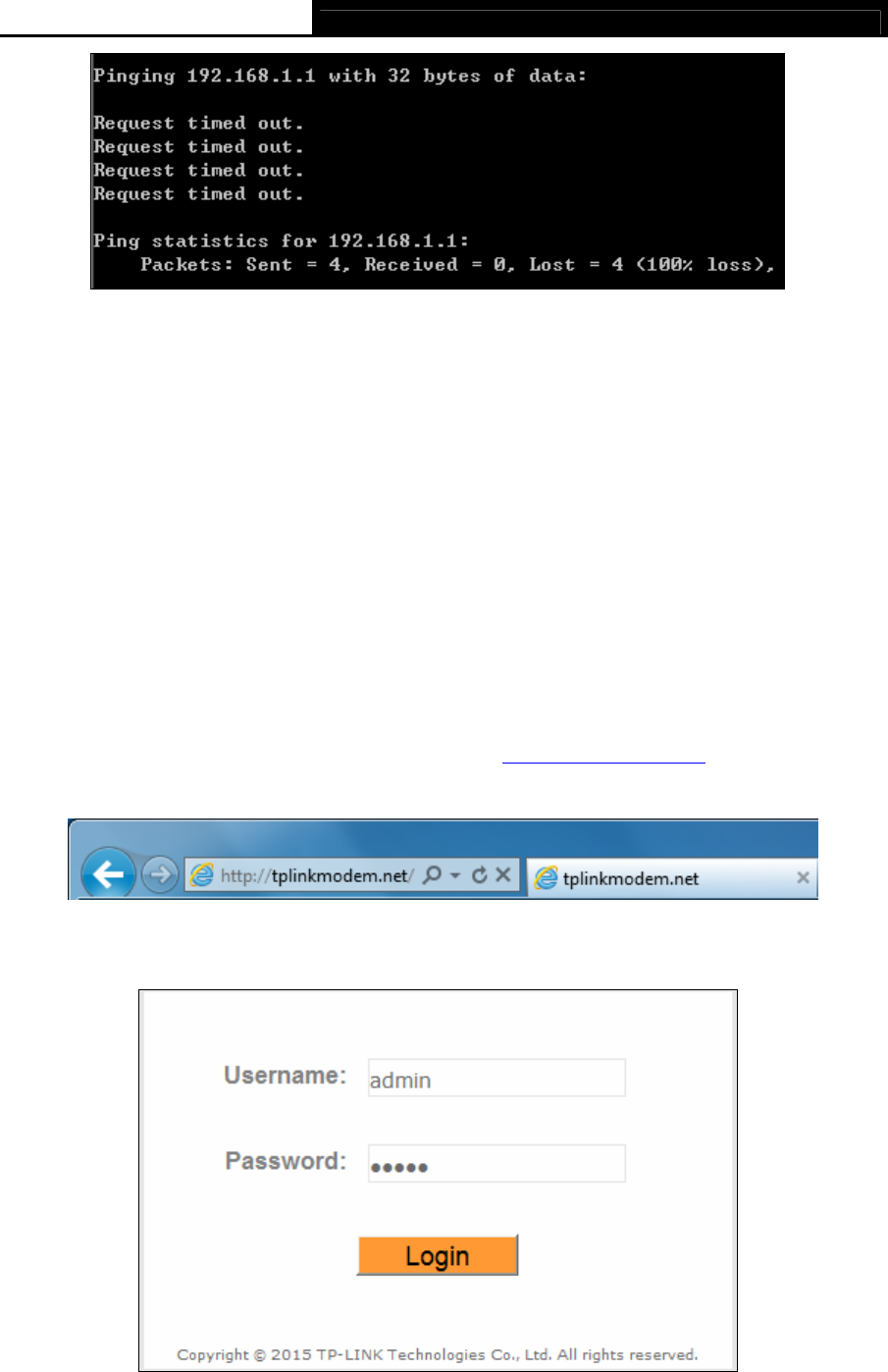
TD-W8961N 300Mbps Wireless N ADSL2+ Modem Router User Guide
10
Figure 3-2
You can check it by following the steps below:
1) Is the connection between your PC and the router correct?
The LEDs of LAN port which you link to the device and the LEDs on your PC's adapter should
be lit.
2) Is the TCP/IP configuration for your PC correct?
If the router's IP address is 192.168.1.1, your PC's IP address must be within the range of
192.168.1.2 ~ 192.168.1.254.
3.2 Login
Once your host PC is properly configured, please proceed as following instructions to use the
Web-based Utility: Launch your web browser and enter http://tplinkmodem.net or 192.168.1.1 in
the address bar.
After that, you will see the screen shown as below, enter the default User Name admin and the
default Password admin, and then click Login button to access to the Quick Start screen.
Figure 3-3
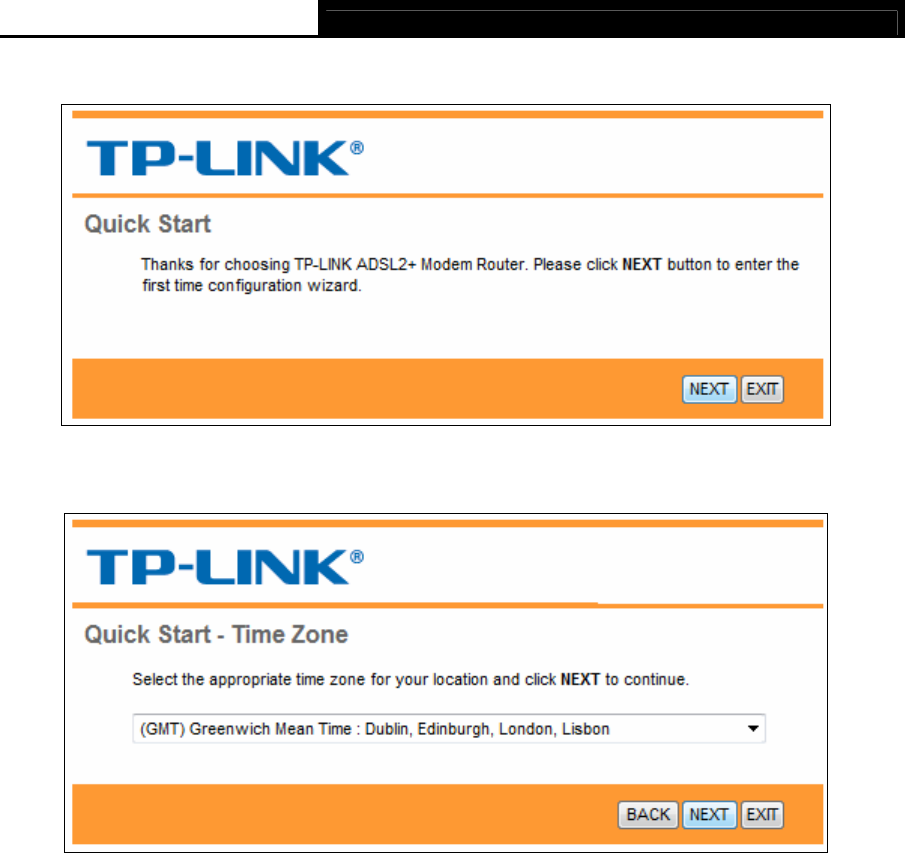
TD-W8961N 300Mbps Wireless N ADSL2+ Modem Router User Guide
11
Step 1: Click the NEXT button.
Figure 3-4
Step 2: Configure the time zone for the modem router, and then click the NEXT button.
Figure 3-5
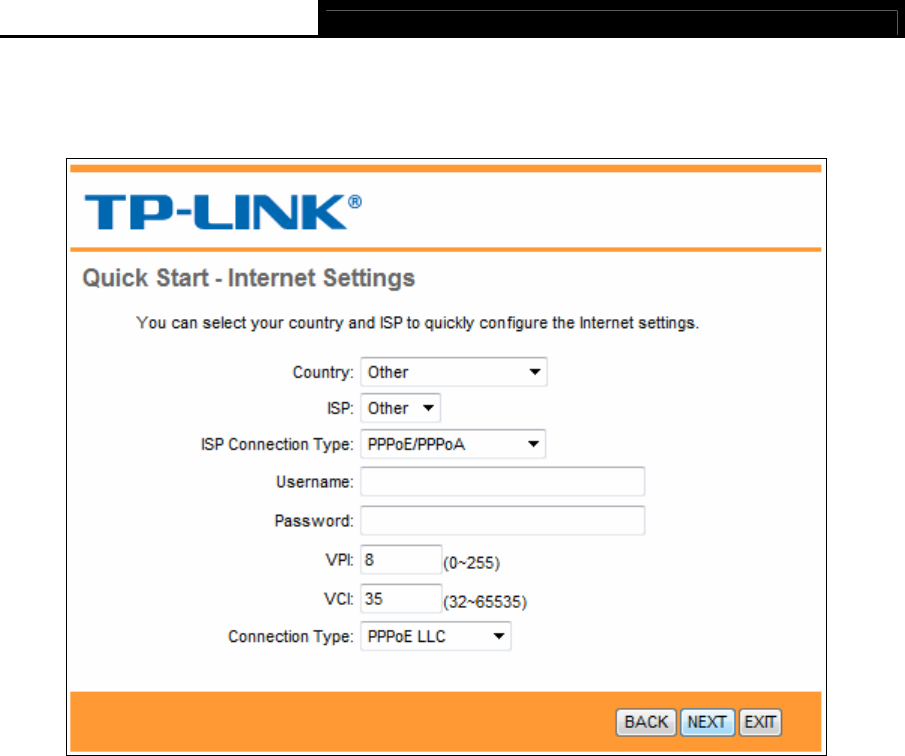
TD-W8961N 300Mbps Wireless N ADSL2+ Modem Router User Guide
12
Step 3: Select your country and ISP, and select your ISP Connection type (Here we take
PPPoE/PPPoA mode for example), and complete the corresponding settings with the
information provided by your ISP, then click the NEXT button.
Figure 3-6
Note:
Per FCC regulations, all Wi-Fi products marketed in the U.S. must be fixed to the U.S. region
only.
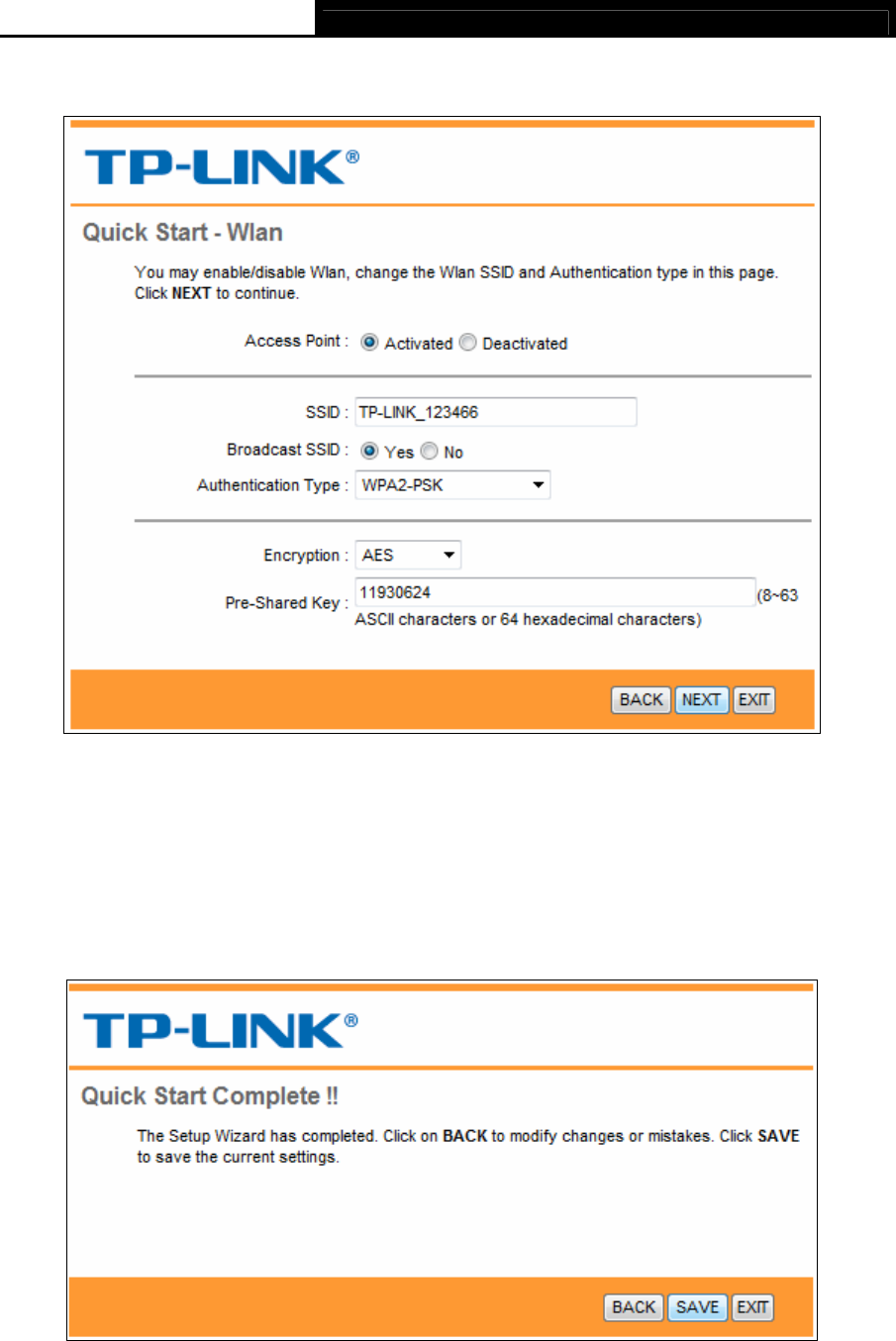
TD-W8961N 300Mbps Wireless N ADSL2+ Modem Router User Guide
13
Step 4: Configure the rules for the Wlan, and click the NEXT button.
Figure 3-7
Note:
If the Access Point is activated, the wireless function will be available even without the external
antenna because of an additional printed antenna. To adopt the wireless security protection
measures, please refer to section 4.3.3.
Step 5: Click SAVE to finish the Quick Start.
Figure 3-8
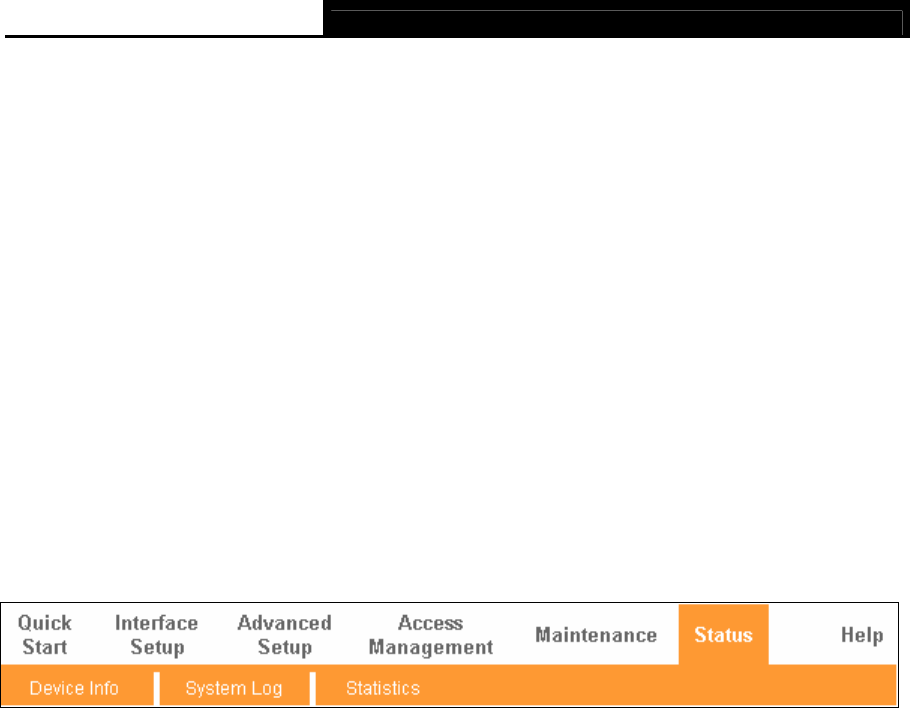
TD-W8961N 300Mbps Wireless N ADSL2+ Modem Router User Guide
14
Chapter 4 Software Configuration
This User Guide recommends using the “Quick Installation Guide” for first-time installation. For
advanced users, if you want to know more about this device and make use of its functions
adequately, maybe you will get help from this chapter to configure the advanced settings through
the Web-based Utility.
After your successful login, you can configure and manage the device. There are main menus on
the top of the Web-based Utility; submenus will be available after you click one of the main menus.
On the center of the Web-based Utility, there are the detailed configurations or status information.
To apply any settings you have altered on the page, please click the SAVE button.
4.1 Status
Choose “Status”, you can see the following submenus: Device Info, System Log and Statistics.
Click any of them, and you will be able to configure the corresponding function.
Figure 4-1
Click any of them, and you will be able to view the corresponding information.
4.1.1 Device Info
Choose “Status→Device Info” menu, and you will be able to view the device information,
including LAN, WAN and ADSL. The information will vary depending on the settings of the modem
router configured on the Interface Setup screen.
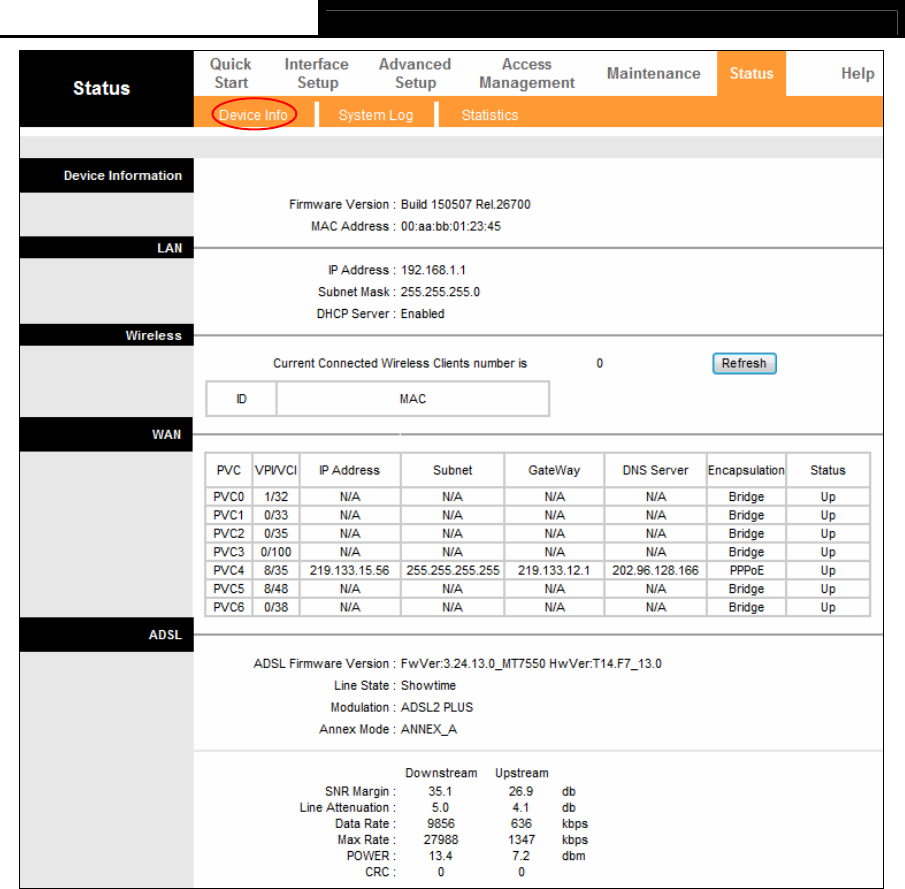
TD-W8961N 300Mbps Wireless N ADSL2+ Modem Router User Guide
15
Figure 4-2
4.1.2 System Log
Choose “Status→System Log” menu, and you will be able to query the logs of the modem
router.
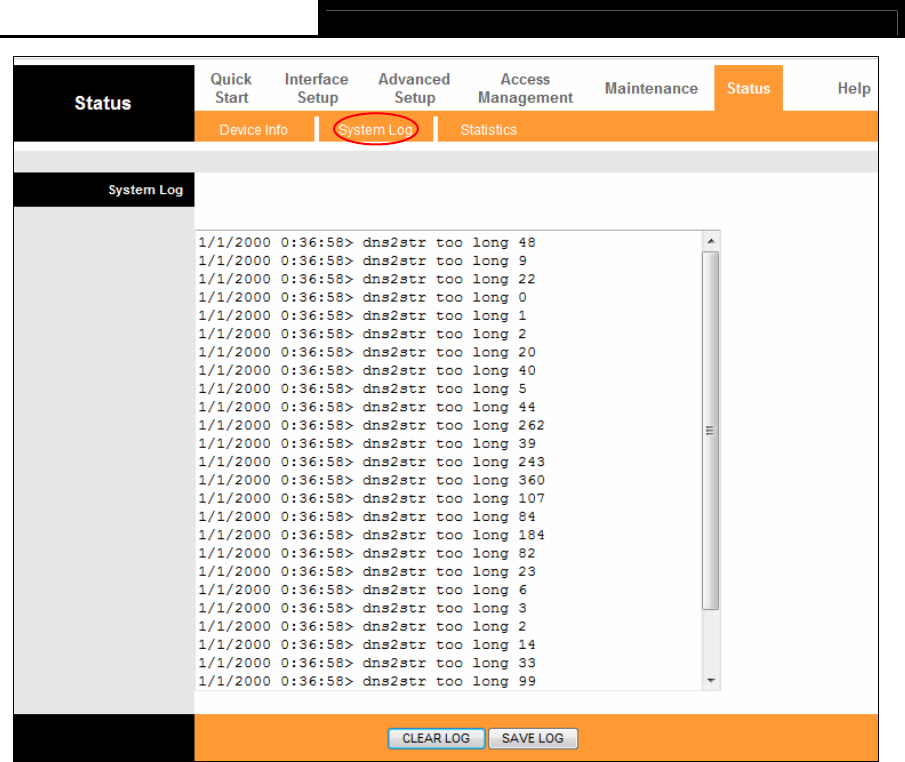
TD-W8961N 300Mbps Wireless N ADSL2+ Modem Router User Guide
16
Figure 4-3
The modem router can keep logs of all traffic. You can query the logs to find what happened to the
modem router.
Click the CLEAR LOG button to clear the logs.
Click the SAVE LOG button to save the logs.
4.1.3 Statistics
Choose “Status→Statistics” menu, and you will be able to view the network traffic over Ethernet,
ADSL and WLAN.
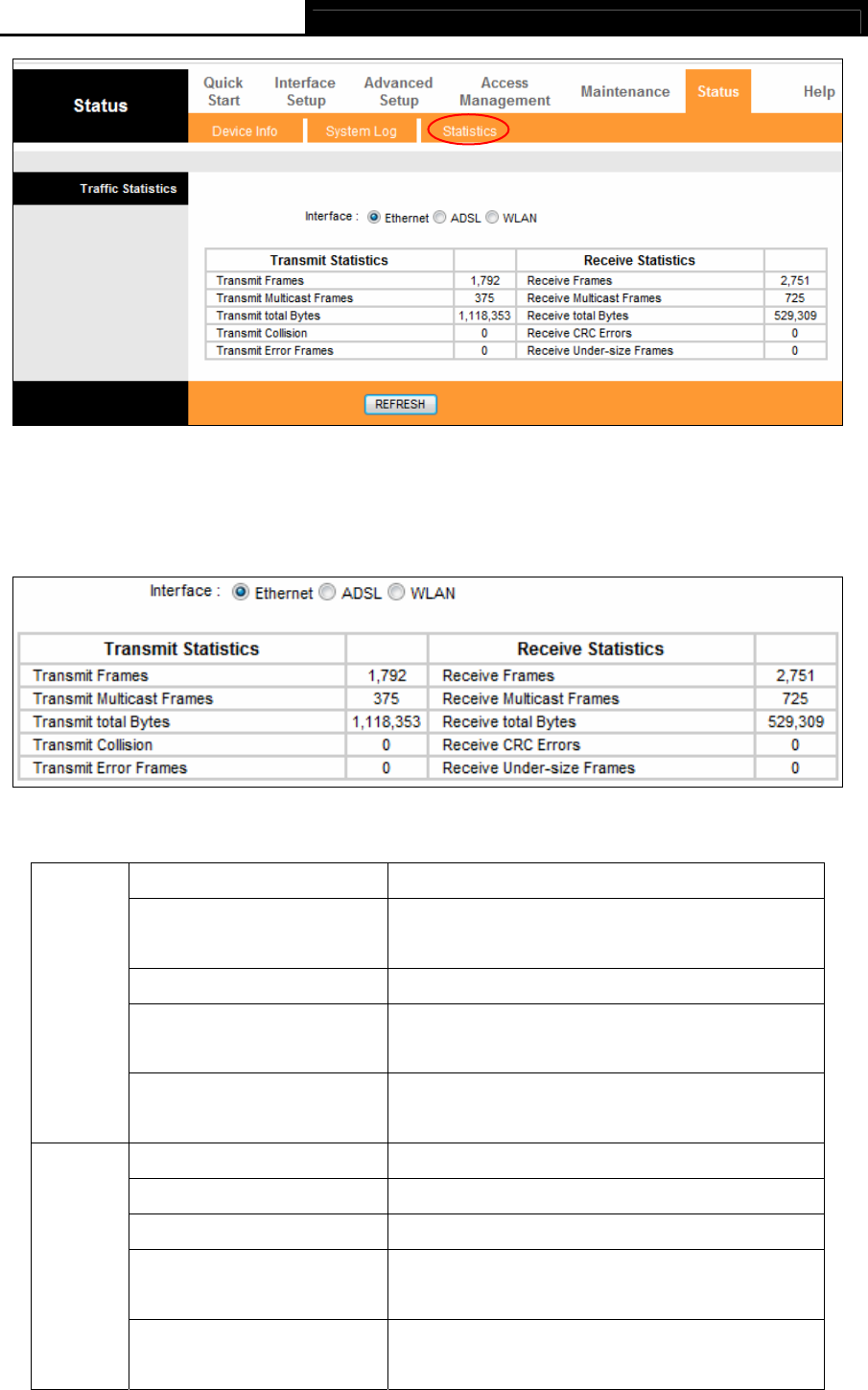
TD-W8961N 300Mbps Wireless N ADSL2+ Modem Router User Guide
17
Figure 4-4
Interface: You can select Ethernet, ADSL and WLAN to view the corresponding network
traffic over different ports.
Select Ethernet, and you will see the statistics table as below.
Statistics Table:
Transmit Frames The frames transmitted over the Ethernet port.
Transmit Multicast Frames
The multicast frames transmitted over the Ethernet
port.
Transmit total Bytes The total bytes transmitted over the Ethernet port.
Transmit Collision
The collision occurred over the Ethernet port when
data is being transmitted.
Transmit
Statistics
Transmit Error Frames
The error frames over the Ethernet port when data is
being transmitted.
Receive Frames The frames received over the Ethernet port.
Receive Multicast Frames The multicast frames received over the Ethernet port.
Receive total Bytes The total bytes received over the Ethernet port.
Receive CRC Errors
The CRC errors occurred over the Ethernet port when
data is being received.
Receive
Statistics
Receive Under-size Frames
The Under-size frames received over the Ethernet
port.
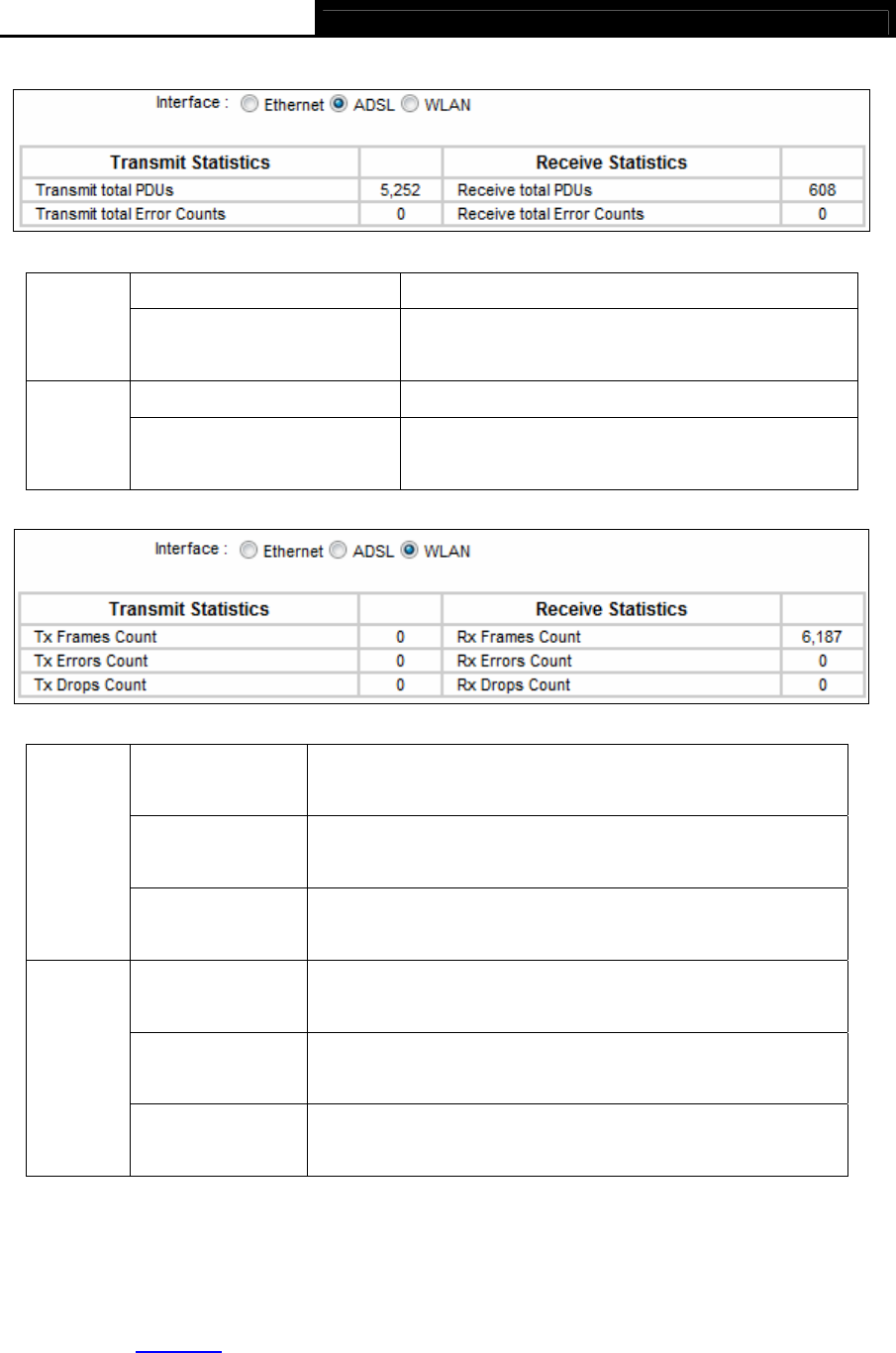
TD-W8961N 300Mbps Wireless N ADSL2+ Modem Router User Guide
18
Select ADSL, and you will see the statistics table as below.
Statistics Table:
Transmit total PDUs The total PDUs transmitted over the ADSL port.
Transmit
Statistics Transmit total Error Counts
The total errors occurred over the ADSL port when data
is being transmitted.
Receive total PDUs The total PDUs transmitted over the ADSL port.
Receive
Statistics Receive total Error Counts
The total errors occurred over the ADSL port when data
is being received.
Select WLAN, and you will see the statistics table as below.
Statistics Table:
Tx Frames Count
The frames transmitted over the WLAN when wireless data is
being transmitted.
Tx Errors Count
The errors occurred over the WLAN when wireless data is being
transmitted.
Transmit
Statistics
Tx Drops Count
The drops occurred over the WLAN when wireless data is being
transmitted.
Rx Frames Count
The frames received over the WLAN when wireless data is being
transmitted.
Rx Errors Count
The errors occurred over the WLAN when wireless data is being
received.
Receive
Statistics
Rx Drops Count
The drops occurred over the WLAN when wireless data is being
received.
Click the REFRESH button to refresh immediately.
4.2 Quick Start
Please refer to 3.2 Login.

TD-W8961N 300Mbps Wireless N ADSL2+ Modem Router User Guide
19
4.3 Interface Setup
Choose “Interface Setup”, you can see the following submenus: Internet, LAN, Wireless, 6RD,
Guest Network.
Figure 4-5
Click any of them, and you will be able to configure the corresponding function.
4.3.1 Internet
Choose “Interface Setup→Internet” menu, you can configure the parameters for WAN ports in
the following screen.
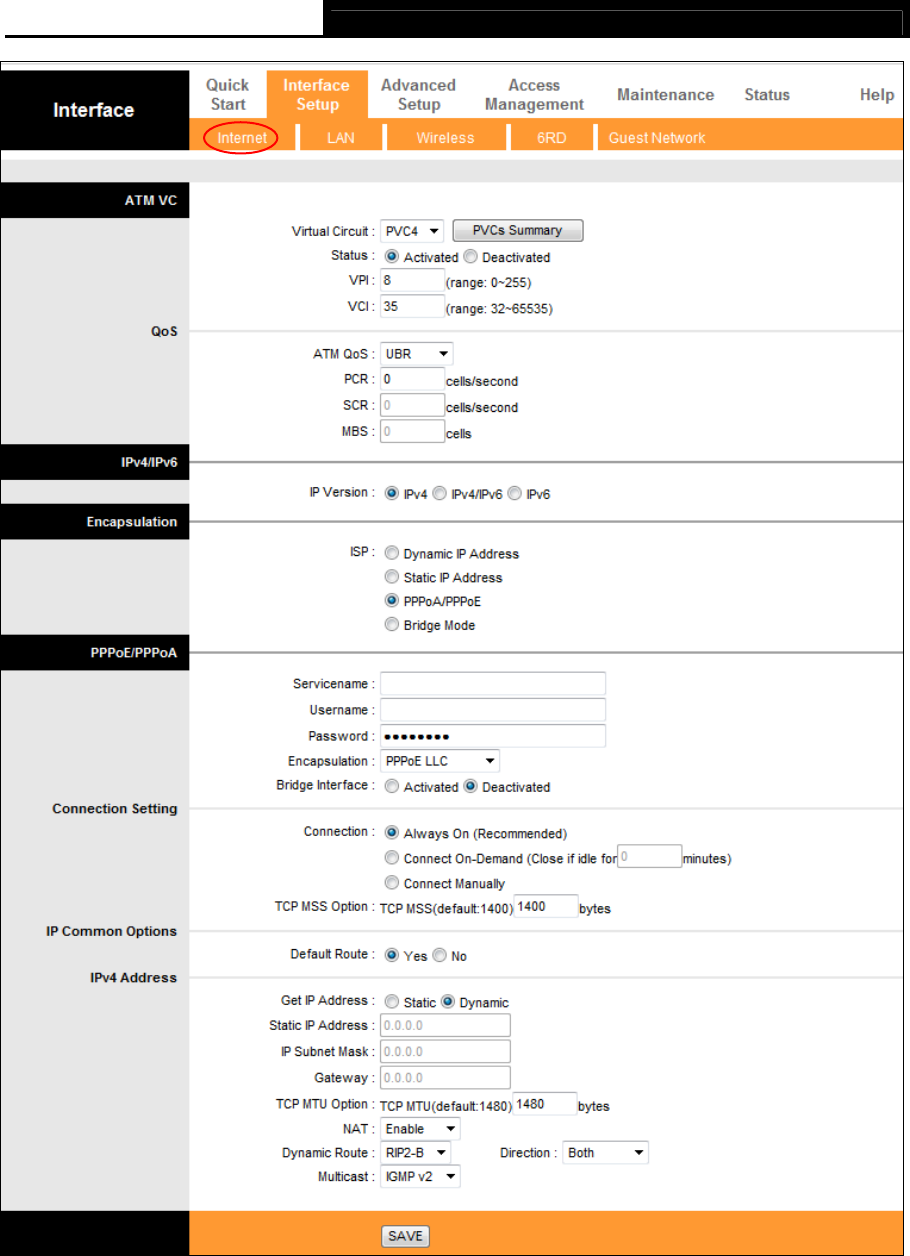
TD-W8961N 300Mbps Wireless N ADSL2+ Modem Router User Guide
20
Figure 4-6
ATM VC: ATM settings are used to connect to your ISP. Your ISP provides VPI (Virtual Path
Identifier), VCI (Virtual Channel Identifier) settings to you. In this Device, you can totally setup
8 VCs on different encapsulations, if you apply 8 different virtual circuits from your ISP. You
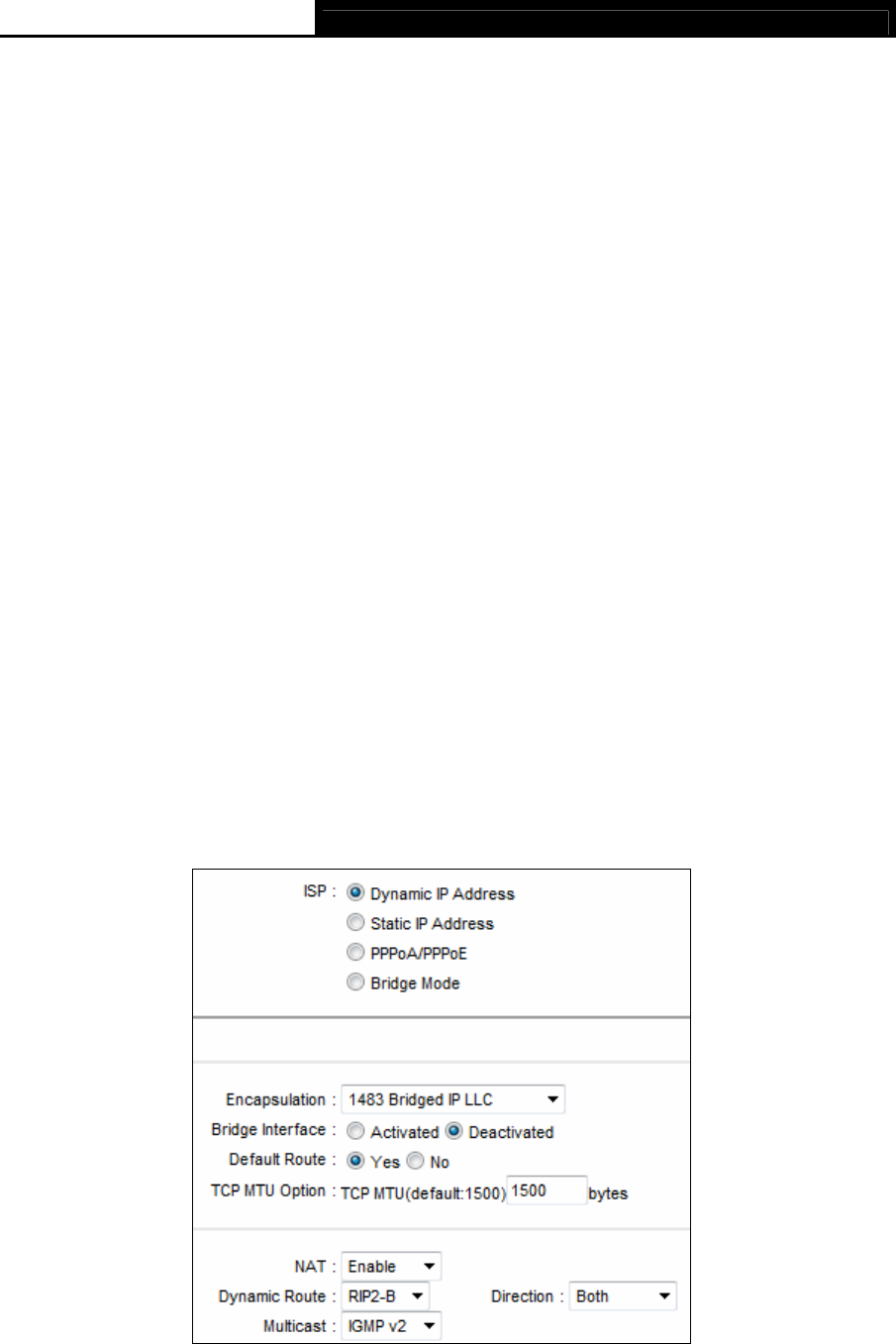
TD-W8961N 300Mbps Wireless N ADSL2+ Modem Router User Guide
21
need to activate the VC to take effect. For PVCs management, you can use ATM QoS to
setup each PVC traffic line's priority.
Virtual Circuit: Select the VC number you want to setup, PVC0~PVC7.
PVCs Summary: Click the button, and you can view the summary information about the
PVCs.
Status: If you want to use a designed VC, you should activate it.
VPI: Identifies the virtual path between endpoints in an ATM network. The valid range is
from 0 to 255. Please input the value provided by your ISP.
VCI: Identifies the virtual channel endpoints in an ATM network. The valid range is from
32 to 65535 (1 to 31 is reserved for well-known protocols). Please input the value
provided by your ISP.
QoS: Select the Quality of Service types for this Virtual Circuit, including CBR (Constant
Bit Rate), UBR (Unspecified Bit Rate) and VBR (Variable Bit Rate). These QoS types are
all controlled by the parameters specified below, including PCR (Peak Cell Rate), SCR
(Sustained Cell Rate) and MBS (Maximum Burst Size), please configure them according
to your needs.
IPv4/IPv6: Select the version of IP.
Encapsulation: There are four connection types: Dynamic IP Address, Static IP Address,
PPPoA/PPPoE and Bridge Mode. Please choose the designed type that you want to use.
After that, you should follow the configuration below to proceed.
1) Dynamic IP Address
Select this option if your ISP provides you an IP address automatically. This option is typically
used for Cable services. Please enter the Dynamic IP information accordingly.
Encapsulation: Select the encapsulation mode for the Dynamic IP Address, you can leave it
default.

TD-W8961N 300Mbps Wireless N ADSL2+ Modem Router User Guide
22
Default Route: If enable this function, the current PVC will be considered as the default
gateway to internet from this device.
TCP MTU Option: Enter the TCP MTU as your desire.
NAT: Select this option to Enable/Disable the NAT (Network Address Translation) function
for this VC. The NAT function can be activated or deactivated per PVC basis.
Dynamic Route: Select this option to specify the RIP (Routing Information protocol) version
for WAN interface, including RIP1, RIP2-B and RIP2-M. RIP2-B and RIP2-M are both sent in
RIP2 format, the difference is that RIP2-M using Multicast, while RIP2-B using Broadcast
format.
Direction: Select this option to specify the RIP direction. None is for disabling the RIP
function. Both means the ADSL modem router will periodically send routing information and
accept routing information, and then incorporate them into routing table. IN only means the
ADSL modem router will only accept but will not send RIP packet. OUT only means the
ADSL modem router will only send but will not accept RIP packet.
Multicast: Select IGMP version, or disable the function. IGMP (Internet Group Multicast
Protocol) is a session-layer protocol used to establish membership in a multicast group. The
ADSL ATU-R supports both IGMP version 1 (IGMP v1) and IGMP v2. Select “Disabled” to
disable it.
2) Static IP Address
Select this option if your ISP provides static IP information to you. You should set static IP
address, IP subnet mask, and gateway address in the screen below.
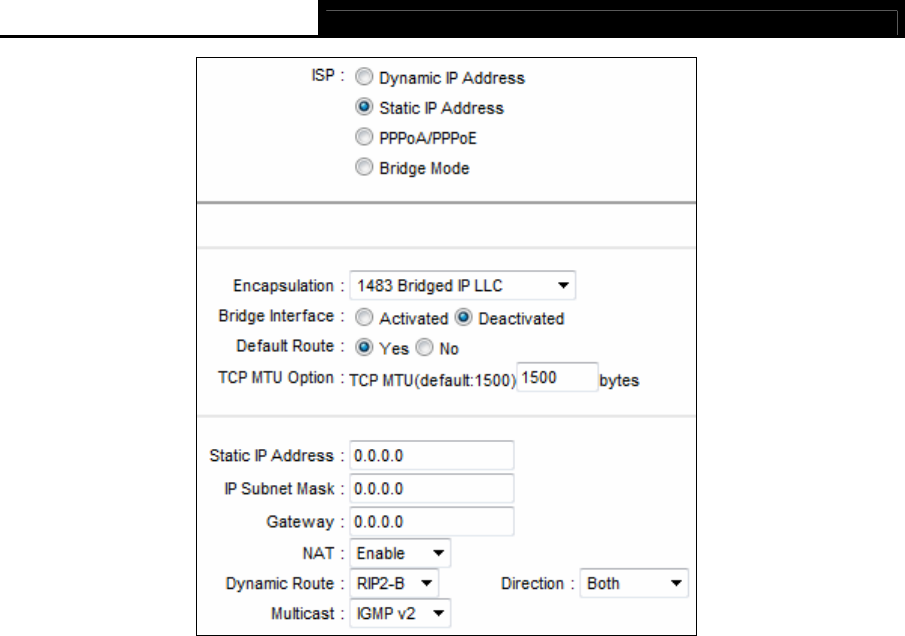
TD-W8961N 300Mbps Wireless N ADSL2+ Modem Router User Guide
23
Note:
Each IP address entered in the fields must be in the appropriate IP form, which is four IP octets
separated by a dot (x.x.x.x), such as 192.168.1.100. The modem router will not accept the IP
address if it is not in this format.
3) PPPoA/PPPoE
Select this option if your ISP requires you to use a PPPoE connection. This option is typically
used for DSL services. Select Dynamic PPPoE to obtain an IP address automatically for your
PPPoE connection. Select Static PPPoE to use a static IP address for your PPPoE connection.
Please enter the information accordingly.
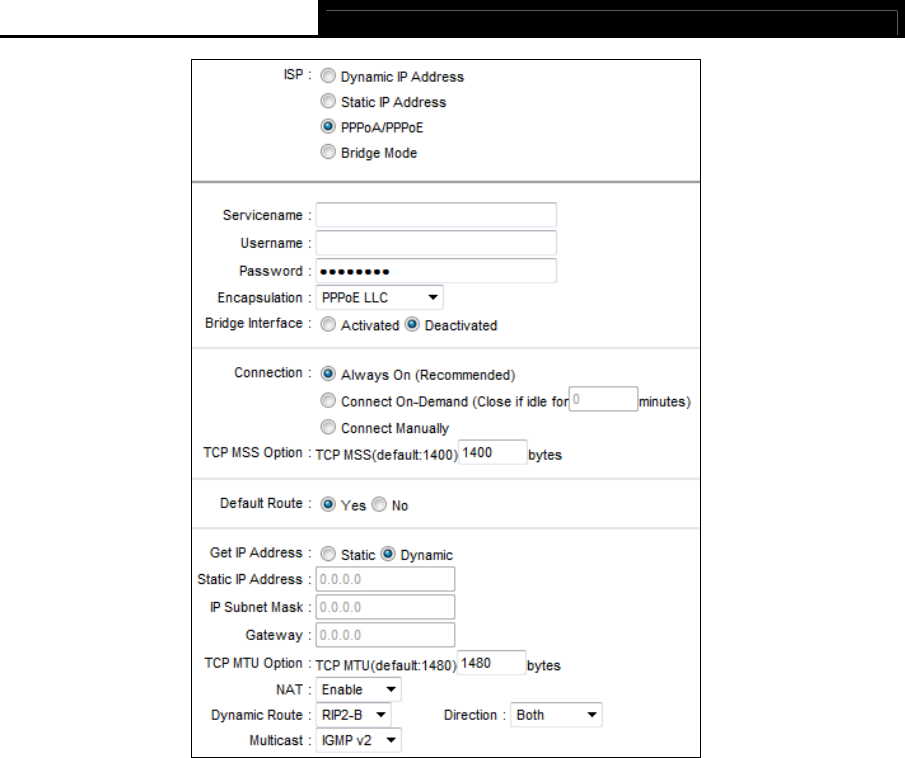
TD-W8961N 300Mbps Wireless N ADSL2+ Modem Router User Guide
24
Servicename: Enter a name to mark current connection, or you can leave it blank.
Username: Enter your username for your PPPoA/PPPoE connection.
Password: Enter your password for your PPPoA/PPPoE connection.
Encapsulation: For both PPPoA/PPPoE connection, you need to specify the type of
Multiplexing, either LLC or VC Mux.
Bridge Interface: Activate the option, and the modem router can also work in Bridge mode.
Connection: For PPPoA/PPPoE connection, you can select Always on or Connect
on-Demand or Connect Manually. Connect on demand is dependent on the traffic. If there
is no traffic (or Idle) for a pre-specified period of time), the connection will tear down
automatically. And once there is traffic send or receive, the connection will be automatically
on.
Default Route: You should select Yes to configure the PVC as the default gateway to
internet from this device.
Get IP Address: Select Static or Dynamic. For PPPoA/PPPoE connection, you need to
specify the public IP address for this ADSL modem router. The IP address can be either
dynamically (via DHCP) or given IP address provided by your ISP. For Static IP, you need to
specify the IP address, Subnet Mask and Gateway IP address.
4) Bridge Mode
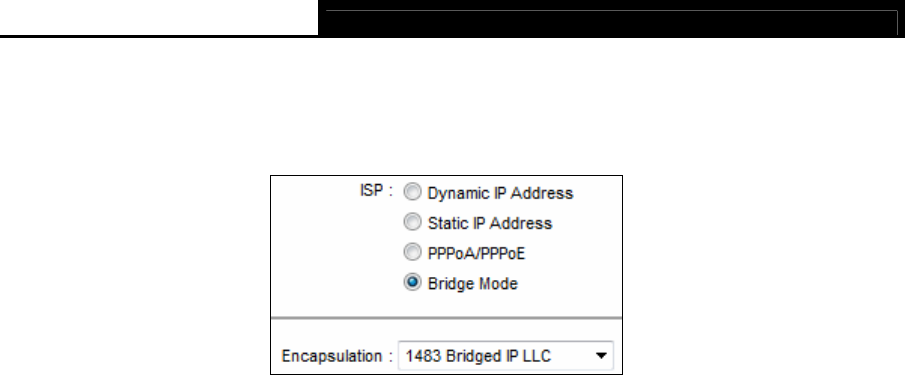
TD-W8961N 300Mbps Wireless N ADSL2+ Modem Router User Guide
25
If you select this type of connection, the modem can be configured to act as a bridging device
between your LAN and your ISP. Bridges are devices that enable two or more networks to
communicate as if they are two segments of the same physical LAN.
Note:
After you finish the Internet configuration, please click SAVE to make the settings take effect.
4.3.2 LAN
Choose “Interface Setup→LAN” menu, and you will see the LAN screen. Please configure the
parameters for LAN ports according to the descriptions below.
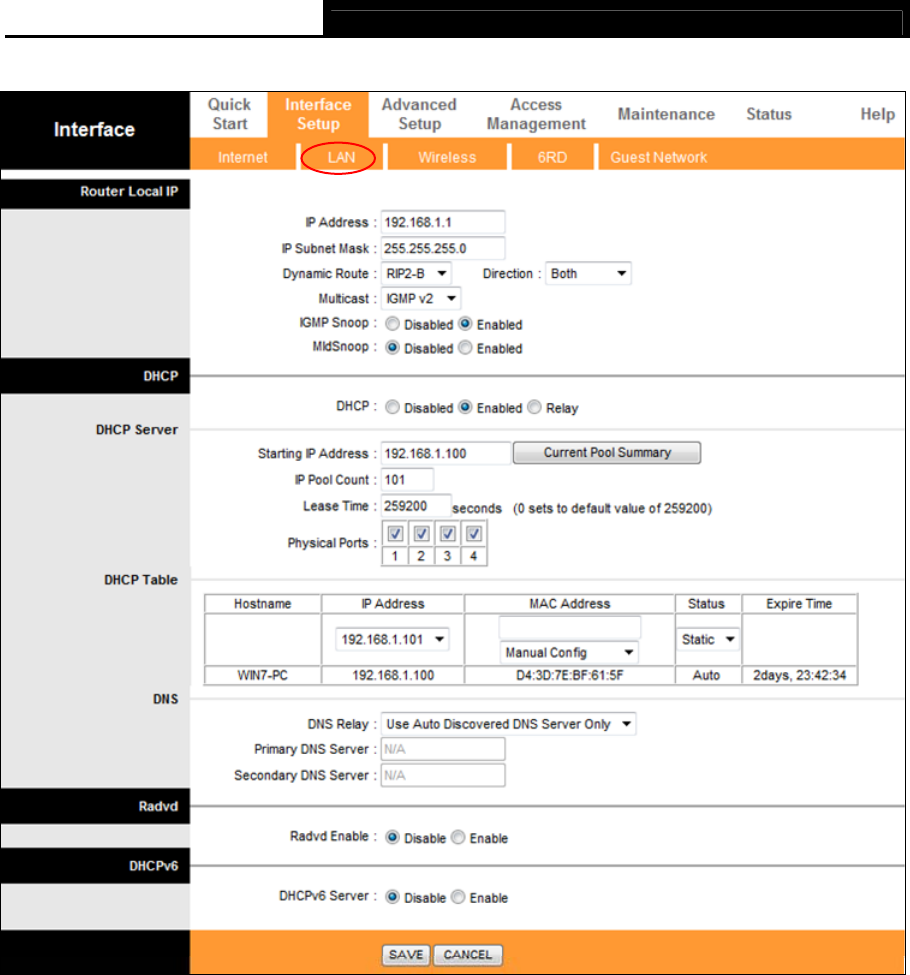
TD-W8961N 300Mbps Wireless N ADSL2+ Modem Router User Guide
26
Figure 4-7
Router Local IP: These are the IP settings of the LAN interface for the device. These
settings may be referred to as Private settings. You may change the LAN IP address if
needed. The LAN IP address is private to your internal network and cannot be seen on the
Internet.
IP Address: Enter the modem router’s local IP Address, then you can access to the
Web-based Utility via the IP Address, the default value is 192.168.1.1.
IP Subnet Mask: Enter the modem router’s Subnet Mask, the default value is
255.255.255.0.
Dynamic Route: Select this option to specify the RIP (Routing Information protocol)
version for LAN interface, including RIP1, RIP2-B and RIP2-M. RIP2-B and RIP2-M are
both sent in RIP2 format, the difference is that RIP2-M using Multicast, while RIP2-B
using Broadcast format.

TD-W8961N 300Mbps Wireless N ADSL2+ Modem Router User Guide
27
Direction: Select this option to specify the RIP direction. None is for disabling the RIP
function. Both means the ADSL modem router will periodically send routing information
and accept routing information, and then incorporate them into routing table. IN only
means the ADSL modem router will only accept but will not send RIP packet. OUT only
means the ADSL modem router will only send but will not accept RIP packet.
Multicast: Select IGMP version, or disable the function. IGMP (Internet Group Multicast
Protocol) is a session-layer protocol used to establish membership in a multicast group.
The ADSL ATU-R supports both IGMP version 1 (IGMP v1) IGMP v2 and IGMP v3.
Select “Disabled” to disable it.
IGMP Snoop: Enable the IGMP Snoop function if you need.
Mld Snoop: Enable the Mld Snoop function if you need.
DHCP: Select Enabled, then you will see the screen below. The modem router will work as a
DHCP Server; it becomes the default gateway for DHCP client connected to it. DHCP stands
for Dynamic Host Control Protocol. The DHCP Server gives out IP addresses when a device
is booting up and request an IP address to be logged on to the network. That device must be
set as a DHCP client to obtain the IP address automatically. By default, the DHCP Server is
enabled. The DHCP address pool contains the range of the IP address that will automatically
be assigned to the clients on the network.
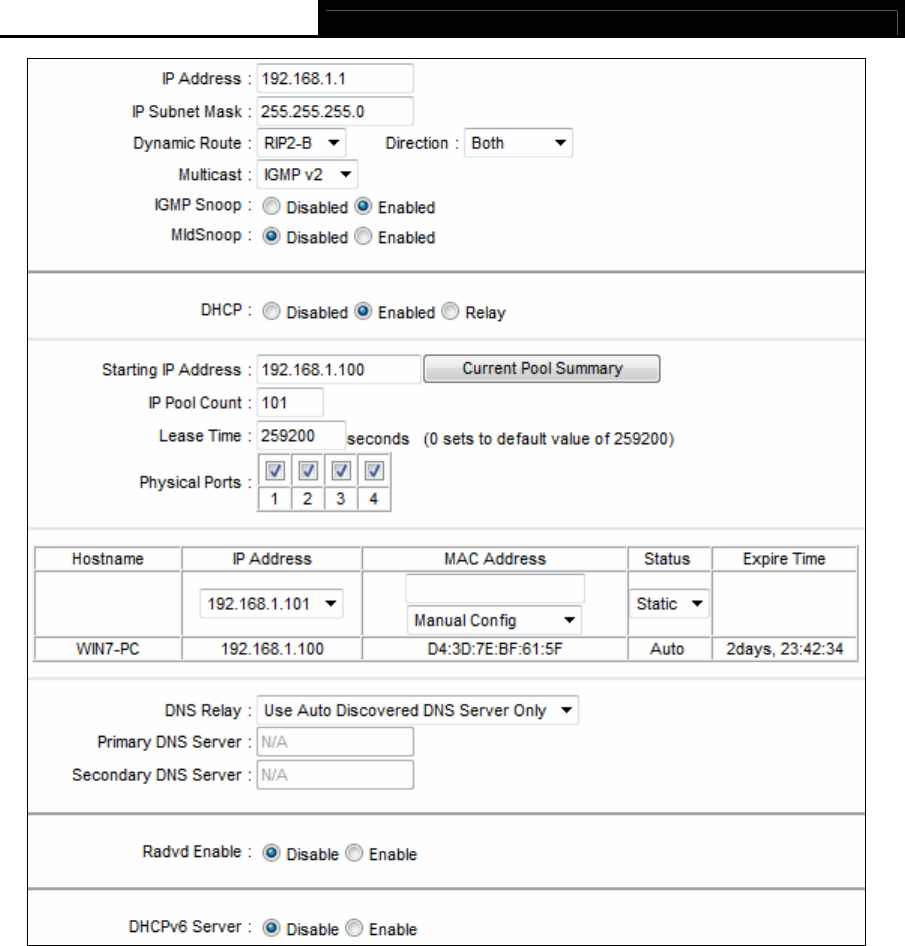
TD-W8961N 300Mbps Wireless N ADSL2+ Modem Router User Guide
28
Starting IP Address: Enter the starting IP address for the DHCP server's IP assignment.
Because the default IP address for the modem router is 192.168.1.1, the default Start IP
Address is 192.168.1.100.
IP Pool Count: The max user pool size.
Lease Time: The length of time for the IP lease. After the dynamic IP address has
expired, the user will be automatically assigned a new dynamic IP address. The default
is 259200 seconds.
Physical Ports: If a physical port is unchecked, the client connected to that port will not
be able to obtain IP address automatically although the DHCP function is enabled. All
the ports are checked by default.
DHCP Table: The information of the DHCP clients will be displayed here
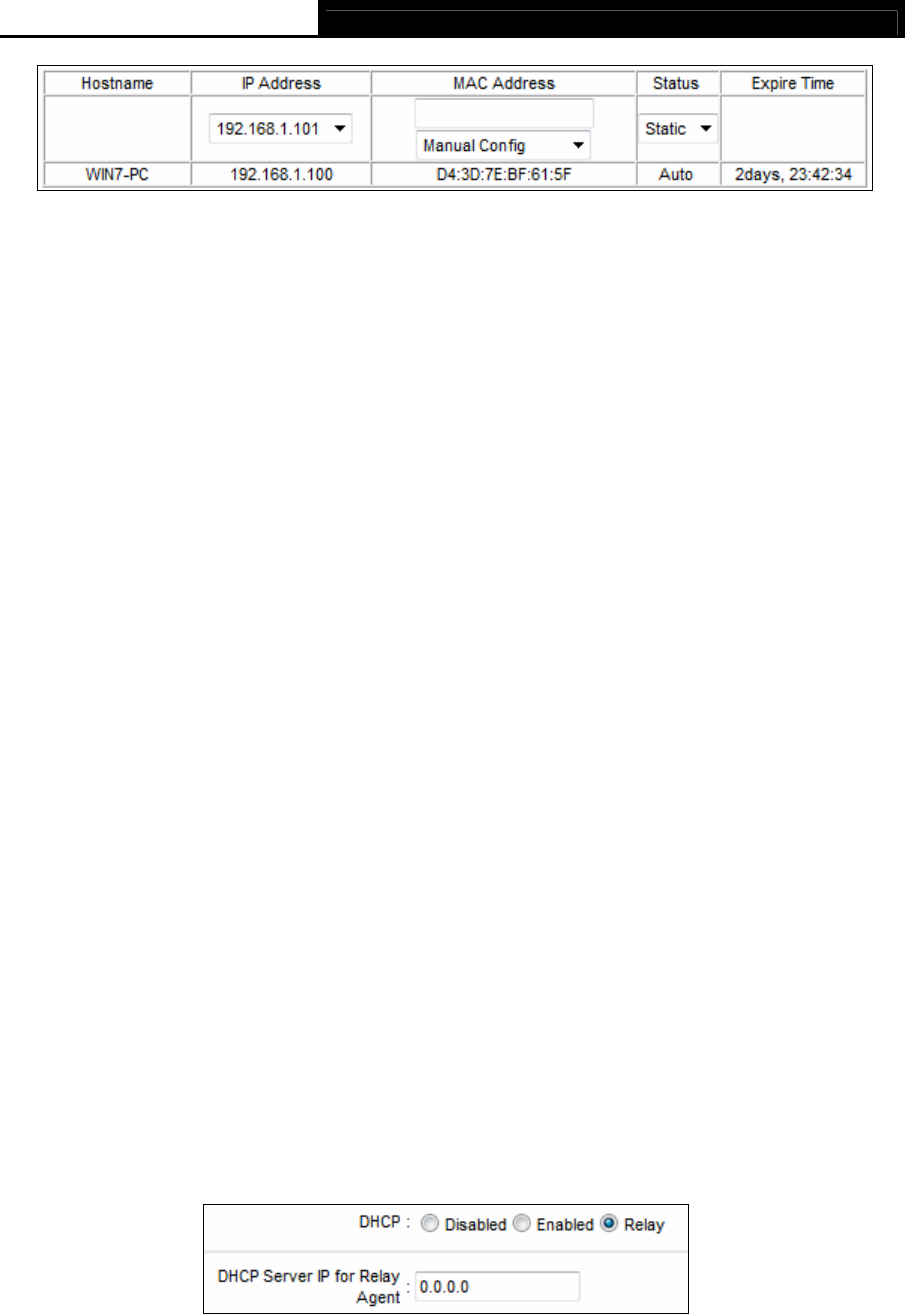
TD-W8961N 300Mbps Wireless N ADSL2+ Modem Router User Guide
29
Hostname: Display the name of the DHCP client.
IP Address: Display the IP Address of the DHCP client.
MAC Address: Display the MAC Address of the DHCP client.
Status: Display the status of the assigned IP Address, either Static or Auto. Static
indicates that the IP Address is bounded to the MAC Address, while Auto indicates that
the IP Address is assigned to the MAC Address automatically.
How to assign a static IP address to the client?
1). Select an IP Address from the drop-down list.
2). Enter the MAC Address of the client in the table.
DNS Relay: If you want to disable this feature, you just need to set both Primary and
secondary DNS IP to 0.0.0.0. If you want to use DNS relay, you can setup DNS server IP
to 192.168.1.1 on their Computer. If not, the device will perform as no DNS relay.
Primary DNS Server: Type in your preferred DNS server.
Secondary DNS Server: Type in your preferred DNS server.
Note:
If Use Auto Discovered DNS Server Only is selected in DNS Relay, this modem router will
accept the first received DNS assignment from one of the PPPoA, PPPoE or MER/DHCP enabled
PVC(s) during the connection establishment. If Use User Discovered DNS Server Only is
selected in DNS Relay, it is necessary for you to enter the primary and optional secondary DNS
server IP addresses. After type in the address, click SAVE button to save it and invoke it.
DHCP Relay: Select Relay, then you will see the following screen, and the modem router will
work as a DHCP Relay. A DHCP relay is a computer that forwards DHCP data between
computers that request IP addresses and the DHCP server that assigns the addresses. Each
of the device's interfaces can be configured as a DHCP relay. If it is enabled, the DHCP
requests from local PCs will forward to the DHCP server runs on WAN side. To have this
function working properly, please run on router mode only, disable the DHCP server on the
LAN port, and make sure the routing table has the correct routing entry.
DHCP Server IP for Relay Agent: Enter the DHCP server IP Address runs on WAN
side.

TD-W8961N 300Mbps Wireless N ADSL2+ Modem Router User Guide
30
Note:
If you select Disabled, the DHCP function will not take effect.
4.3.3 Wireless
Choose “Interface Setup→Wireless” menu, and you will see the Wireless screen. Please
configure the parameters for wireless according to the descriptions below.
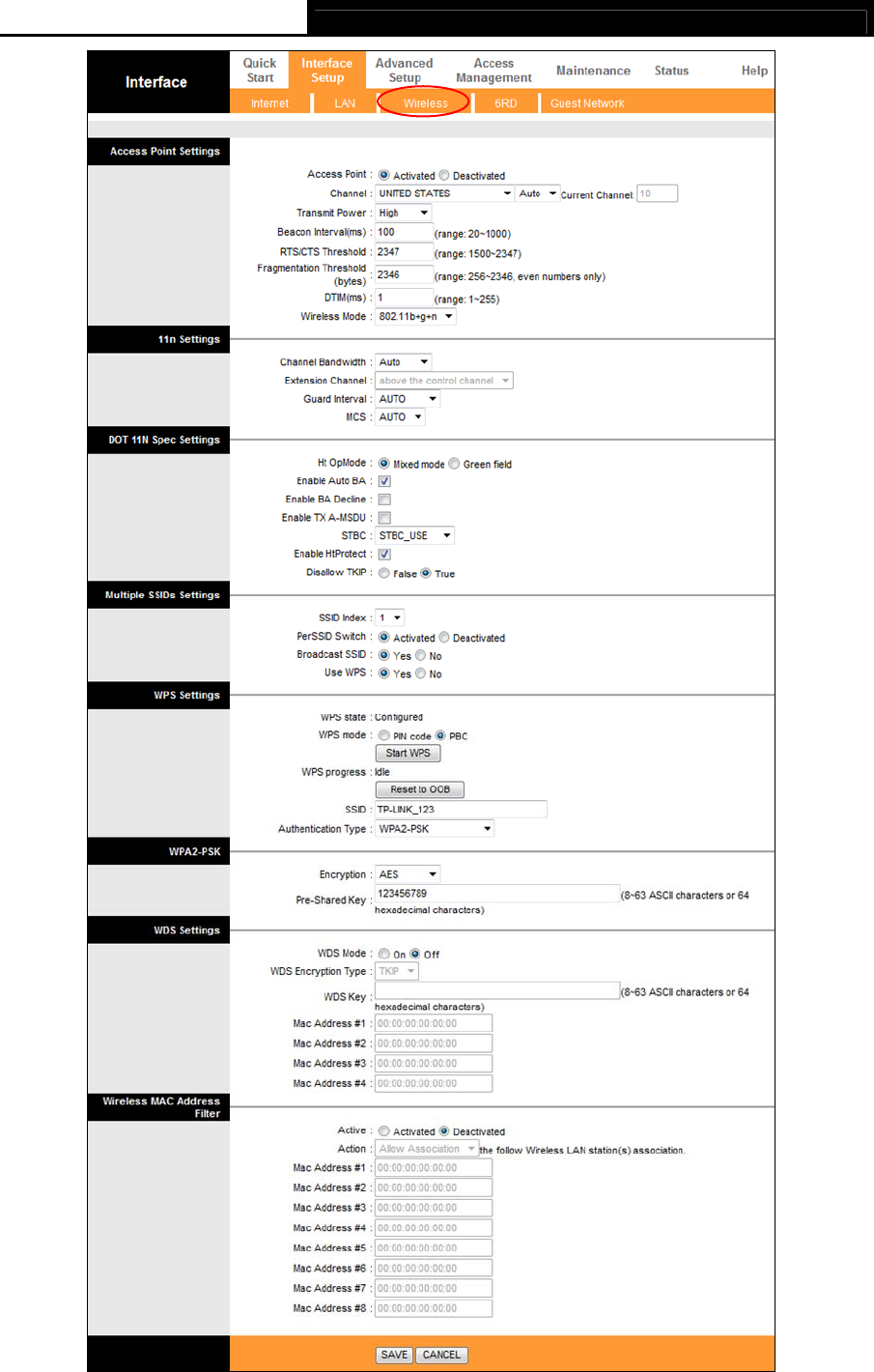
TD-W8961N 300Mbps Wireless N ADSL2+ Modem Router User Guide
31
Figure 4-8

TD-W8961N 300Mbps Wireless N ADSL2+ Modem Router User Guide
32
Access point Settings: These are the settings of the access point. You can configure the
rules to allow wireless-equipped computers and other devices to communicate with a
wireless network.
Access point: Select Activated to allow wireless station to associate with the access
point.
Channel: Select the channel you want to use from the drop-down List of Channel. This
field determines which operating frequency will be used. It is not necessary to change
the wireless channel unless you notice interference problems with another nearby
access point.
Note:
Per FCC regulations, all Wi-Fi products marketed in the U.S. must be fixed to the U.S.
region only.
Transmit Power: Here you can specify the transmit power of modem router. You can
select High, Medium or Low which you would like. High is the default setting and is
recommended.
Beacon Interval: Enter a value between 20-1000 milliseconds. The Beacon Interval
value indicates the frequency interval of the beacon. A beacon is a packet broadcast by
the modem router to synchronize the wireless network. The default value is 100.
RTS/CTS Threshold: Should you encounter inconsistent data flow, only minor reduction
of the default value 2347 is recommended. If a network packet is smaller than the preset
RTS threshold size, the RTS/CTS mechanism will not be enabled. The modem router
sends Request to Send (RTS) frames to a particular receiving station and negotiates the
sending of a data frame. After receiving an RTS, the wireless station responds with a
Clear to Send (CTS) frame to acknowledge the right to begin transmission. In most
cases, keep its default value of 2347.
Fragmentation Threshold: This value specifies the maximum size for a packet before
data is fragmented into multiple packets. If you experience a high packet error rate, you
may slightly increase the Fragmentation Threshold. Setting the Fragmentation Threshold
too low may result in poor network performance. Only minor reduction of the default
value is recommended. In most cases, it should remain at its default value of 2346.
DTIM: This value, between 1 and 255, indicates the interval of the Delivery Traffic
Indication Message (DTIM). A DTIM field is a countdown field informing clients of the
next window for listening to broadcast and multicast messages. When the modem router
has buffered broadcast or multicast messages for associated clients, it sends the next
DTIM with a DTIM Interval value. Its clients hear the beacons and awaken to receive the
broadcast and multicast messages. The default value is 1.
Wireless Mode: In the drop-down list you can select “802.11b”, “802.11g”, “802.11n”,
“802.11b+g”, “802.11g+n” and “802.11b+g+n”. “802.11b+g+n” allows both 802.11b,
802.11g and 802.11n wireless stations to connect to the modem router.

TD-W8961N 300Mbps Wireless N ADSL2+ Modem Router User Guide
33
11n Settings: These are the settings of the 11n parameters. If “802.11n”, “802.11g+n” or
“802.11b+g+n” is selected for Wireless mode, these settings will be displayed.
Channel Bandwidth: Select the Bandwidth you want to use from the drop-down List.
There are two options, “20 MHz” and “20/40 MHz”. If bigger bandwidth is selected,
device could transmit and receive data with higher speed.
Extension Channel: If “20/40 MHz” is selected, this option will be displayed.
Guard Interval: Select the guard interval you want from the drop-down list.
MCS: Select the wireless transmission rate from the drop-down list. By default, the
option is AUTO.
DOT 11N Spec Settings: These are the settings of the DOT 11N Spec.
Ht OpMode: HT operation mode.
Enable Auto BA: Enable or disable auto block ack setion with peer.
Enable BA Decline: Enable or disable decline block ack to peer.
Enable TX A-MSDU: Enable or disable AMSDU section.
STBC: Enable or disable HT STBC support.
Enable HtProtect: Enable or disable HT protect.
Disallow TKP: Enable or disable 11n rate with 11n AP when cipher is TKIP or WEP.
Multiple SSIDs Settings: These are the settings of the SSID.
SSID Index: The index of the SSID, and in this model, you can only leave it as a default
value of 1.
Broadcast SSID: When wireless clients survey the local area for wireless networks to
associate with, they will detect the SSID broadcast by the modem router. To broadcast
the modem router’s SSID, keep the default setting. If you don’t want to broadcast the
modem router’s SSID, select “No”.
Use WPS: Use WPS (Wi-Fi Protected Setup) function, you can add a new wireless
device to an existing network quickly. To Use WPS, keep the default setting, and
configure the parameters in WPS Settings. If you don’t want to Use WPS, select “No”.
WPS Settings: WPS can help you to add a new wireless device to an existing network
quickly. This section will guide you how to use WPS function.
WPS state: Display the current WPS state.
WPS mode: If the wireless adapter supports Wi-Fi Protected Setup (WPS), you can
establish a wireless connection between wireless adapter and modem router using
either PIN method or Push Button Configuration (PBC) method, please select the one
you want.
1) PIN code
If the wireless adapter supports Wi-Fi Protected Setup and the PIN method, you can add it to
the network by PIN with the following two methods. Select PIN code, you will see the
following screen.
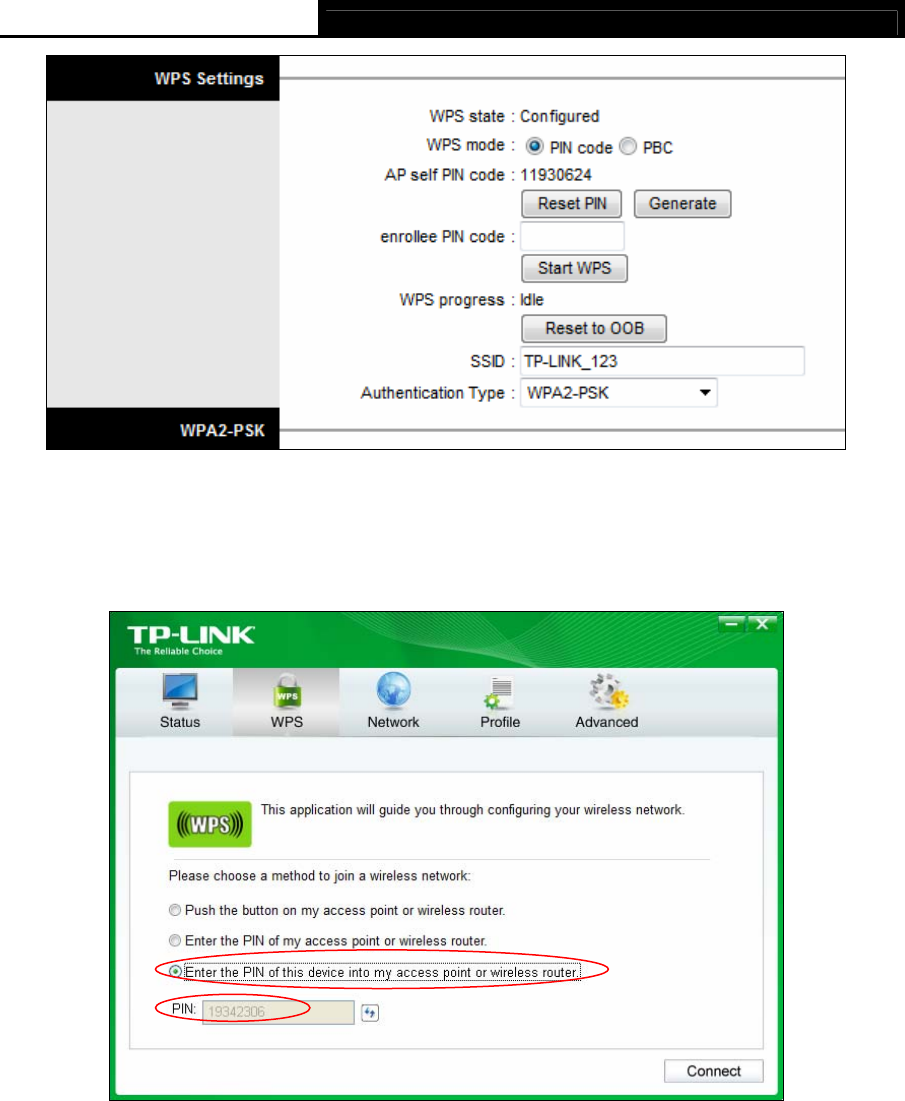
TD-W8961N 300Mbps Wireless N ADSL2+ Modem Router User Guide
34
Method One: Enter the PIN into my modem router
Step 1: For the configuration of the wireless adapter, please choose “Enter the PIN of this
device into my access point or wireless router” in the configuration utility, and
get the PIN code on the screen as below, then click Connect.
The WPS Configuration Screen of Wireless Adapter
Step 2: For the modem router, keep PIN code selected and enter the PIN code of the
wireless adapter in the field next to enrollee PIN code as shown below. Then click
Start WPS.
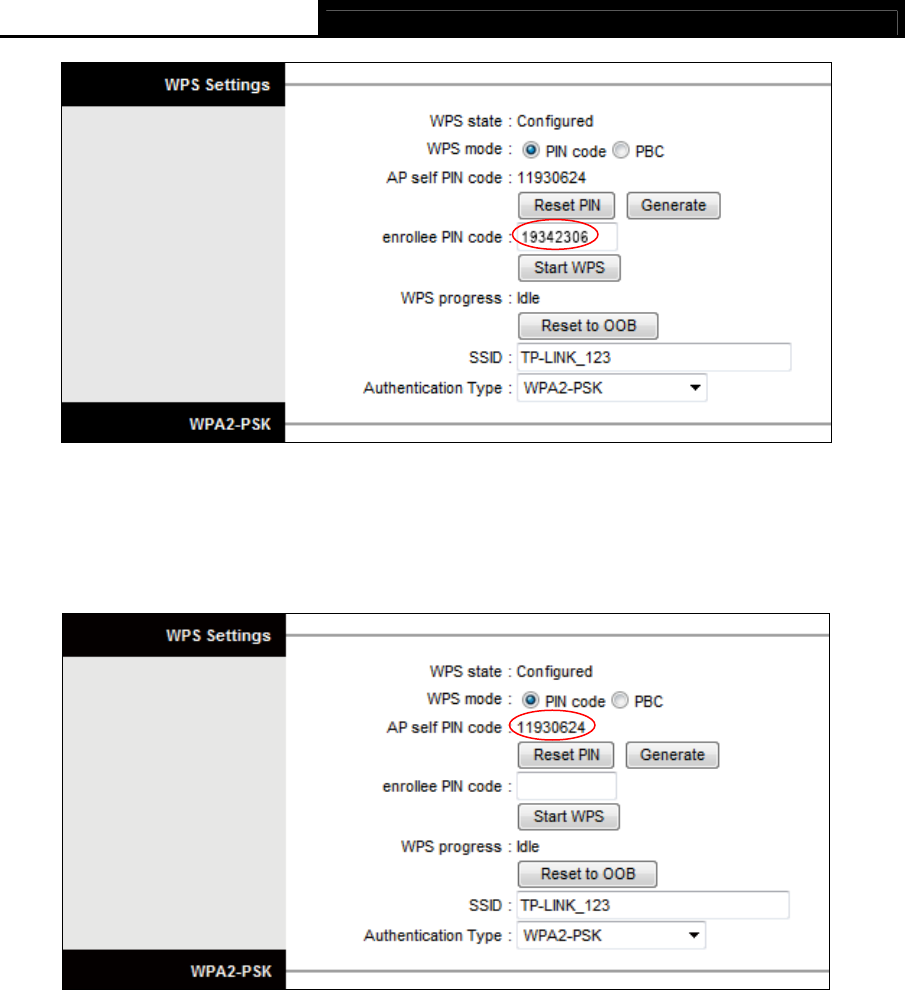
TD-W8961N 300Mbps Wireless N ADSL2+ Modem Router User Guide
35
Method Two: Enter the PIN from your Router or AP device
Step 1: Get the Current PIN code of your modem router from AP self PIN code (each
modem router has its unique PIN code. Here takes the PIN code 11930624 of this
modem router for example).
Step 2: For the configuration of the wireless adapter, please choose “Enter the PIN of my
access point or wireless router” in the configuration utility, and enter the PIN code
of the modem router into the field next to “PIN”. Then click Connect.
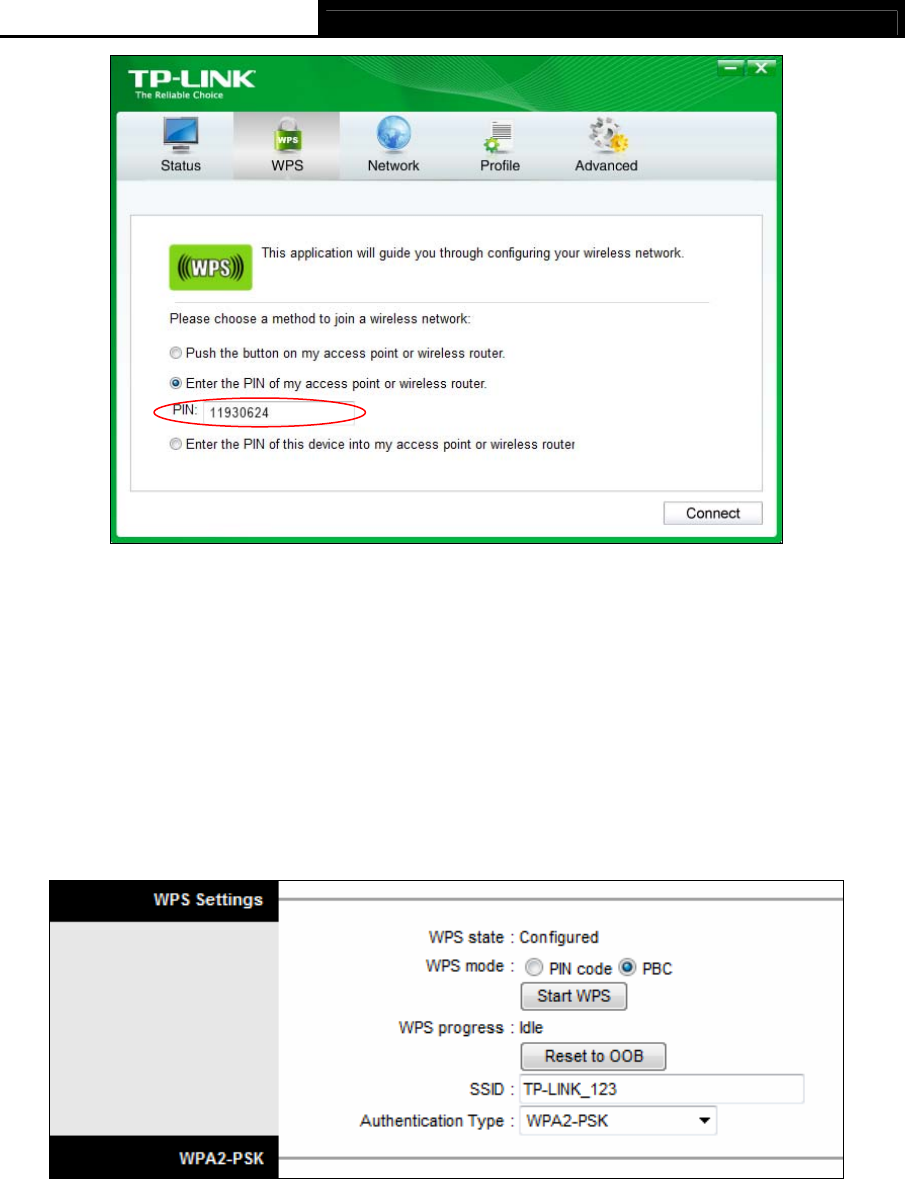
TD-W8961N 300Mbps Wireless N ADSL2+ Modem Router User Guide
36
The WPS Configuration Screen of Wireless Adapter
Note:
The default PIN code of the modem router can be found in its label or the WPS screen in its
web configuration page.
2) PBC
If the wireless adapter supports Wi-Fi Protected Setup and the Push Button Configuration
(PBC) method, you can add it to the network by PBC with the following two methods. Select
PBC, you will see the following screen.
Method One:
Step 1: Press the WPS/RESET button on your modem router for about 2 seconds or click
the Start WPS button on the screen.
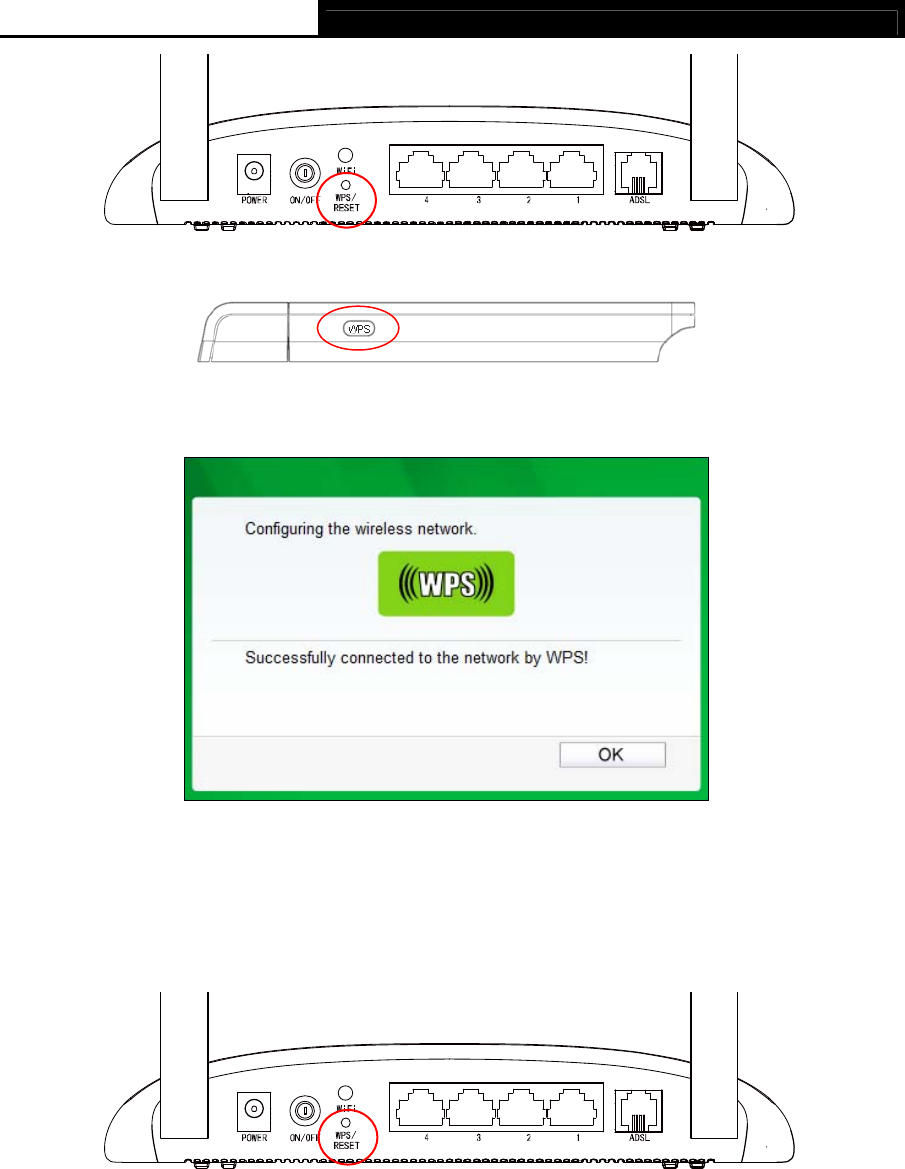
TD-W8961N 300Mbps Wireless N ADSL2+ Modem Router User Guide
37
LAN LAN LAN LAN
Step 2: Press and hold the WPS button of the adapter directly for about 2 seconds.
Step 3: Wait until the following screen appears. Click OK to complete the WPS
configuration.
The WPS Configuration Screen of Wireless Adapter
Method Two:
Step 1: Press the WPS/RESET button on your modem router for about 2 seconds or click
Start WPS button on the screen.
LAN LAN LAN LAN
Step 2: For the configuration of the wireless adapter, please choose “Push the button on
my access point or wireless router” in the configuration utility as below, and click
Connect.
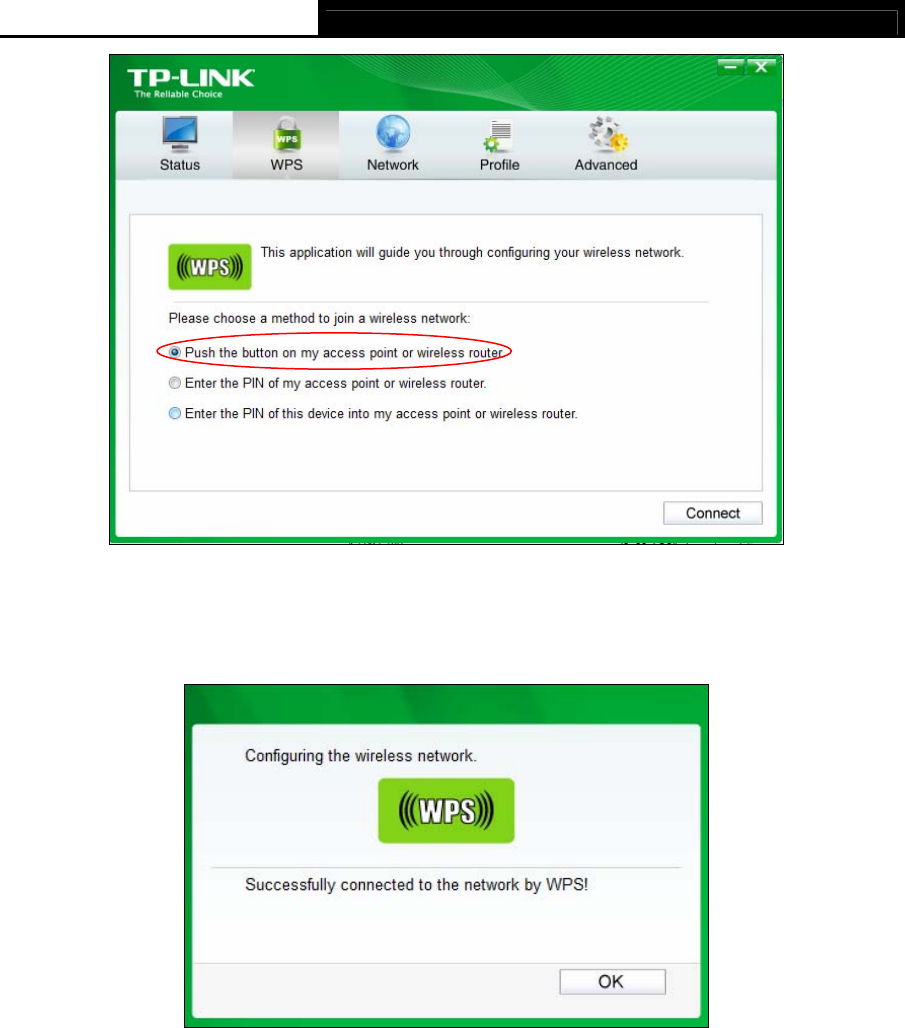
TD-W8961N 300Mbps Wireless N ADSL2+ Modem Router User Guide
38
The WPS Configuration Screen of Wireless Adapter
Step 3: Wait for a while until the following screen appears. Click OK to complete the WPS
configuration.
The WPS Configuration Screen of Wireless Adapter
WPS progress: Show the current WPS progress.
Reset to OOB: Reset WPS AP to the OOB(out-of-box) configuration.
SSID: Wireless network name shared among all points in a wireless network. The SSID
must be identical for all devices in the wireless network. It is case-sensitive and must not
exceed 32 characters (use any of the characters on the keyboard). Make sure this
setting is the same for all stations in your wireless network. Type the desired SSID in the
space provided.
Authentication Type: Select an authentication type from the drop-down list, which
allows you to configure security features of the wireless LAN interface. Options available

TD-W8961N 300Mbps Wireless N ADSL2+ Modem Router User Guide
39
are: Disabled, WEP-64Bits, WEP-128Bits, WPA-PSK, WPA2-PSK, and WPA-PSK/
WPA2-PSK.
1) WEP- 64Bits
To configure WEP-64Bits settings, select the WEP-64Bits option from the drop-down list. The
menu will change to offer the appropriate settings. WEP-64Bits is a data privacy mechanism
based on a 64-bit shared key algorithm, as described in the IEEE 802.11g standard.
2) WEP-128Bits
To configure WEP-128Bits settings, select the WEP-128Bits option from the drop-down list.
The menu will change to offer the appropriate settings. 128-bit is stronger than 64-bit.
3) WPA-PSK
To configure WPA-PSK settings, select the WPA-PSK option from the drop-down list. The
menu will change to offer the appropriate settings. WPA-PSK requires a shared key and does
not use a separate server for authentication. PSK keys can be ASCII or Hex type.
Encryption: Select the encryption you want to use: TKIP/AES, TKIP or AES (AES is an
encryption method stronger than TKIP).
TKIP (Temporal Key Integrity Protocol) - a wireless encryption protocol that provides
dynamic encryption keys for each packet transmitted.
AES (Advanced Encryption Standard) - A security method that uses symmetric
128-bit block data encryption.
Pre-Shared Key: Enter the key shared by the modem router and your other network
devices. It must have 8-63 ASCII characters or 64 Hexadecimal digits.
4) WPA2-PSK
To configure WPA2-PSK settings, select the WPA2-PSK option from the drop-down list. The
menu will change to offer the appropriate settings. WPA2-PSK requires a shared key and
does not use a separate server for authentication. PSK keys can be ASCII or Hex type.
5) WPA-PSK/WPA2-PSK
To configure WPA-PSK/WPA2-PSK settings, select the WPA-PSK/WPA2-PSK option from
the drop-down list. The menu will change to offer the appropriate settings.
WPA-PSK/WPA2-PSK requires a shared key and does not use a separate server for
authentication. PSK keys can be ASCII or Hex type. WPA-PSK/WPA2-PSK is more flexible
than WPA-PSK or WPA2-PSK.
WDS Settings: With this function enabled, the modem router can bridge two or more
WLANs.
WDS Mode: Select On/Off to enable/disable WDS.
MAC Address: Enter the MAC Address you wish to bridge in the field.
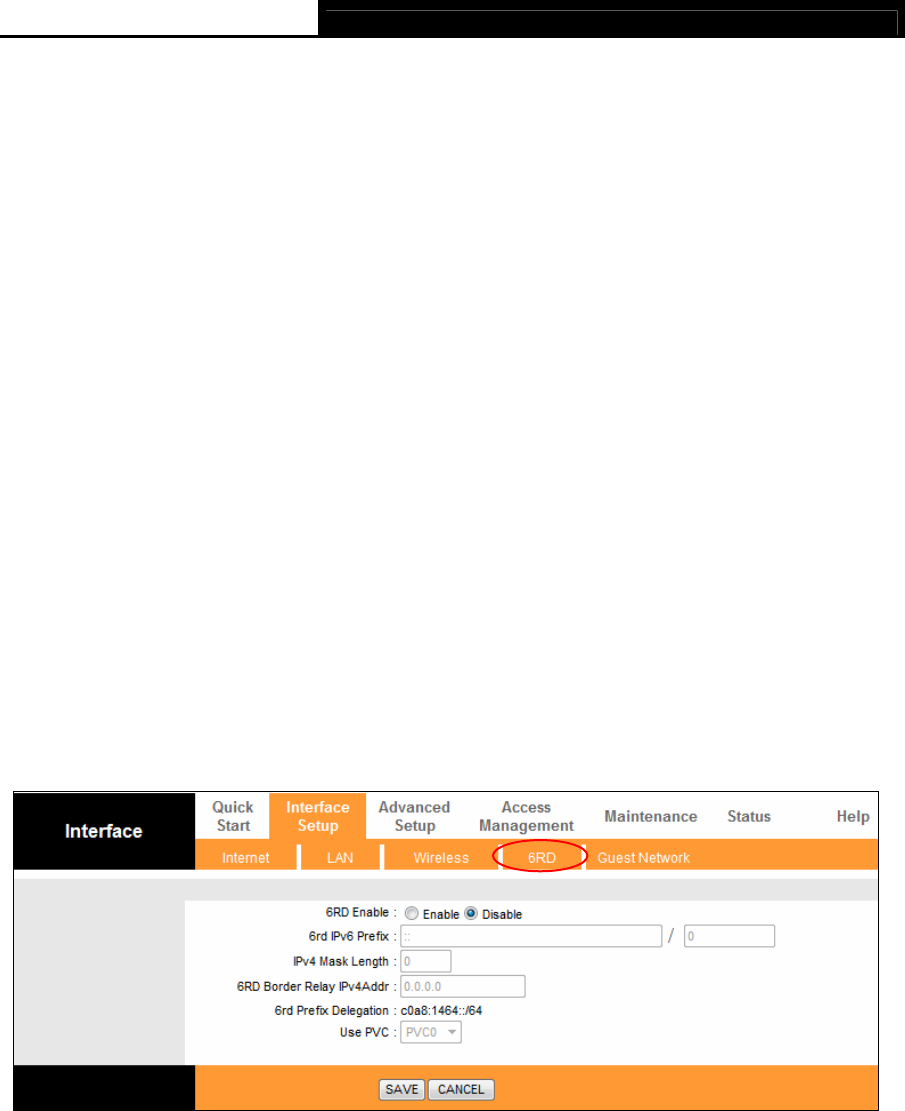
TD-W8961N 300Mbps Wireless N ADSL2+ Modem Router User Guide
40
Wireless MAC Address Filter: Wireless access can be filtered by using the MAC addresses
of the wireless devices transmitting within your network’s RADIUS.
Active: If you wish to filter users by MAC Address, select “Activated”, and “Deactived”
for don’t.
Action: To filter wireless users by MAC Address, select “Allow Association” or “Deny
Association” the follow Wireless LAN station(s) association.
MAC Address: Enter the MAC Address you wish to filter in the field.
Note:
For most users, it is recommended to use the default Wireless LAN Performance settings. Any
changes made to these settings may adversely affect your wireless network. Under certain
circumstances, changes may benefit performance. Carefully consider and evaluate any changes
to these wireless settings.
4.3.4 6RD
IPv6 tunnel is a kind of transition mechanism to enable IPv6-only hosts to reach IPv4 services and
to allow isolated IPv6 hosts and networks to reach each-other over IPv4-only infrastructure before
IPv6 completely supplants IPv4. It is a temporary solution for networks that do not support native
dual-stack, where both IPv6 and IPv4 run independently.
As a type of IPv6 tunnel, 6RD is used in the situation that your WAN connection is IPv4 while LAN
connection is IPv6. Choose “Interface Setup→6RD” menu.
Figure 4-9
6RD Enable: The default setting is disabled, select Enable when your WAN connection is
IPv4 while LAN connection is IPv6.
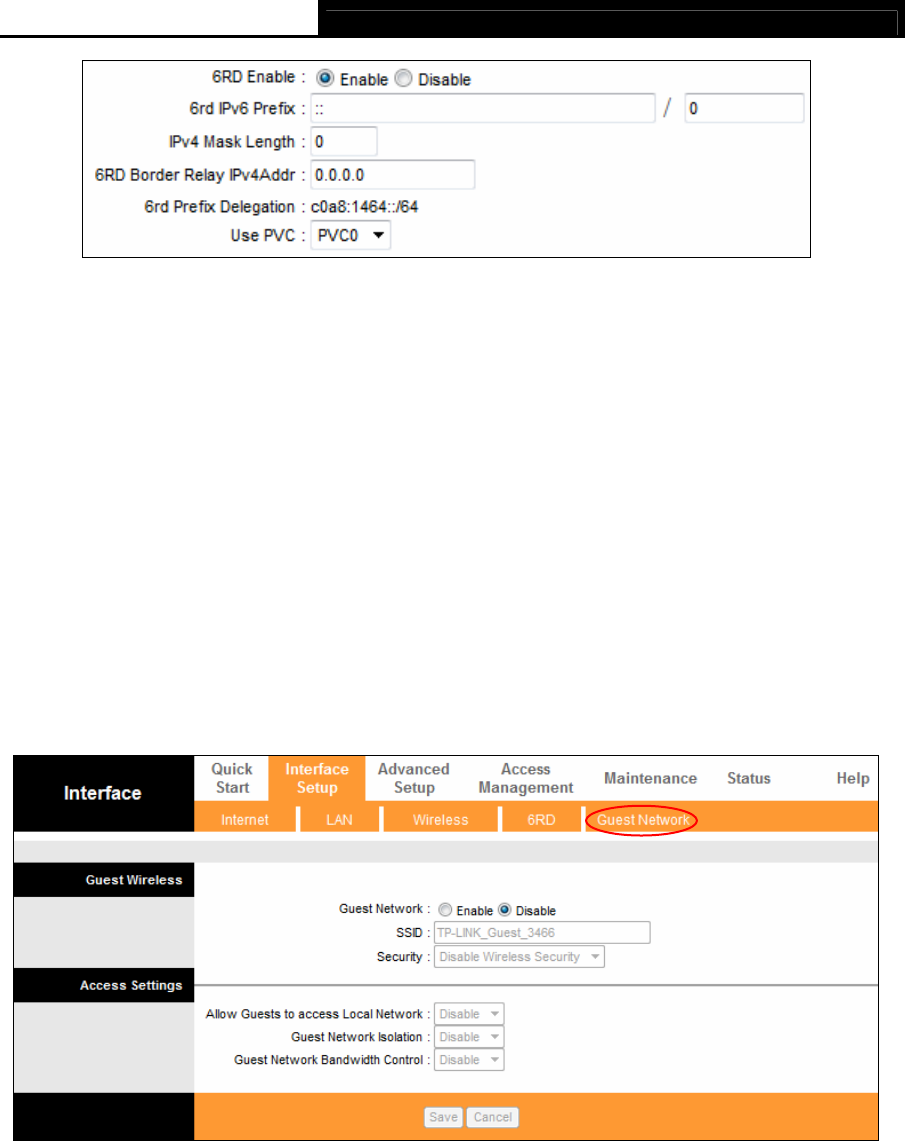
TD-W8961N 300Mbps Wireless N ADSL2+ Modem Router User Guide
41
Figure 4-10
6rd IPv6 Prefix: Enter the prefix of the IPv6.
IPv4 Mask Length: The length of the selected WAN connection’s IPv4 mask.
6RD Border Relay IPv4Addr: The IPv4 address of the border relay router of 6RD tunnel.
Use PVC: Select the PVC from the drop-down list.
Note:
To enable the function, there should not be any IPv6 WAN connections.
4.3.5 Guest Network
Choose “Interface Setup→Guest Network” menu, and you will see the Guest Network screen.
This feature allows you to create a separate network for your guests without allowing them to
access your main network and the computers connected to it.
Figure 4-11
You can enable or disable Guest Network. The default setting is disabled. When you enable this
function, you could set wireless parameters for Guest Network.
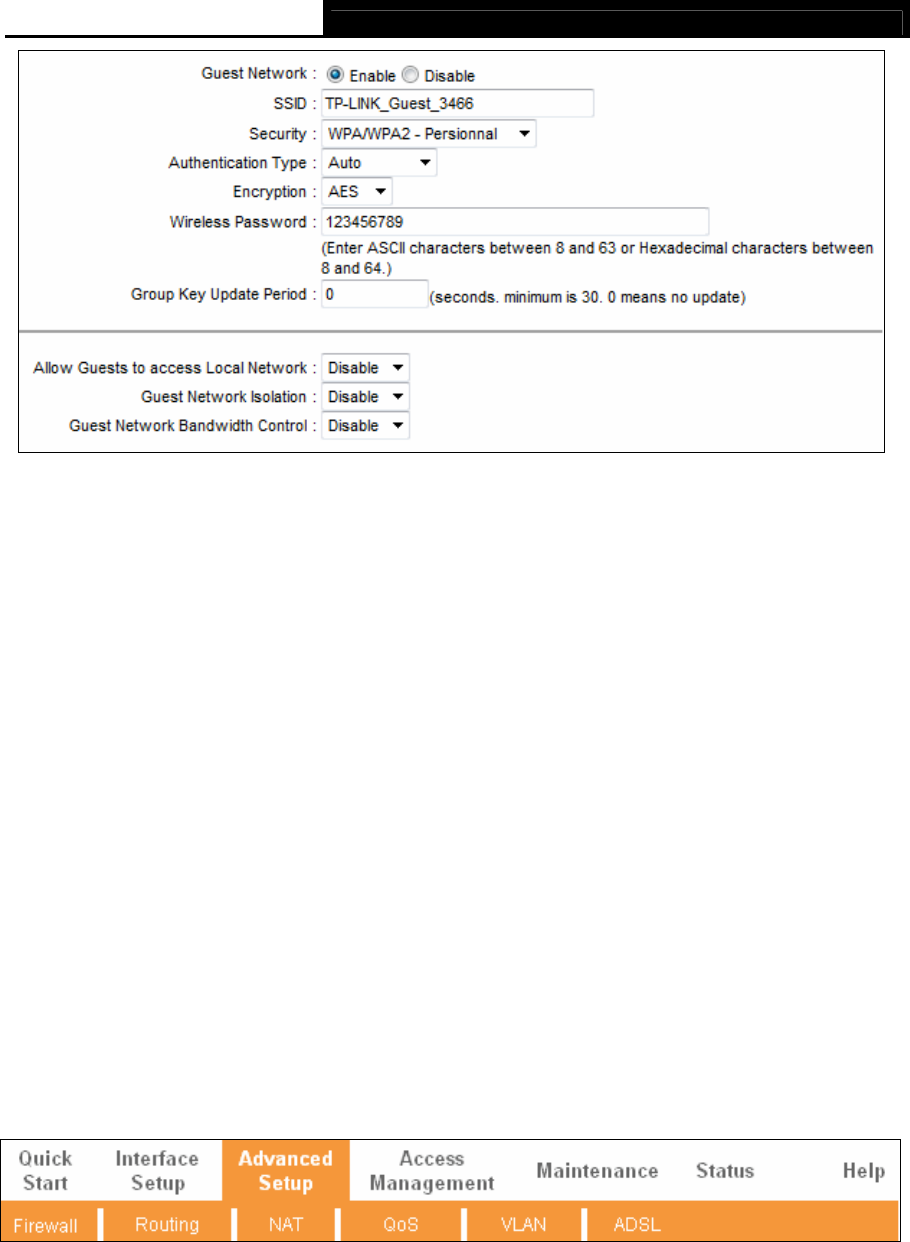
TD-W8961N 300Mbps Wireless N ADSL2+ Modem Router User Guide
42
Guest SSID: The guest network name. When setting up a Guest network, it is strongly
recommended to use a name that easily distinguishes it from your primary network.
Authentication Type: Select the Authentication Type from the drop-down list.
Encryption: You can select either AES or AES+TKIP.
Wireless Password: You may personalize your guest network password by entering a new
password.
Group Key Update Period: Specify the group key update interval in seconds. The value
should be 30 or above. Enter 0 to disable the update.
Allow Guests to access Local Network: The guests have access to your Local Network,
but cannot login the modem router’s web management interface.
Guest Network Isolation: This function can isolate wireless clients on your guest network
from each other. Client isolation is disabled by default.
Guest Network Bandwidth Control: With this function, you can configure the Upstream
Bandwidth and Downstream Bandwidth for guest network.
Click Save to save your settings.
4.4 Advanced Setup
Choose “Advanced Setup”, you can see the following submenus:
Figure 4-12
Click any of them, and you will be able to configure the corresponding function.
4.4.1 Firewall
Choose “Advanced Setup→Firewall” menu, and you will see the following screen.
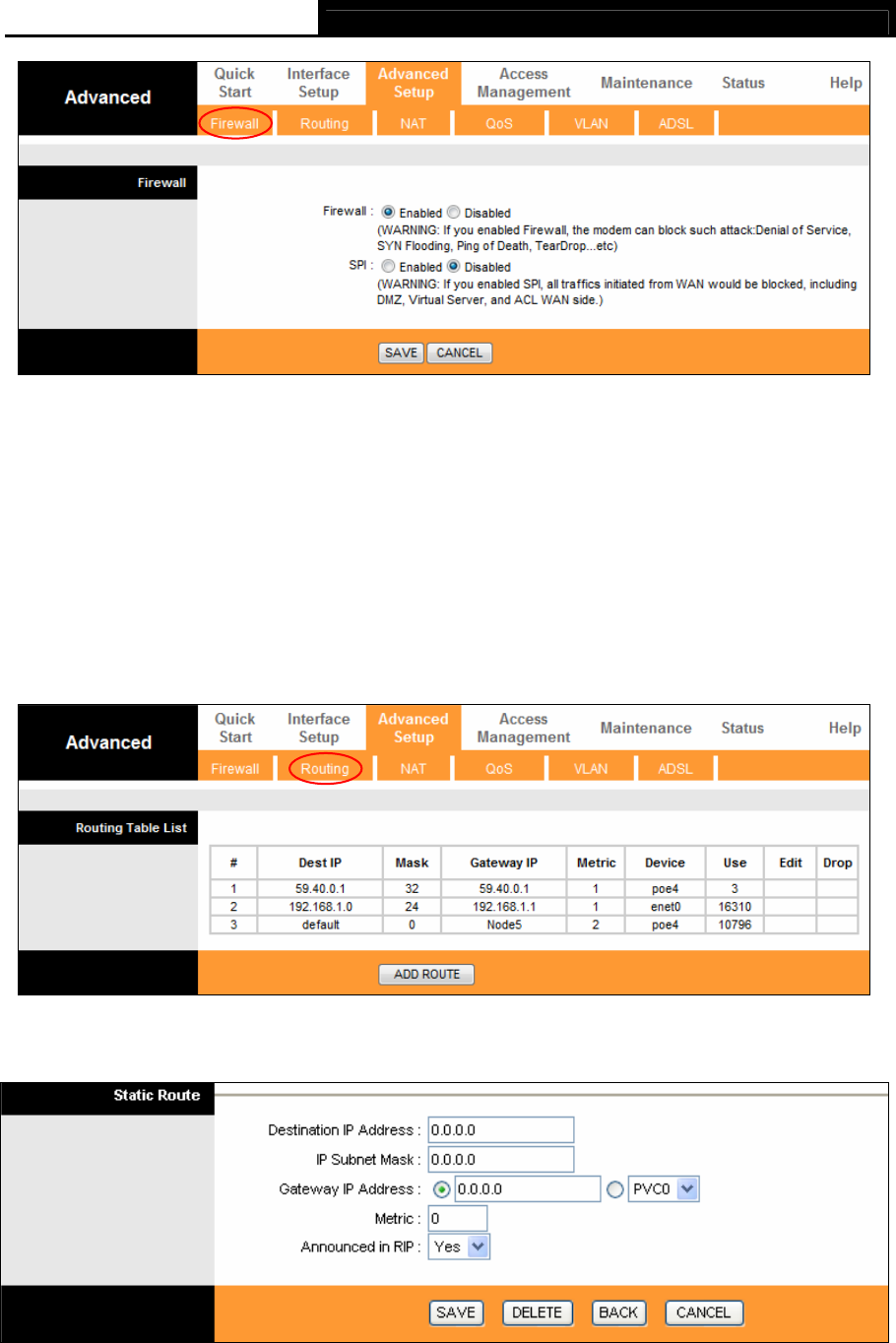
TD-W8961N 300Mbps Wireless N ADSL2+ Modem Router User Guide
43
Figure 4-13
Firewall: Select this option can automatically detect and block Denial of Service (DoS)
attacks, such as Ping of Death, SYN Flood, Port Scan and Land Attack.
SPI: If you enable SPI, all traffics initiated from WAN would be blocked, including DMZ,
Virtual Server, and ACL WAN side.
4.4.2 Routing
Choose “Advanced Setup→Routing” menu, and you will see the routing information in the
following screen.
Figure 4-14
Click ADD ROUTE button to add a new route in the following screen.
Figure 4-15
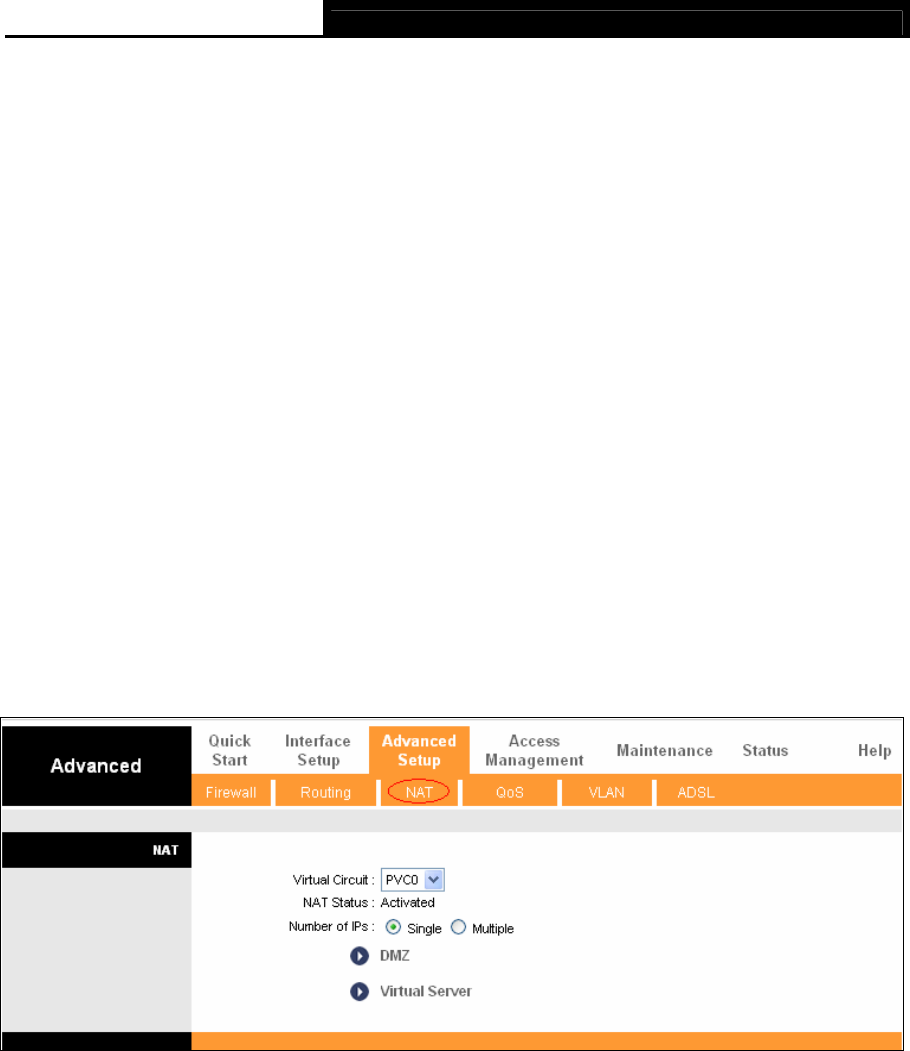
TD-W8961N 300Mbps Wireless N ADSL2+ Modem Router User Guide
44
Destination IP Address: This parameter specifies the IP network address of the final
destination.
IP Subnet Mask: Enter the subnet mask for this destination.
Gateway IP Address: Enter the IP address of the gateway. The gateway is an immediate
neighbor of your ADSL modem router that will forward the packet to the destination. On the
LAN, the gateway must be a modem router on the same segment as your modem router;
over Internet (WAN), the gateway must be the IP address of one of the remote nodes.
Metric: Metric represents the "cost" of transmission for routing purposes. IP Routing uses
hop count as the measurement of cost, with a minimum of 1 for directly connected networks.
Enter a number that approximates the cost for this link. The number need not to be precise,
but it must between 1 and 15. In practice, 2 or 3 is usually a good number.
Announced in RIP: This parameter determines if the ADSL modem router will include the
route to this remote node in its RIP broadcasts. If set to Yes, the route to this remote node will
be propagated to other hosts through RIP broadcasts. If No, this route is kept private and is
not included in RIP broadcasts.
4.4.3 NAT
Choose “Advanced Setup→NAT” menu, you can setup the NAT (Network Address Translation)
function for the Modem router.
Figure 4-16
Virtual Circuit: Enter Virtual Circuit Index that you plan to setup for the NAT function.
NAT Status: This field shows the current status of the NAT function for the current VC. You
can go to the previous screen to activate the function.
Number of IPs: This field is to specify how many IPs are provided by your ISP for current VC.
It can be single IP or multiple IPs. We select Multiple to explain.
Note:
For VCs with single IP, they share the same DMZ and Virtual servers; for VCs with multiple IPs,
each VC can set DMZ and Virtual servers. Furthermore, for VCs with multiple IPs, they can define
the Address Mapping rules; for VCs with single IP, since they have only one IP, there is no need
to individually define the Address Mapping rule.
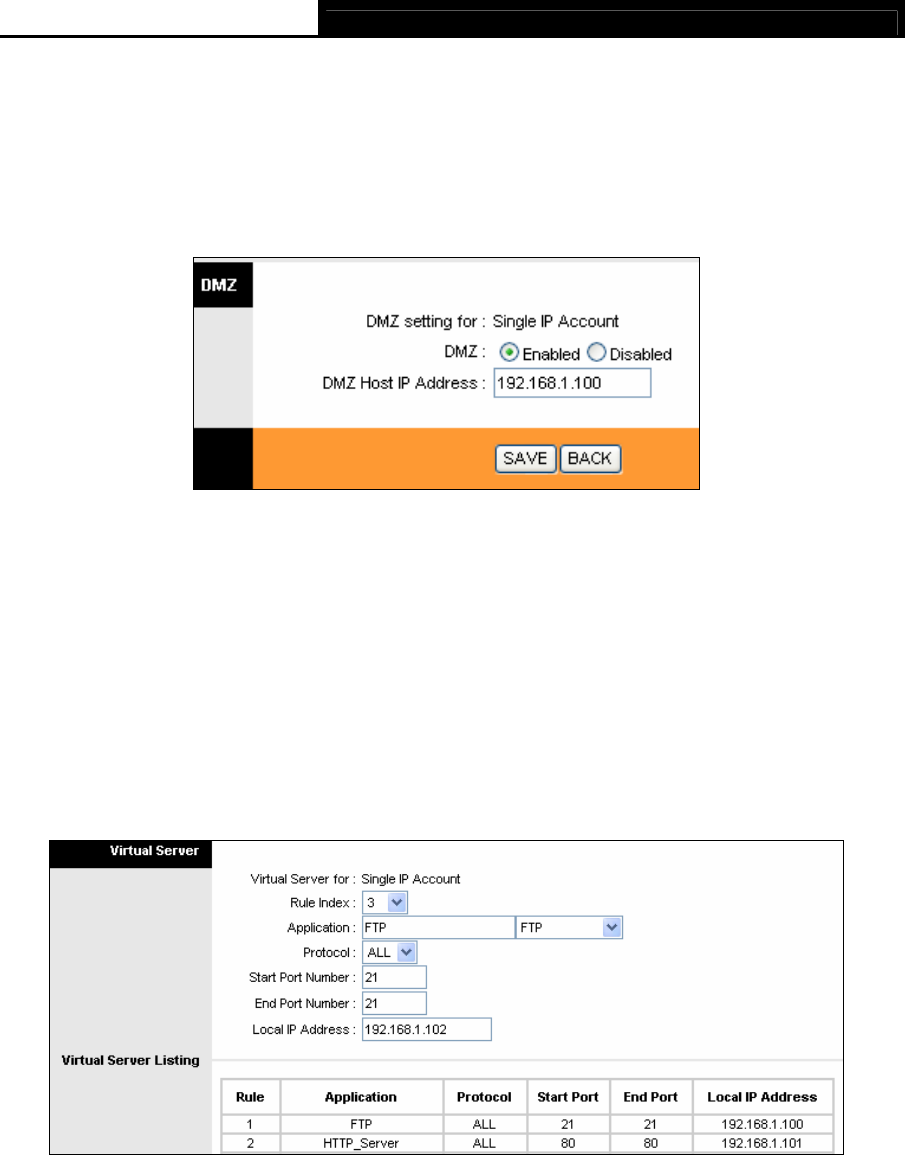
TD-W8961N 300Mbps Wireless N ADSL2+ Modem Router User Guide
45
4.4.3.1 DMZ
Choose “Advanced Setup→NAT→DMZ”, you can configure the DMZ host in the following
screen. A DMZ (demilitarized zone) is a host between a private local network and the outside
public network. It prevents outside users from getting direct access to a server that has company
data. Users of the public network outside the company can access to the DMZ host.
Figure 4-17
DMZ Host IP Address: Enter the specified IP Address for DMZ host on the LAN side.
4.4.3.2 Virtual Server
Choose “Advanced Setup→NAT→Virtual Server” in Figure 4-16, you can configure the Virtual
Server in the following screen.
The Virtual Server is the server or server(s) behind NAT (on the LAN), for example, Web server or
FTP server, that you can make visible to the outside world even though NAT makes your whole
inside network appear as a single machine to the outside world.
Rule Index: The Virtual server rule index for this VC. You can specify 10 rules in maximum.
All the VCs with single IP will use the same Virtual Server rules.
Application: The Virtual servers can be used for setting up public services on your LAN.
Protocol: The protocol used for this application.
Start & End port number: Enter the specific Start and End Port number you want to forward.
If it is one port only, you can enter the End port number the same as Start port number. For
example, if you want to set the FTP Virtual server, you can set the start and end port number
to 21.

TD-W8961N 300Mbps Wireless N ADSL2+ Modem Router User Guide
46
Local IP Address: Enter the IP Address for the Virtual Server in LAN side.
Virtual Server Listing: This displays the information about the Virtual Servers you establish.
To add a virtual server entry:
Step 1: Select the “Virtual Circuit” and select “Virtual Server”.
Note:
For VCs with single IP, select Single; For VCs with multiple IPs, select Multiple for the option.
Step 2: Select the Rule index for the rule.
Step 3: Select the application you want from drop-down list, then the protocol and port number
will be added to the corresponding field automatically, you only need to configure the IP
address for the virtual server; If the application list does not contain the service that you
want, please configure the Port number, IP Address and Protocol manually.
Step 4: After that, click SAVE to make the entry take effect.
Other operations for the entries:
Enter the index of assigned entry, and click the DELETE button to delete the entry.
Click the BACK button to return to the previous screen.
Click the CANCEL button to cancel the configuration which is made just now.
4.4.3.3 IP Address Mapping
Select Multiple for numbers of IPs in Figure 4-16, and choose “Advanced Setup→NAT→IP
Address Mapping(for Multiple IP Service)”. You can configure the Address Mapping Rule in the
following screen. The IP Address Mapping is for those VCs that configured with multiple IPs. The
IP Address Mapping rule is per-VC based (only for Multiple IPs' VCs).
Rule Index: Select the Virtual server rule index for this VC. You can specify 8 rules in
maximum.
Rule Typ: There are four types: one-to-one, Many-to-One, Many-to-Many Overload and
Many-to-Many No-overload.
Local Start & End IP: Enter the local IP Address you plan to map to. Local Start IP is the
starting local IP address and Local End IP is the ending local IP address. If the rule is for all
local IPs, then the Start IP is 0.0.0.0 and the End IP is 255.255.255.255.

TD-W8961N 300Mbps Wireless N ADSL2+ Modem Router User Guide
47
Public Start & End IP: Enter the public IP Address you want to do NAT. Public Start IP is the
starting public IP address and Public End IP is the ending public IP address. If you have a
dynamic IP, enter 0.0.0.0 as the Public Start IP.
Address Mapping List: This displays the information about the Mapping addresses.
To add a mapping rule:
Step 1: Select the “Virtual Circuit” and Multiple for the “Number of IPs”. Then select the tab IP
Address Mapping.
Note:
IP Address Mapping is only available for VCs with Multiple IPs.
Step 2: Select the Rule index for the rule.
Step 3: Select the rule type you want from the drop-down list.
Step 4: Enter the local and public IP addresses in the corresponding fields.
Step 5: After that, click SAVE to make the entry take effect.
Other operations for the entries:
Select the index of assigned entry, and click the DELETE button to delete the entry.
Click the BACK button to return to the previous screen.
Click the CANCEL button to cancel the configuration which is made just now.
4.4.4 QoS
Choose “Advanced Setup→QoS”, you can configure the QoS in the following screen. QoS helps
to prioritize data as it enters your modem router. By attaching special identification marks or
headers to incoming packets, QoS determines which queue the packets enter, based priority.
This is useful when there are certain types of data you want to give higher priority, such as voice
data packets give higher priority than Web data packets. This option will provide better service of
selected network traffic over various technologies.
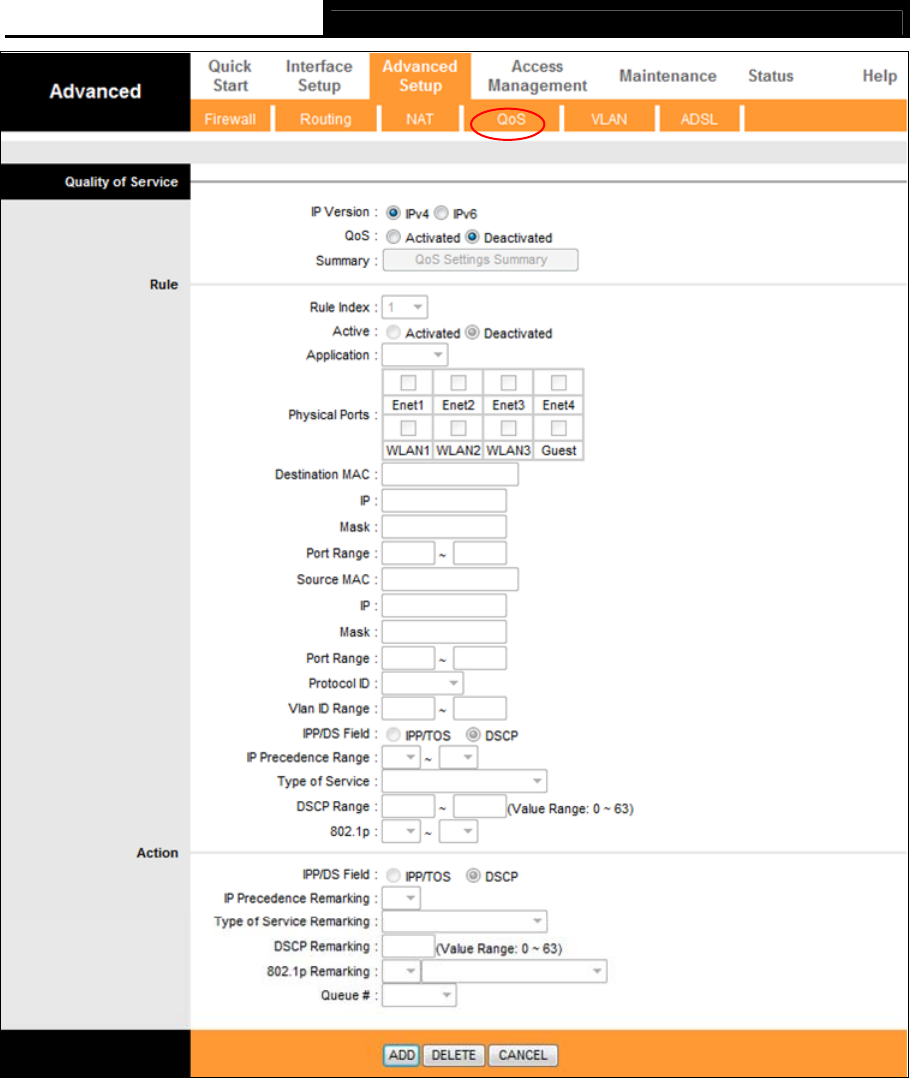
TD-W8961N 300Mbps Wireless N ADSL2+ Modem Router User Guide
48
Figure 4-18
IP Version:Select your IP version.
QoS: Select this option to Activate/Deactivate the IP QoS on different types (IP ToS and
DiffServ).
Summary: Click the button to view the configurations of QoS.
Rule: Configure the rules for QoS. If the traffic complies with the rule, then the modem router
will take the corresponding action to deal with it.
Rule Index: Select the index for the rule you want to configure.
Active: Activate the rule. The rule can take effect only when it is activated.
Application: Select the application that the rule aimed at.
Physical Ports: Select the port whose traffic flow are controlled by the rule.

TD-W8961N 300Mbps Wireless N ADSL2+ Modem Router User Guide
49
Destination MAC & IP & Mask & Port Range: Enter the IP information about the
Destination host for the rule.
Source MAC & IP & Mask & Port Range: Enter the IP information about the Source
host for the rule.
Protocol ID: Select one among TCP/UDP, TCP, UDP or ICMP protocols for the
application.
Vlan ID Range: Enter the Vlan range, and the rule will be effective to the selected Vlans.
IPP/DS Field: Select the type of the action to assign the priority.
When you select IPP/TOS, you can assign the priority via IP information. IP QoS function is
intended to deliver guaranteed as well as differentiated Internet services by giving network
resource and usage control to the Network operator.
IP Precedence Range: Enter the IP precedence range that the modem router takes to
differentiate the traffic.
Type of Service: Select the type of service that the modem router takes to deal with the
traffic.
802.1p: Select the priority range for the rule.
When you select DSCP, you can assign the priority via DHCP (the header of IP group). It maps
the IP group into corresponding service class.
DSCP Range: Enter the DSCP range to differentiate the traffic.
802.1p: Select the priority range for the rule.
Action: Configure the action that the modem router takes to deal with the traffic which accord
with the rule.
IPP/DS Field: Select the type for the action.
IP Precedence Remarking: Select the number to remark the priority for IP precedence.
Type of Service Remarking: Select the type to remark the service.
DSCP Remarking: Enter the number to remark the DSCP priority.
802.1p Remarking: Select the type to remark the 802.1p priority.
Queue: Select the priority type for the action.
4.4.5 VLAN
Choose “Advanced Setup→VLAN”, you can activate the VLAN function in the following screen.
Virtual LAN (VLAN) is a group of devices on one or more LANs that are configured so that they
can communicate as if they were attached to the same LAN, when in fact they are located on a
number of different LAN segments. Because VLANs are based on logical instead of physical
connections, it is very flexible for user/host management, bandwidth allocation and resource
optimization. There are two types of VLAN as follows:
Port-Based VLAN: Each physical switch port is configured with an access list specifying
membership in a set of VLANs.
ATM VLAN: Using LAN Emulation (LANE) protocol to map Ethernet packets into ATM cells and
deliver them to their destination by converting an Ethernet MAC address into an ATM address.
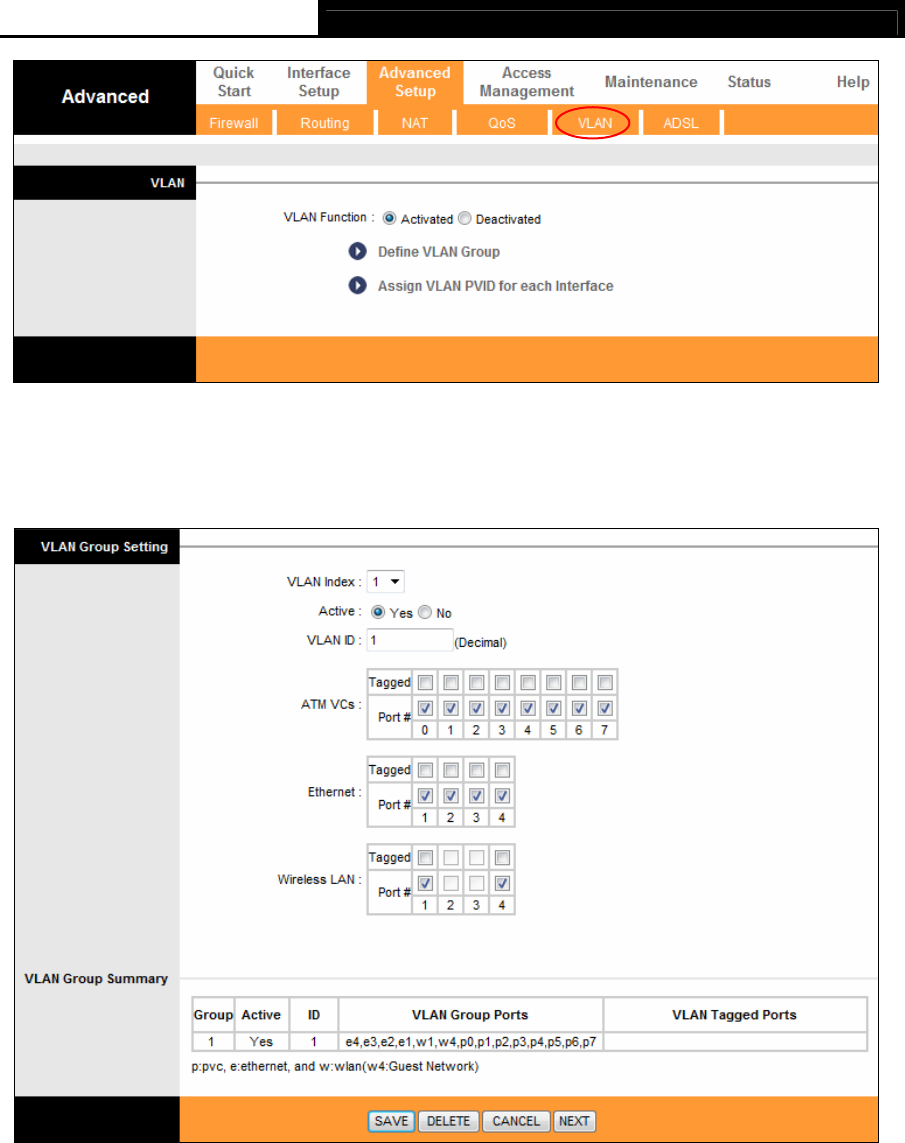
TD-W8961N 300Mbps Wireless N ADSL2+ Modem Router User Guide
50
Figure 4-19
1) Define VLAN Group
Click Define VLAN Group, you can define VLAN groups in the following screen.
VLAN Index: Select the VLAN index for this VC. You can specify 8 groups in maximum.
VLAN ID: This indicates the VLAN group.
ATM VCs: Select the ATM VCs as members of VLAN, and if you leave the Tagged blank, the
tag in frames will be deleted when transmitted from the VC.
Ethernet: Select the Ethernet port as a member of VLAN.
Wireless LAN: Select the wireless LAN port as a member of VLAN, and if you leave the
Tagged blank, the tag in frames will be deleted when transmitted from the port.
VLAN Group Summary: This displays the information about the VLAN Groups.
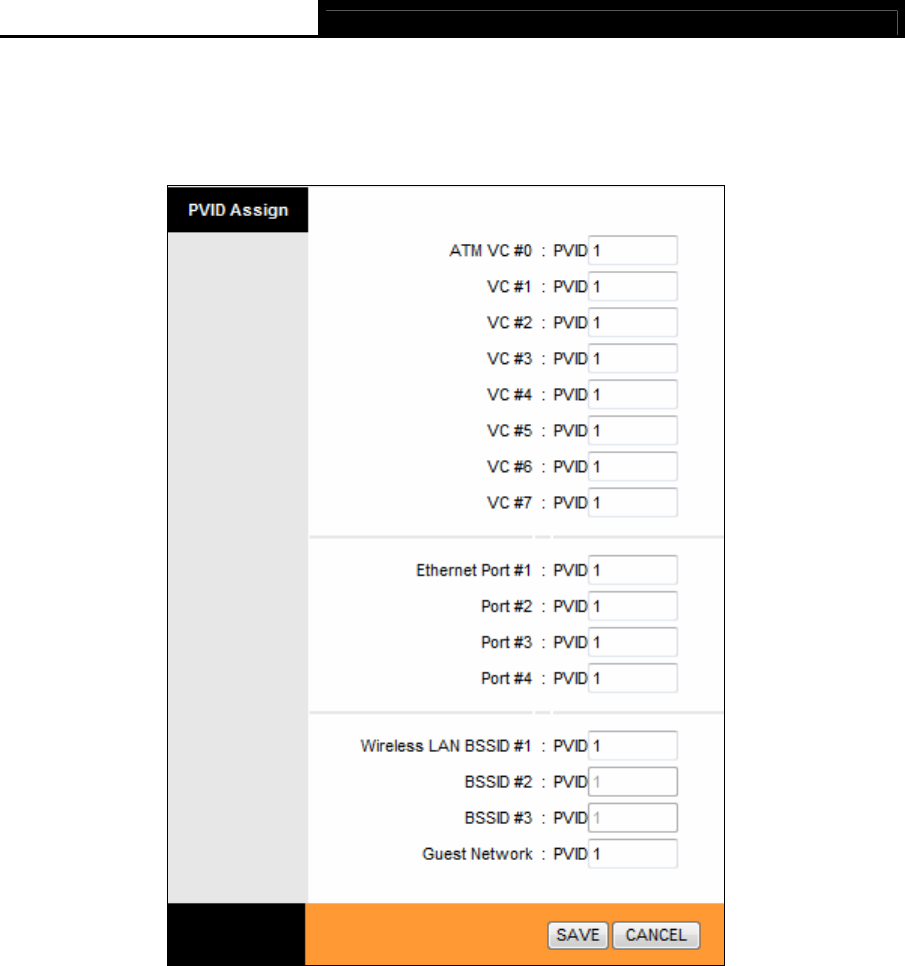
TD-W8961N 300Mbps Wireless N ADSL2+ Modem Router User Guide
51
2) Assign VLAN PVID for each Interface
Click Assign VLAN PVID for each Interface, you can assign the PVID for each interface in the
following screen.
PVID: Each physical port has a default VID called PVID (Port VID). PVID is assigned to
untagged frames or priority tagged frames (frames with null (0) VID) received on this port.
4.4.6 ADSL
Choose “Advanced Setup→ADSL”, you can select the ADSL Type and ADSL Mode in the
following screen. The ADSL feature can be selected when you meet the physical connection
problem. Please check the proper settings with your Internet service provider.
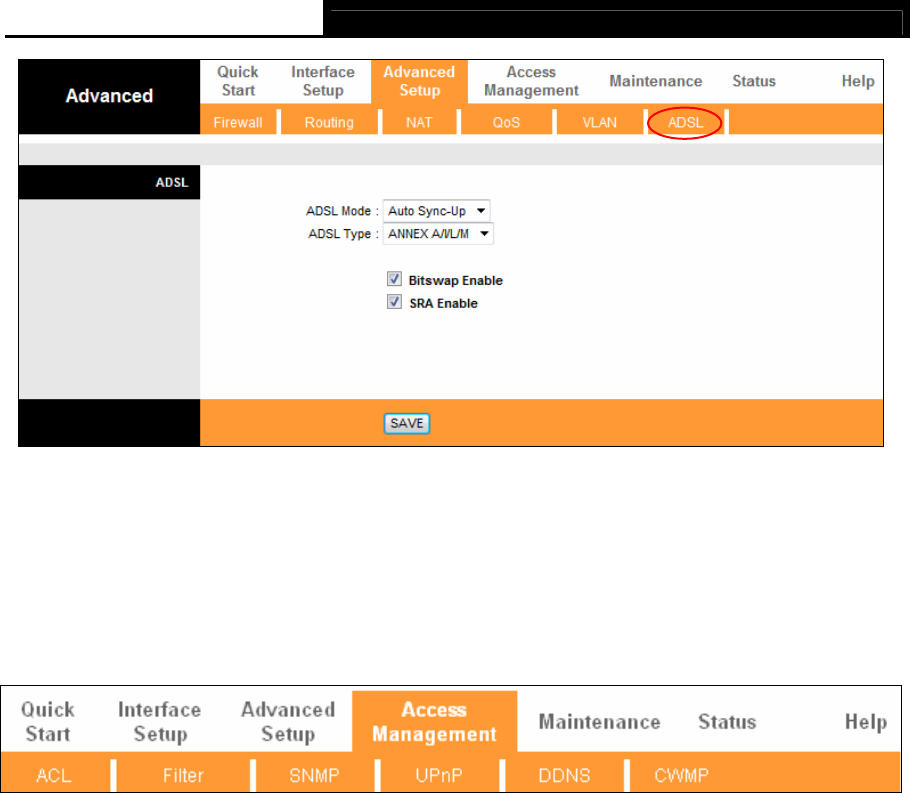
TD-W8961N 300Mbps Wireless N ADSL2+ Modem Router User Guide
52
Figure 4-20
ADSL Mode: Select the ADSL operation mode which your ADSL connection uses.
ADSL Type: Select the ADSL operation type which your ADSL connection uses.
4.5 Access Management
Choose “Access Management”, you can see the following submenus:
Figure 4-21
Click any of them, and you will be able to configure the corresponding function.
4.5.1 ACL
Choose “Access Management→ACL”, you can see the following screen. You can specify the
client to access the ADSL modem router once setting his IP as a Secure IP Address through
selected applications.
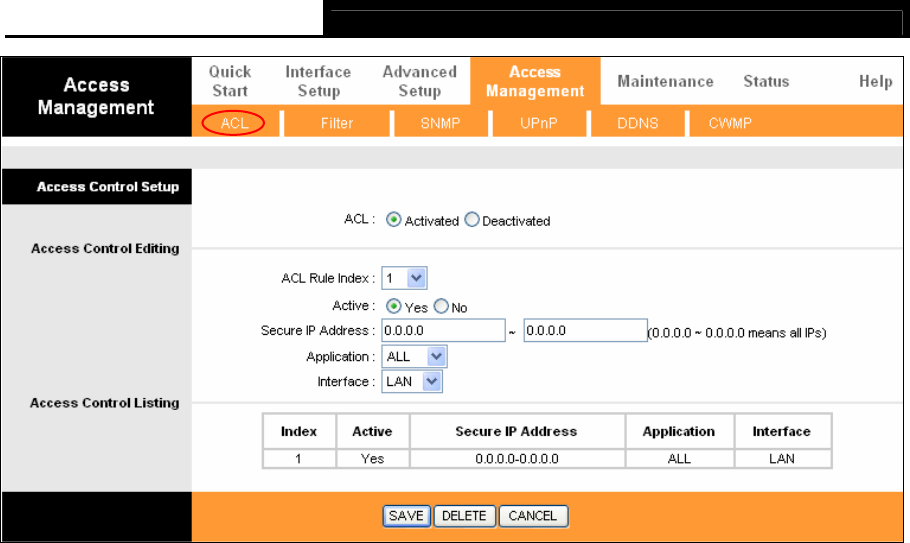
TD-W8961N 300Mbps Wireless N ADSL2+ Modem Router User Guide
53
Figure 4-22
ACL: If Activated, the IP addresses which are contained in the Access Control List can
access to the modem router. If Deactivated, all IP addresses can access to the modem
router.
ACL Rule Index: Select the ACL rule index for the entry.
Active: Enable the ACL rule.
Secure IP Address: Select the IP addresses which are permitted to access to the modem
router remotely. With the default IP 0.0.0.0, any client would be allowed to remotely access
the ADSL modem router.
Application: Select the application for the ACL rule, and then you can access the modem
router through it.
Interface: Select the interface for access: LAN, WAN or Both.
Access Control of Listing: This displays the information about the ACL Rules.
4.5.2 Filter
Choose “Access Management→Filter”, you can see the Filter screen (the default is IP/MAC
Filter screen). The filtering feature includes IP/MAC Filter, Application Filter, and URL Filter. The
feature makes it possible for administrators to control user's access to the Internet, protect the
networks.
4.5.2.1 IP Filter
Select IP/MAC Filter as the Filter type, and select IP as the Rule type, then you can configure the
filter rules based on IP address. The filtering includes Outgoing and Incoming, the detailed
descriptions are provided below.
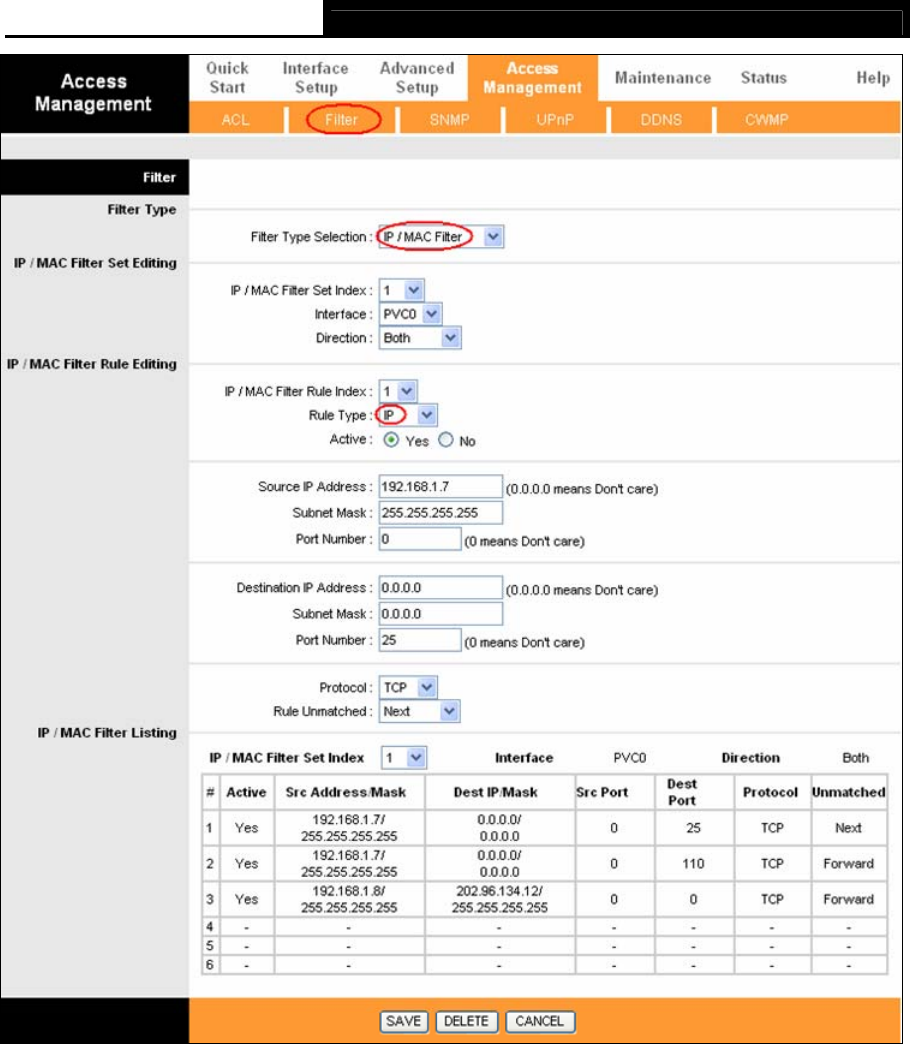
TD-W8961N 300Mbps Wireless N ADSL2+ Modem Router User Guide
54
Figure 4-23
Filter Type Selection: Select the filter type for the configuration below.
IP/MAC Filter Set Index: Select the Set index for the IP Filter entry. This index can match
with six IP / MAC Filter Rule Indexes.
Interface: Select the interface for the entry.
Note:
If select PVC0~PVC7 as an interface, the filter will match the IP traffic of WAN port with specified
IPs (Source IP Address and Destination IP Address). If select LAN as an interface, the filter will
match the IP traffic of LAN port with specified IPs.
Direction: Select the direction for this IP Filter rule. There are three filtering directions: Both,
Incoming, Outgoing.

TD-W8961N 300Mbps Wireless N ADSL2+ Modem Router User Guide
55
Note:
Incoming means that IP traffic which is coming into the modem router, and the Outgoing means
that IP traffic which is going out the modem router.
IP/MAC Filter Rule Index: Select the Rule index for the IP Filter entry.
Note:
You should set the IP/MAC Filter Set Index and IP/MAC Filter Rule Index together to appoint
the address (shown in the Filter List) for the IP Filter rule. For example, (1, 2), it means the rule will
be shown in the row 2 IP/MAC Filter Set Index 1.
Rule Type: For IP Filter, please select IP here.
Active: Select “Yes” to make the rule to take effect.
Source IP Address: Enter the source IP address for the rule. You can enter 0.0.0.0; it means
that all IP addresses are controlled by the rule.
Destination IP Address: Enter the destination IP address for the rule. You can enter 0.0.0.0,
it means that all IP addresses are controlled by the rule. The set of Subnet Mask and Port
Number are same as Source IP Address.
Subnet Mask: Enter the Subnet Mask for the rule.
Port Number: Enter the Port Number for the rule. You can enter 0, which means that all
ports are controlled by the rule.
Protocol: Select the protocol: TCP, UDP or ICMP for the filter rule.
Rule Unmatched: If the current rule can not match, and you select Forward, the modem
router will skip the rule and transmit directly. If you select Next, the modem router will find the
next filter rule (show in Filter list) to match.
IP/MAC Filter Listing: This displays the information about the IP Filter rules.
To add an IP Address filtering entry:
For example: If you desire to block E-mail received and sent by the IP address 192.168.1.7 on
your local network; And wish to make the PCs with IP address 192.168.1.8 unable to visit the
website of IP address 202.96.134.12, while other PCs have no limit. You can configure the rules
as follows. Presume the rules are both aimed at the interface PVC0, and their indexes are (1, 1),
(1, 2) and (1, 3).
Step 1: Select the “IP/MAC Filter” as the Filter Type Selection (show in Figure 4-23).
Select the “IP” as the Rule Type on the Filter screen, then you can configure the specific
rule for the example.
Step 2: Select the IP/MAC Filter Set Index and IP/MAC Filter Rule Index for the rule, then
select the Interface “PVC0”, and select the Direction “Both” for the first rule.
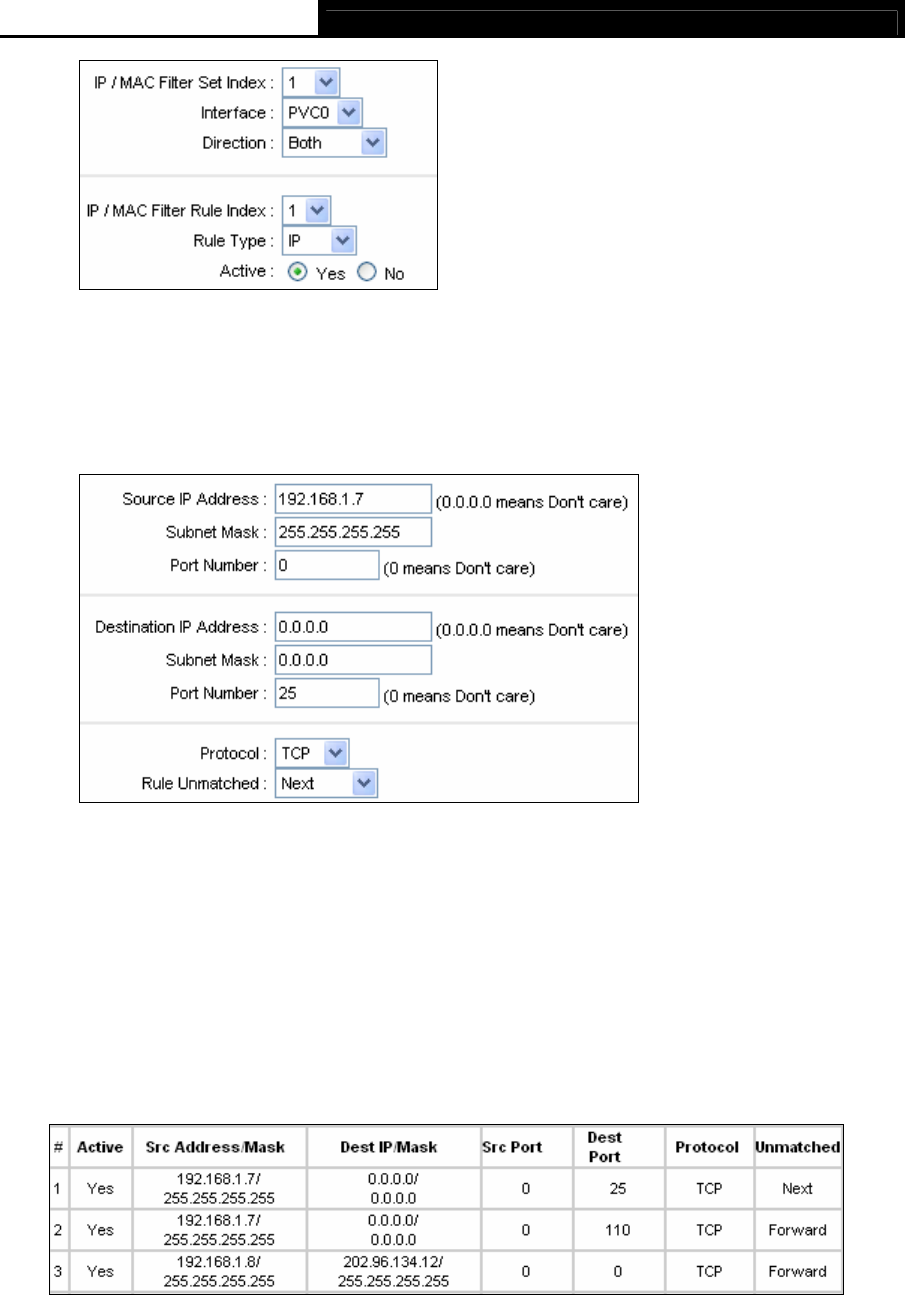
TD-W8961N 300Mbps Wireless N ADSL2+ Modem Router User Guide
56
Note:
If you want to make the rule take effect, please select Yes to active the rule.
Step 3: Enter the Source IP Address, Destination IP Address, Subnet Mask and Port
Number in the corresponding field.
Step 4: Select the Protocol as “TCP” and select the Unmatched rule as “Next”.
Step 5: Finally, click the SAVE to save the entry.
Step 6: Go to Step 2 to configure the next two rules: Block E-mail received by the IP address
192.168.1.7 on your local network; Make the PC with IP address 192.168.1.8 unable to
visit the website of IP address 202.96.134.12.
Note:
After you complete the IP filter rules for the example, the Filter list will show as follows. You can
enter the IP / MAC Filter Set Index to view the information about the rule.
Other operations for the entries:
Select the IP / MAC Filter Set Index and IP/MAC Filter Rule Index to view or modify the entry.
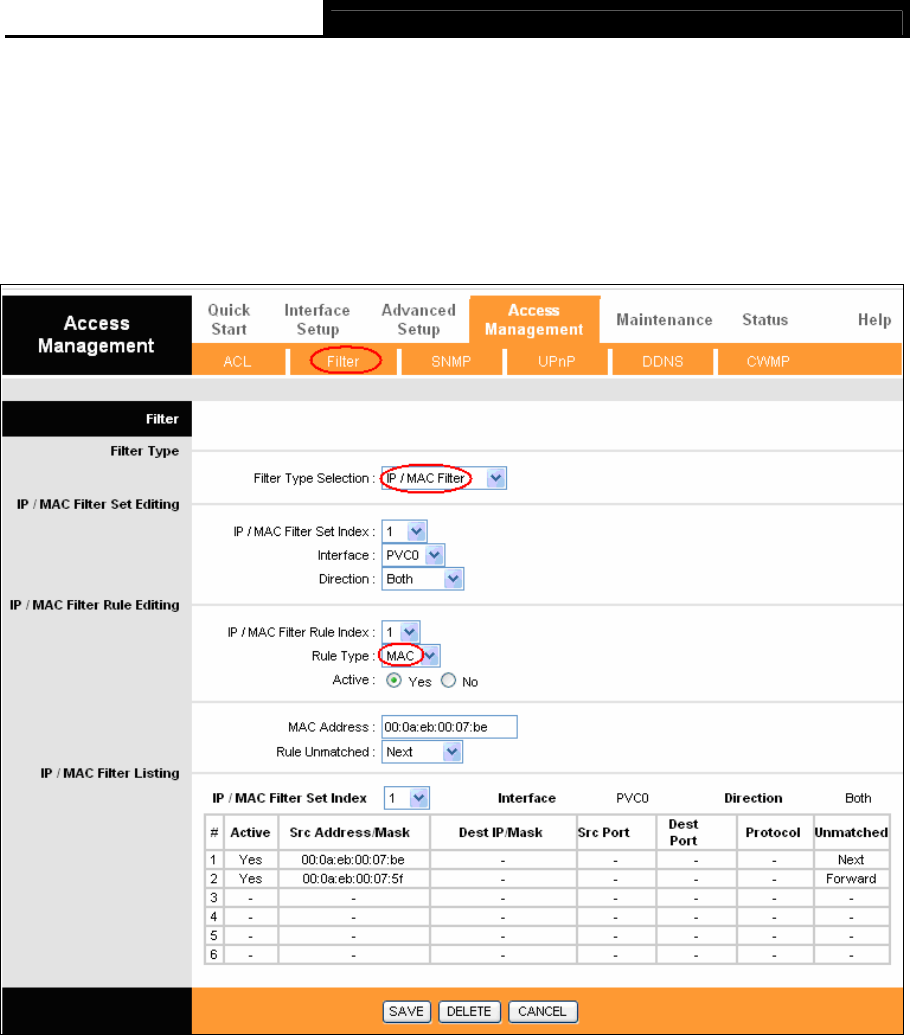
TD-W8961N 300Mbps Wireless N ADSL2+ Modem Router User Guide
57
Select the IP / MAC Filter Set Index and IP/MAC Filter Rule Index to locate the specific rule,
and then click the DELETE button to delete the entry.
4.5.2.2 MAC Filter
Select IP/MAC Filter as the Filter type, and select MAC as the Rule type, and then you can
configure the filter rules based on MAC address.
Figure 4-24
Rule Type: Select MAC for the MAC Filter rule.
Active: Select “Yes” to make the rule to take effect.
MAC Address: Enter the MAC address for the rule.
Rule Unmatched: If the current rule can not match, and you select Forward, the modem
router will skip the rule and transmit directly. If you select Next, the modem router will find the
next filter rule (show in Filter list) to match.
IP/MAC Filter Listing: This displays the information about the MAC Filter rules.
To add a MAC Address filtering entry:
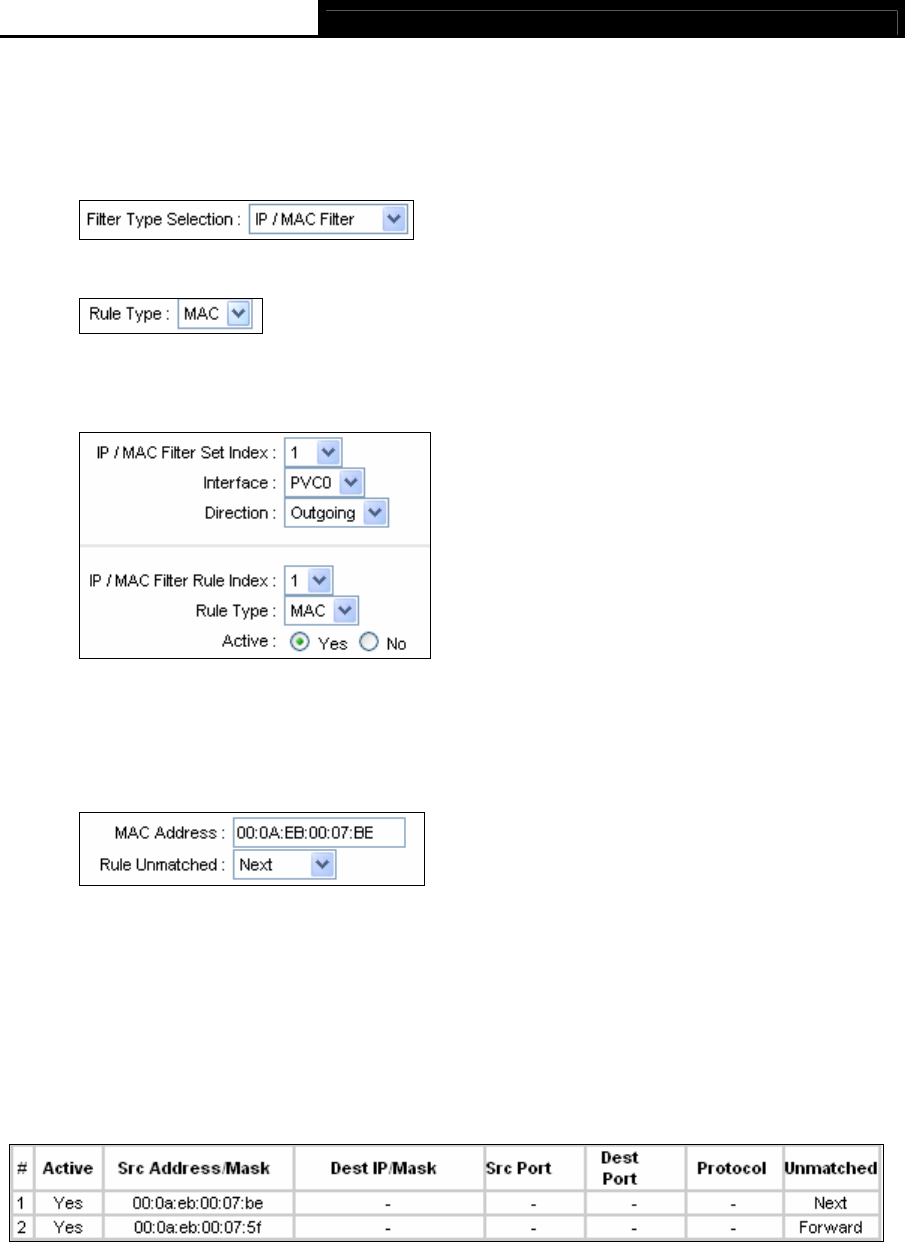
TD-W8961N 300Mbps Wireless N ADSL2+ Modem Router User Guide
58
For example: If you want to block the PCs with MAC addresses 00:0A:EB:00:07:BE and
00:0A:EB:00:07:5F to access the Internet, you can configure as follows. Presume the rules are
both aimed at the interface PVC0, and their indexes are (1, 1) and (1, 2).
Step 1: Select the “IP/MAC Filter” as the Filter Type Selection:
Select the “MAC” as the Rule Type on the Filter screen (show in Figure 4-24).
, Then you can configure the specific rule for the example.
Step 2: Select the IP/MAC Filter Set Index and IP/MAC Filter Rule Index for the rule, then
select the Interface “PVC0”, and select the Direction “Outgoing” for the first rule.
Note:
If you want to make the rule take effect, please select Yes to active the rule.
Step 3: Enter the “MAC Address” and select the Unmatched rule as “Next”.
Step 4: Finally, click the SAVE to save the entry.
Step 5: Go to Step 2 to configure the next rule: Block the PC with MAC address
00:0A:EB:00:07:5F to access the Internet.
Note:
After you complete the MAC filter rules for the example, the Filter list will show as follows. You can
enter the IP / MAC Filter Set Index to view the information about the rule.
Other operations for the entries:
Select the IP / MAC Filter Set Index and IP/MAC Filter Rule Index to view or modify the entry.
Select the IP / MAC Filter Set Index and IP/MAC Filter Rule Index to locate the specific rule,
and then click the DELETE button to delete the entry.
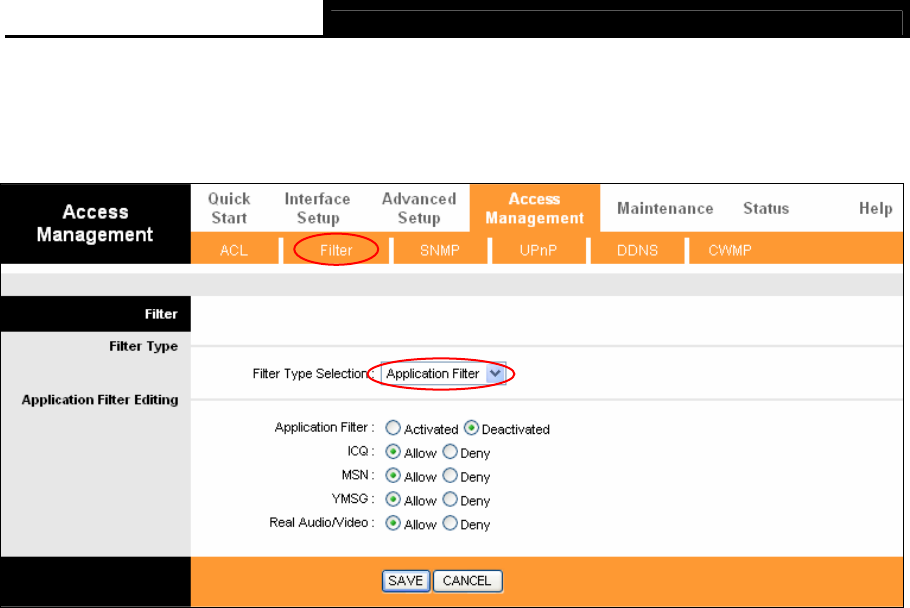
TD-W8961N 300Mbps Wireless N ADSL2+ Modem Router User Guide
59
4.5.2.3 Application Filter
Select Application Filter as the Filter type, and then you can configure the filter rules based on
application.
Figure 4-25
Filter Type Selection: Select the Application Filter for the next configuration.
Application Filter: Activate or deactivate the function.
ICQ & MSN & YMSG & Real Audio/Video: Select Allow or Deny for these applications. If
you select Allow, the modem router will accept the application; if you select Deny, the modem
router will forbid the application.
4.5.2.4 URL Filter
Select URL Filter as the Filter type, and then you can configure the filter rules based on URL.
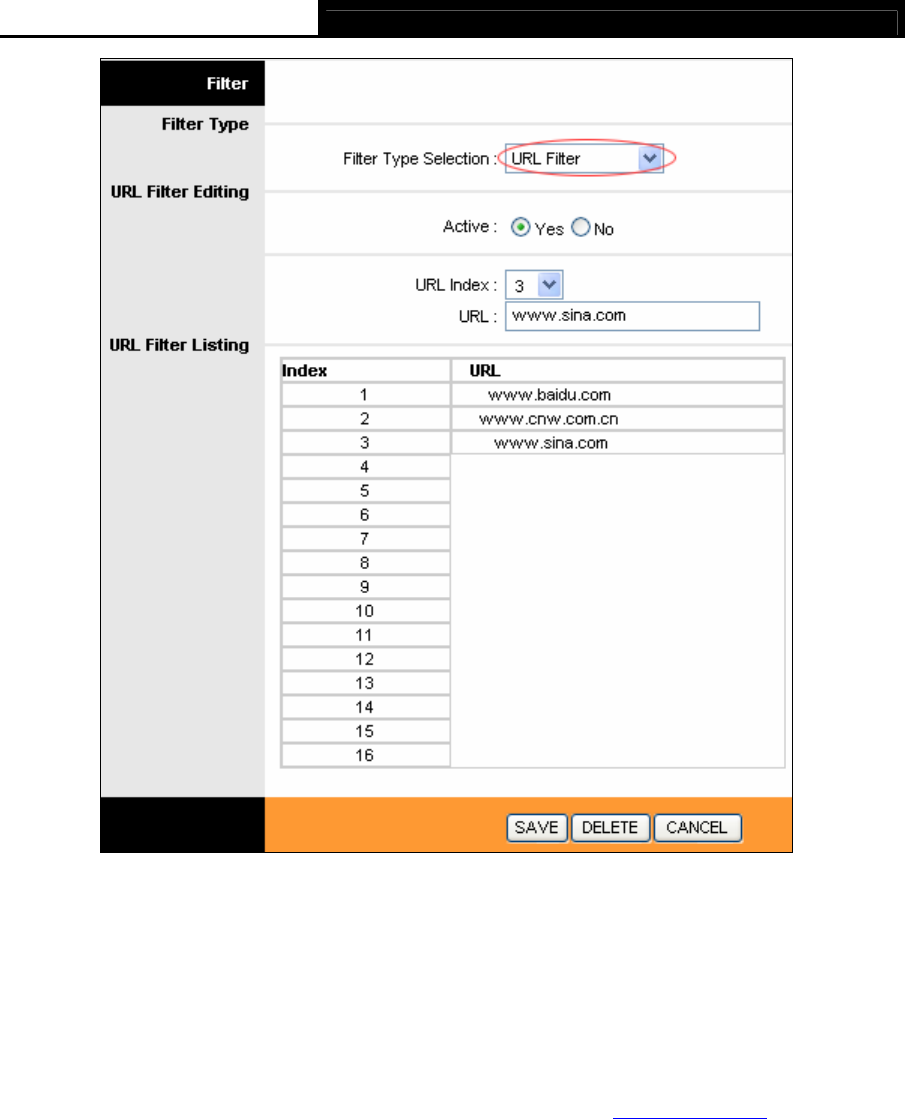
TD-W8961N 300Mbps Wireless N ADSL2+ Modem Router User Guide
60
Filter Type Selection: Select the URL Filter for the next configuration.
Active: Select “Yes” to make the rule to take effect.
URL Index: Select the index for the URL Filter entry.
URL: Enter the URL for this URL Filter.
URL Filter Listing: This displays the information about the URL Filter rules.
To add a URL filter entry:
For example: If you want to forbid the user to access the website: www.yahoo.com. Presume the
rule is aimed at the interface PVC0, and its index is “1”.
Step 1: Select the “URL Filter” as the Filter Type Selection.
Step 2: Select the Index for the rule, and then enter the website in the URL field.
Step 3: Finally, Select Yes to active the rule, and then click the SAVE to save the entry.
Other operations for the entries:
Select the URL Index to view or modify the entry.
Select the URL Index to locate the specific rule, and then click the DELETE button to delete the
entry.
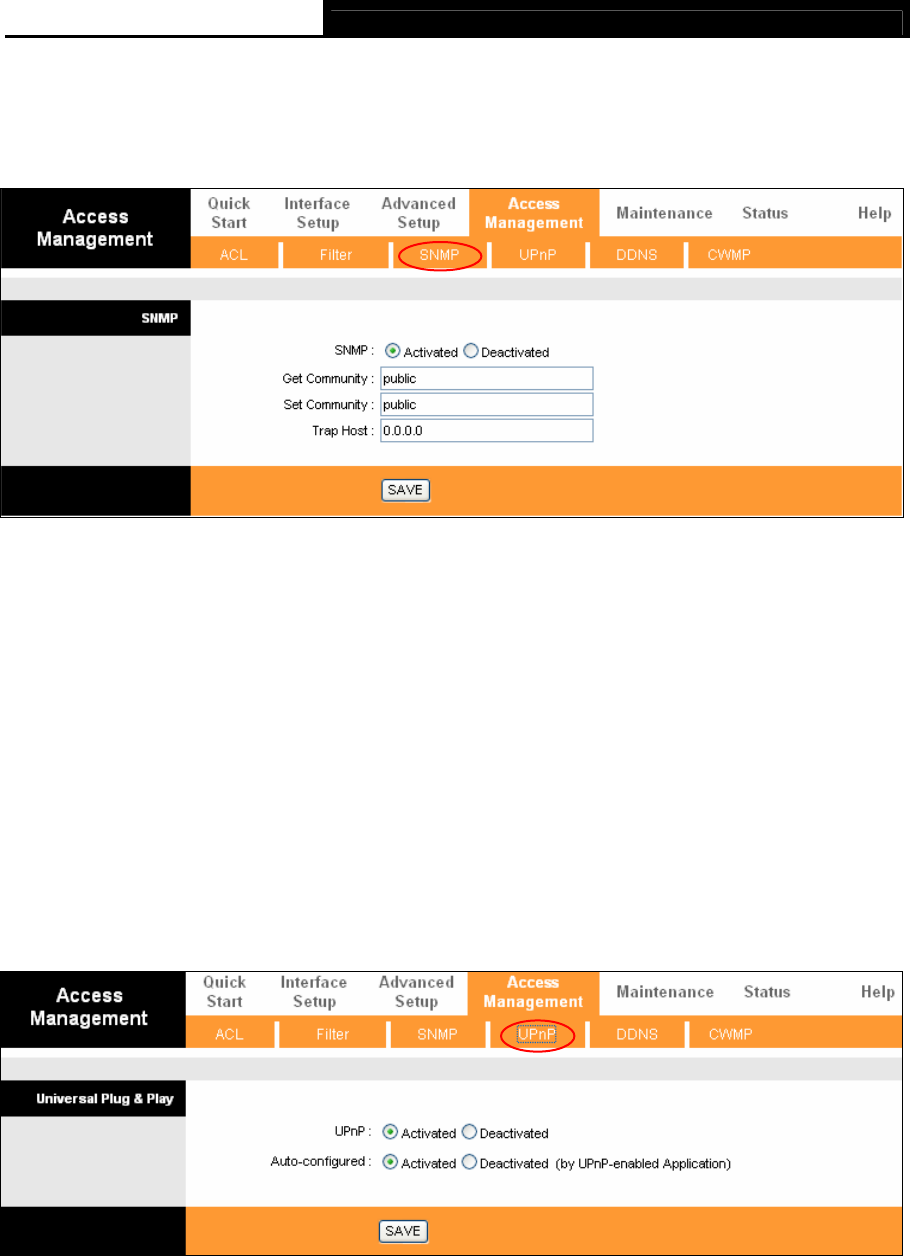
TD-W8961N 300Mbps Wireless N ADSL2+ Modem Router User Guide
61
4.5.3 SNMP
Choose “Access Management→SNMP”, you can see the SNMP screen. The Simple Network
Management Protocol (SNMP) is used for exchanging information between network devices.
Figure 4-26
Get Community: Set the password for the incoming Get and Get next requests from the
management station.
Set Community: Set the password for incoming Set requests from the management station.
4.5.4 UPnP
Choose “Access Management→UPnP”, you can configure the UPnP in the screen.
UPnP (Universal Plug and Play) is a distributed, open networking standard that uses TCP/IP for
simple peer-to-peer network connectivity between devices. An UPnP device can dynamically join
a network, obtain an IP address, convey its capabilities and learn about other devices on the
network. In turn, a device can leave a network smoothly and automatically when it is no longer in
use. UPnP broadcasts are only allowed on the LAN.
Figure 4-27
UPnP: Activate or Deactivate the UPnP function. Only when the function is activated, can the
UPnP take effect.
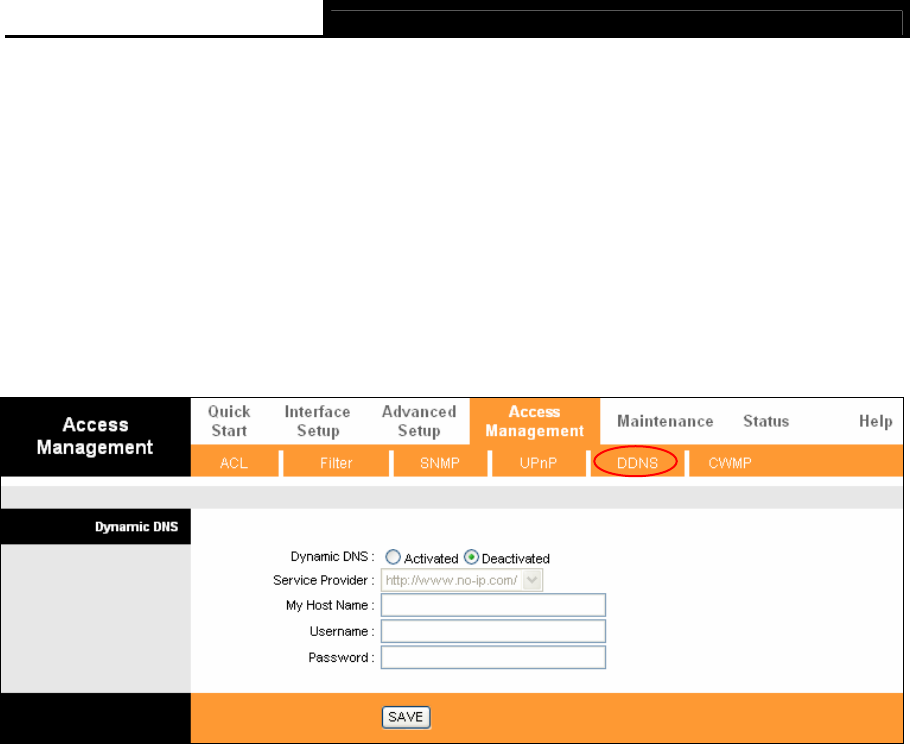
TD-W8961N 300Mbps Wireless N ADSL2+ Modem Router User Guide
62
Auto-Configure: If you activate the function, then the UPnP network devices can
automatically configure network addressing, announce their presence in the network to other
UPnP devices and enable exchange of simple product and service descriptions.
4.5.5 DDNS
Choose “Access Management→DDNS”, you can configure the DDNS function in the screen.
The modem router offers a Dynamic Domain Name System (DDNS) feature. The feature lets you
use a static host name with a dynamic IP address. User should type the host name, user name
and password assigned to your ADSL modem router by your Dynamic DNS provider.
Figure 4-28
Dynamic DNS: Activate the DDNS function or not.
Service Provider: This field displays the service provider of DDNS.
My Host Name: Enter your host name here.
Username & Password: Type the “User Name” and “Password” for your DDNS account.
4.5.6 CWMP
Choose “Access Management→CWMP”, you can configure the CWMP function in the screen.
The modem router offers CWMP feature. The function supports TR-069 protocol which collects
information, diagnoses the devices and configures the devices automatically via ACS
(Auto-Configuration Server).
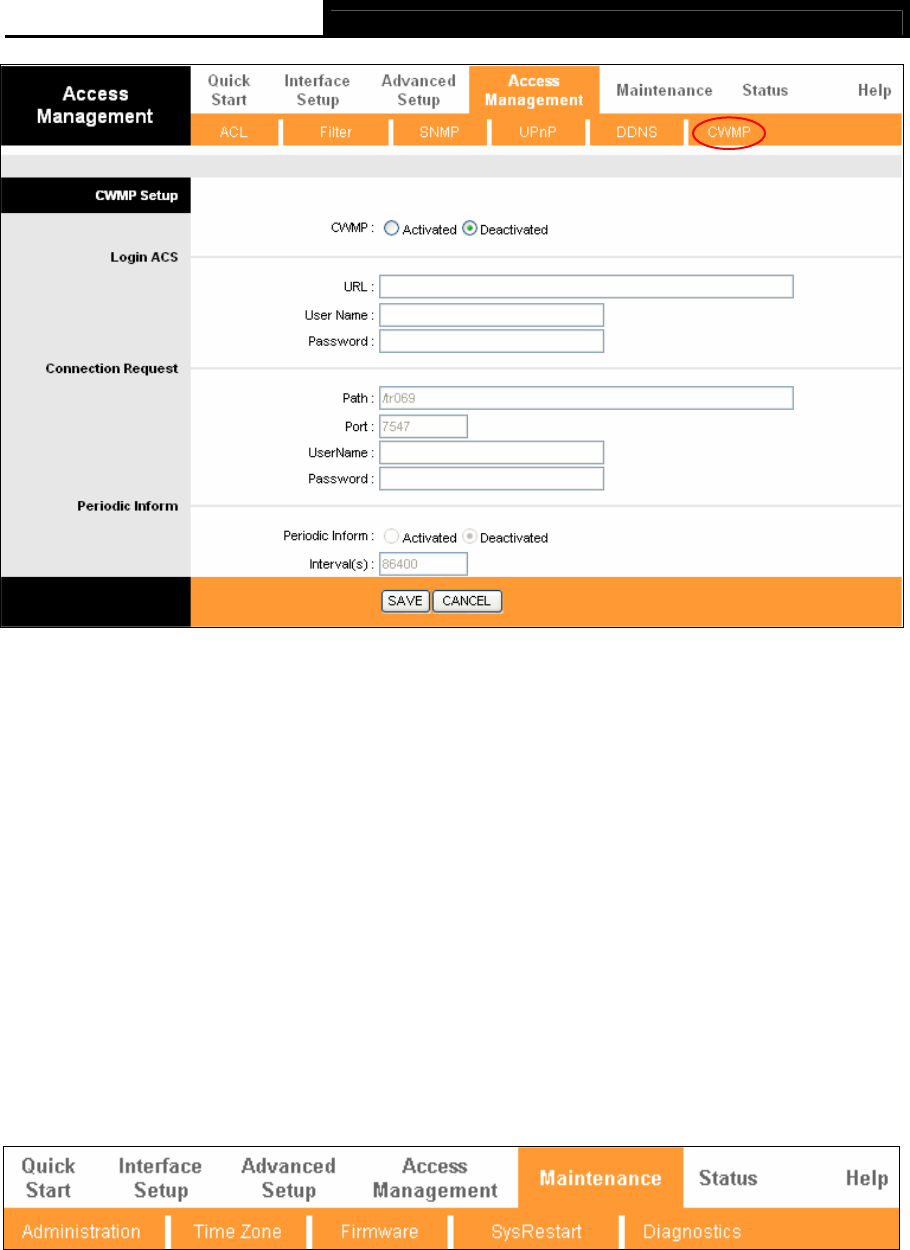
TD-W8961N 300Mbps Wireless N ADSL2+ Modem Router User Guide
63
Figure 4-29
CWMP: Select activate the CWMP function.
URL: Enter the website of ACS which is provided by your ISP.
User Name/Password: Enter the User Name and password to login the ACS server.
Path: Enter the path that connects to the ACS server.
Port: Enter the port that connects to the ACS server.
User Name/Password: Enter the User Name and Password that provided the ACS server to
login the modem router.
Periodic Inform: Activate or deactivate the function. If activated, the information will be
informed to ACS server periodically.
Interval: Enter the interval time here.
4.6 Maintenance
Choose “Maintenance”, you can see the following submenus:
Figure 4-30
Click any of them, and you will be able to configure the corresponding function.
4.6.1 Administration
Choose “Maintenance→Administration”, you can set new password for admin in the screen.

TD-W8961N 300Mbps Wireless N ADSL2+ Modem Router User Guide
64
Figure 4-31
Note:
1) There is only one account that can access Web-Management interface. The default account
is "admin", and the password is "admin". Admin has read/write access privilege.
2) When you change the password, you should enter the new password twice, and then click
SAVE to make the new password take effect.
4.6.2 Time Zone
Choose “Maintenance→Time Zone”, you can configure the system time in the screen.
The system time is the time used by the device for scheduling services. There are three methods
to configure the time. You can manually set the time or connect to a NTP (Network Time Protocol)
server. If a NTP server is set, you will only need to set the time zone. If you manually set the time,
you may also set Daylight Saving dates and the system time will automatically adjust on those
dates.
1) NTP Server automatically
Select NTP Server automatically as the Synchronize time, you only need to set the time zone.
Figure 4-32
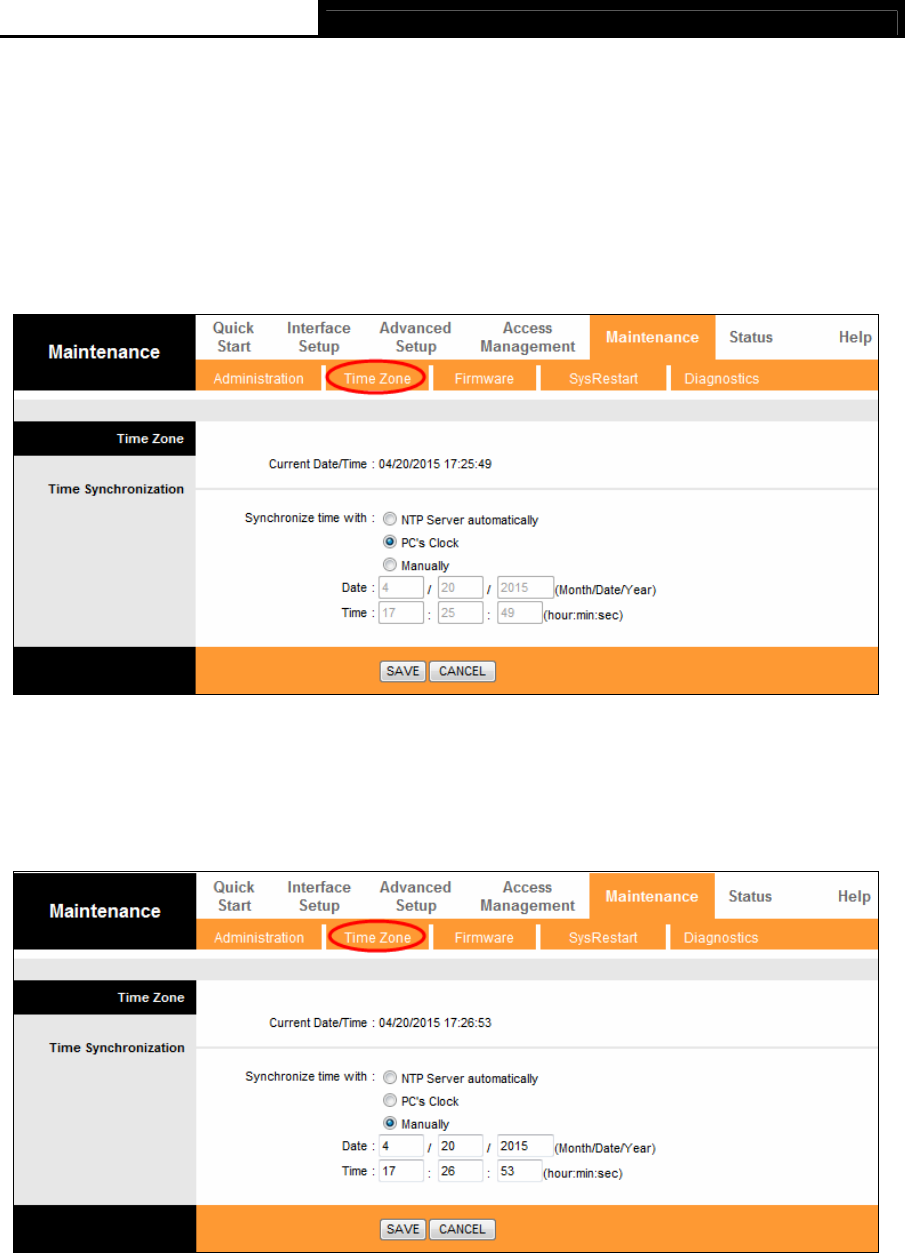
TD-W8961N 300Mbps Wireless N ADSL2+ Modem Router User Guide
65
Note:
The ADSL modem router built-in some NTP Servers, when the modem router connects to the
Internet, the modem router will get the system time automatically from the NTP Server. You can
also configure the NTP Server address manually, and then the modem router will get the time
from the specific Server firstly.
2) PC’s Clock
Select PC’s Clock as the Synchronize time, you don’t need to set any items.
Figure 4-33
3) Manually
Select Manually as the Synchronize time, you need to set the date and time corresponding to the
current time.
Figure 4-34
4.6.3 Firmware
Choose “Maintenance→Firmware”, you can upgrade the firmware of the modem router in the
screen. Make sure the firmware or romfile you want to use is on the local hard drive of the
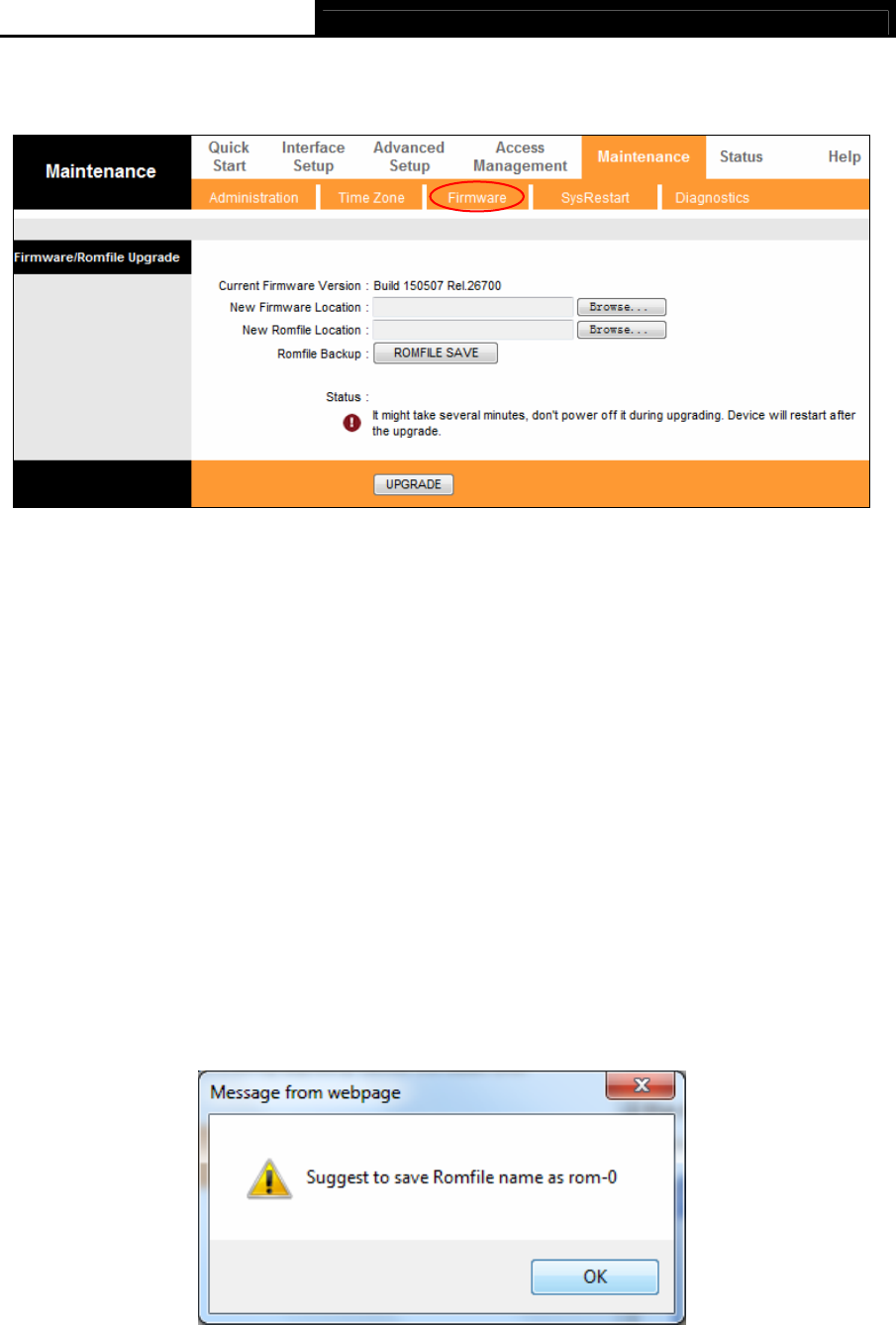
TD-W8961N 300Mbps Wireless N ADSL2+ Modem Router User Guide
66
computer. Click Browse to find the local hard drive and locate the firmware or romfile to be used
for upgrade.
Figure 4-35
To upgrade the modem router's firmware, follow these instructions below:
Step 1: Type the path and file name of the update file into the “New Firmware Location” field. Or
click the Browse button to locate the update file.
Step 2: Click the UPGRADE button.
Note:
1) When you upgrade the modem router's firmware, you may lose its current configurations,
so please back up the modem router’s current settings before you upgrade its firmware.
2) Do not turn off the modem router or press the WPS/Reset button while the firmware is
being upgraded.
3) The modem router will reboot after the upgrading has been finished.
To back up the modem router’s current settings:
Step 1: Click the ROMFILE SAVE button, click the OK button and then click the Save button in
the following screens to proceed.
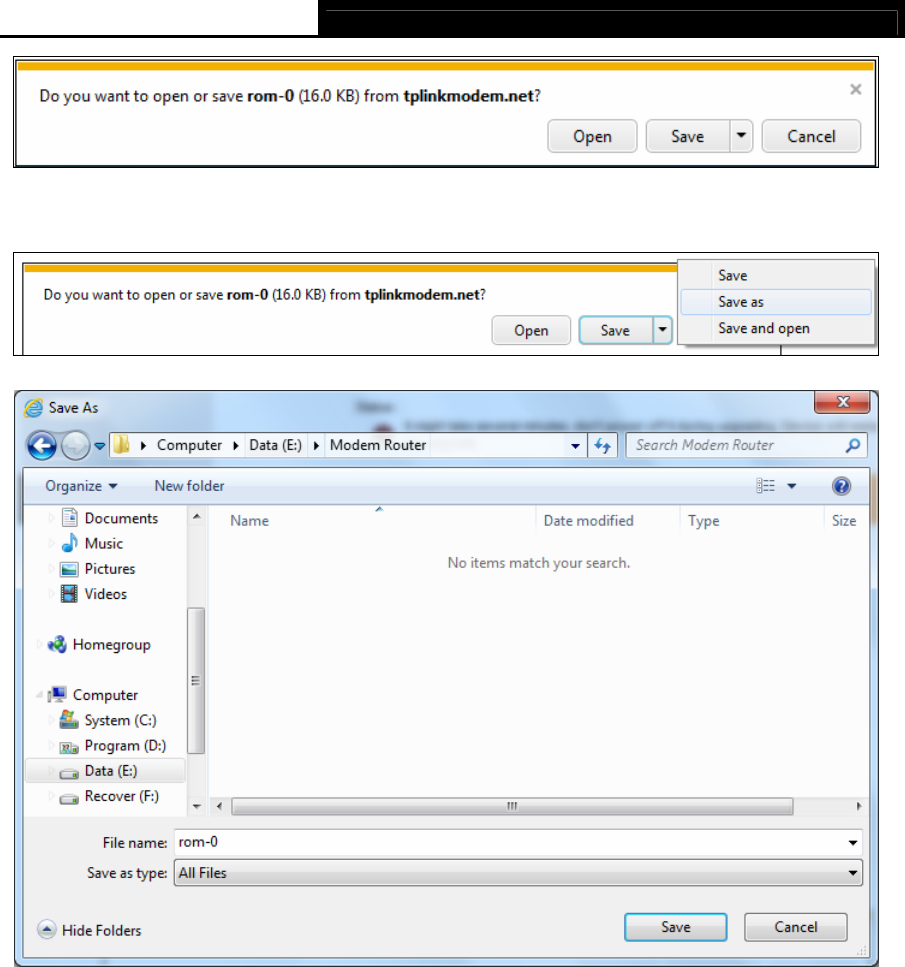
TD-W8961N 300Mbps Wireless N ADSL2+ Modem Router User Guide
67
Step 2: Save the file as the appointed file.
To restore the modem router’s settings:
Step 1: Click the Browse button to locate the update file for the device, or enter the exact path
in “New Romfile Location” field.
Step 2: Click the UPGRADE button to complete.
4.6.4 SysRestart
Choose “Maintenance→SysRestart”, you can select to restart the device with current settings
or restore to factory default settings in the screen.
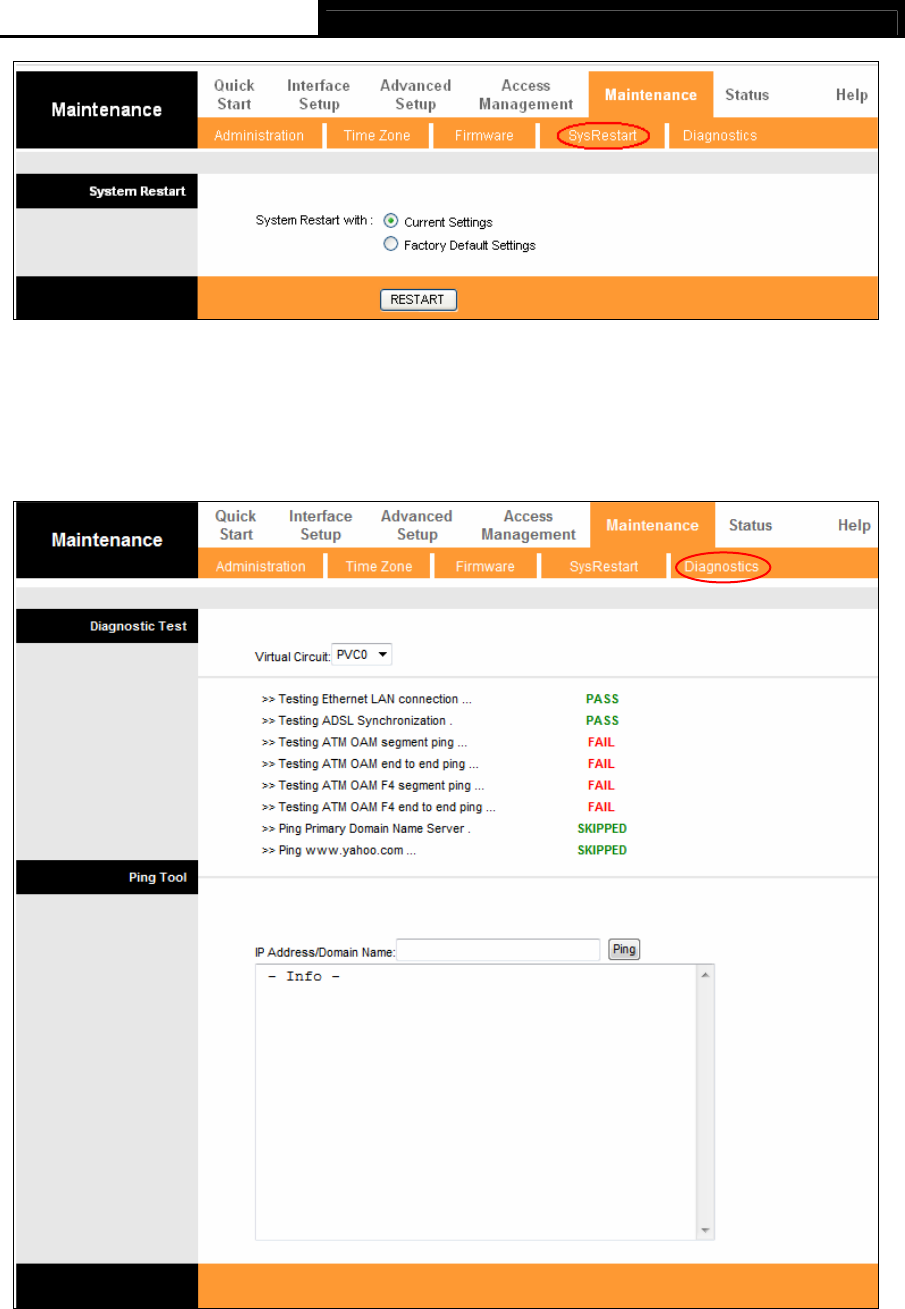
TD-W8961N 300Mbps Wireless N ADSL2+ Modem Router User Guide
68
Figure 4-36
4.6.5 Diagnostics
Choose “Maintenance→Diagnostics”, you can view the test results for the connectivity of the
physical layer and protocol layer for both LAN and WAN sides in the screen.
Figure 4-37
4.7 Help
Choose “Help”, you can view the help information for configuration of any function.
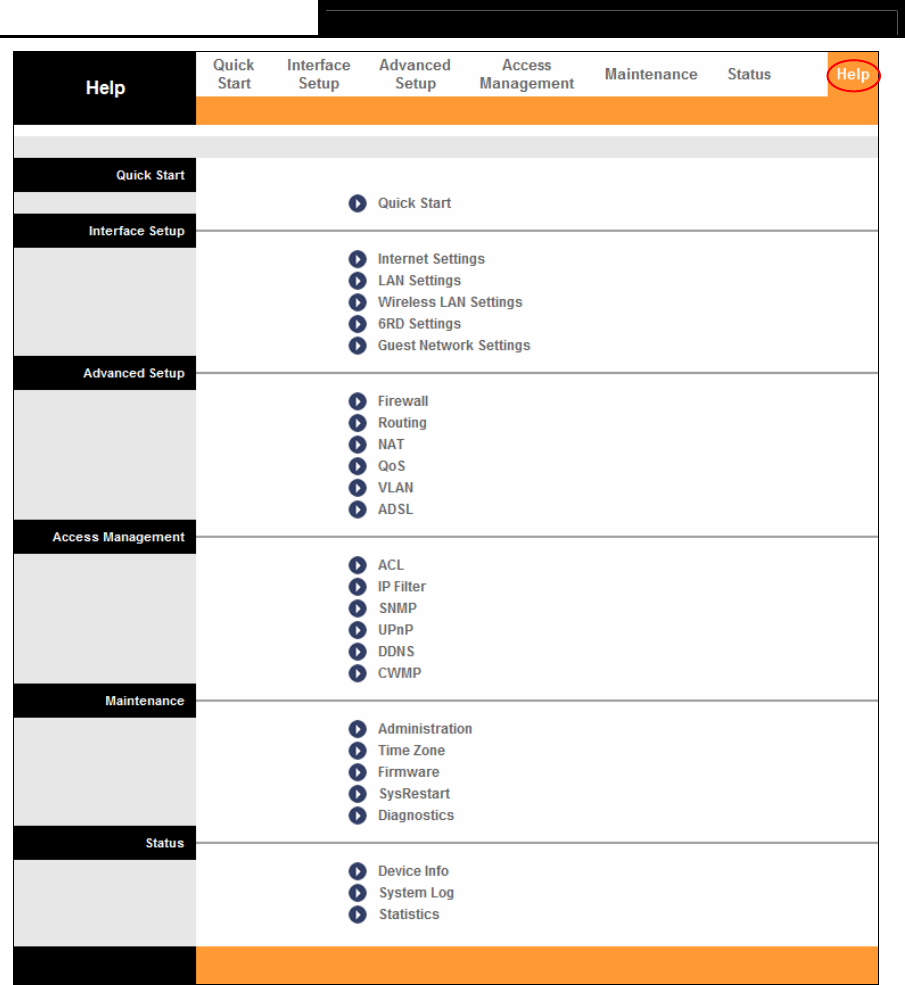
TD-W8961N 300Mbps Wireless N ADSL2+ Modem Router User Guide
69
Figure 4-38
Note:
Click the tab, and you will be able to get the corresponding information.

TD-W8961N 300Mbps Wireless N ADSL2+ Modem Router User Guide
70
Appendix A: Specifications
General
Standards and Protocols
ANSI T1.413, ITU G.992.1, ITU G.992.2, ITU G.992.3, ITU G.992.5,
IEEE 802.11b, IEEE 802.11g, IEEE 802.11n, IEEE 802.3, IEEE
802.3u, TCP/IP, PPPoA, PPPoE, SNTP, HTTP, DHCP, ICMP, NAT
Safety & Emission FCC, CE
Ports Four 10/100M Auto-Negotiation RJ45 ports(Auto MDI/MDIX)
One RJ11 port
LEDs Power, ADSL, Internet, WLAN, WPS
LAN 1, LAN 2, LAN 3, LAN 4
Network Medium
10Base-T: UTP category 3, 4, 5 cable
100Base-TX: UTP category-5
Max line length: 6.5Km
Data Rates Downstream: Up to 24Mbps
Upstream: Up to 2.5Mbps(With Annex M enabled)
System Requirement Internet Explorer 5.0 or later, Netscape Navigator 6.0 or later
Win 9x/ ME/ 2000/ XP/ Vista/ 7/ 8/ 8.1
Physical and Environment
Working Temperature 0 ~ 40℃℃
Working Humidity 10% ~ 90% RH (non-condensing)
Storage Temperature -40 ~ 70℃℃
Storage Humidity 5% ~ 90% RH (non-condensing)
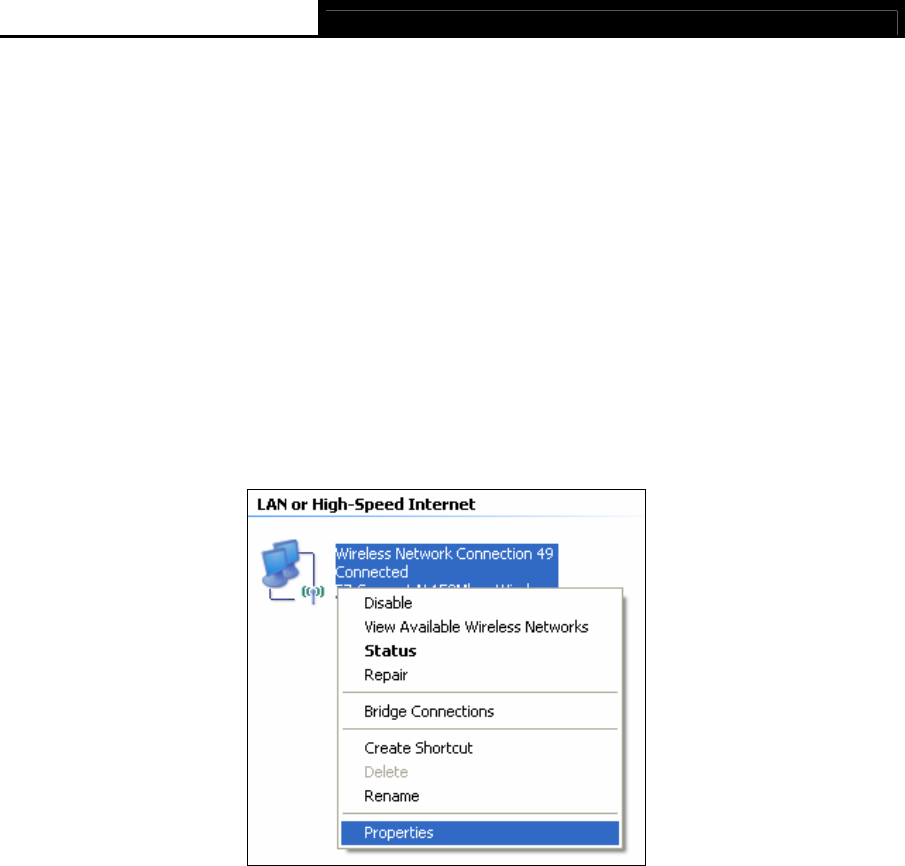
TD-W8961N 300Mbps Wireless N ADSL2+ Modem Router User Guide
71
Appendix B: Configuring the PC
In this section, we’ll introduce how to install and configure the TCP/IP correctly in Windows XP.
First make sure your Ethernet Adapter is working, refer to the adapter’s manual if necessary.
1. Configure TCP/IP component
1) On the Windows taskbar, click the Start button, and then click Control Panel.
2) Click the Network and Internet Connections icon, and then click on the Network
Connections tab in the appearing window.
3) Right click the icon that showed below, select Properties on the prompt page.
Figure B-1
4) In the prompt page that showed below, double click on the Internet Protocol (TCP/IP).
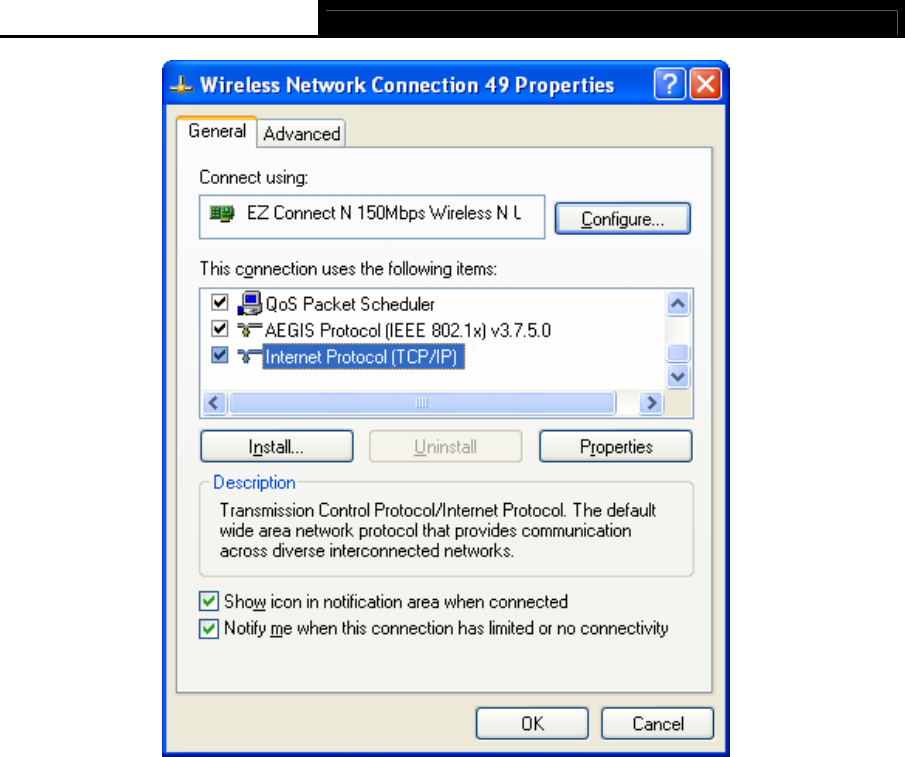
TD-W8961N 300Mbps Wireless N ADSL2+ Modem Router User Guide
72
Figure B-2
5) The following TCP/IP Properties window will display and the IP Address tab is open on
this window by default.
Now you have two ways to configure the TCP/IP protocol below:
Setting IP address automatically
Select Obtain an IP address automatically, Choose Obtain DNS server automatically, as
shown in the Figure below:
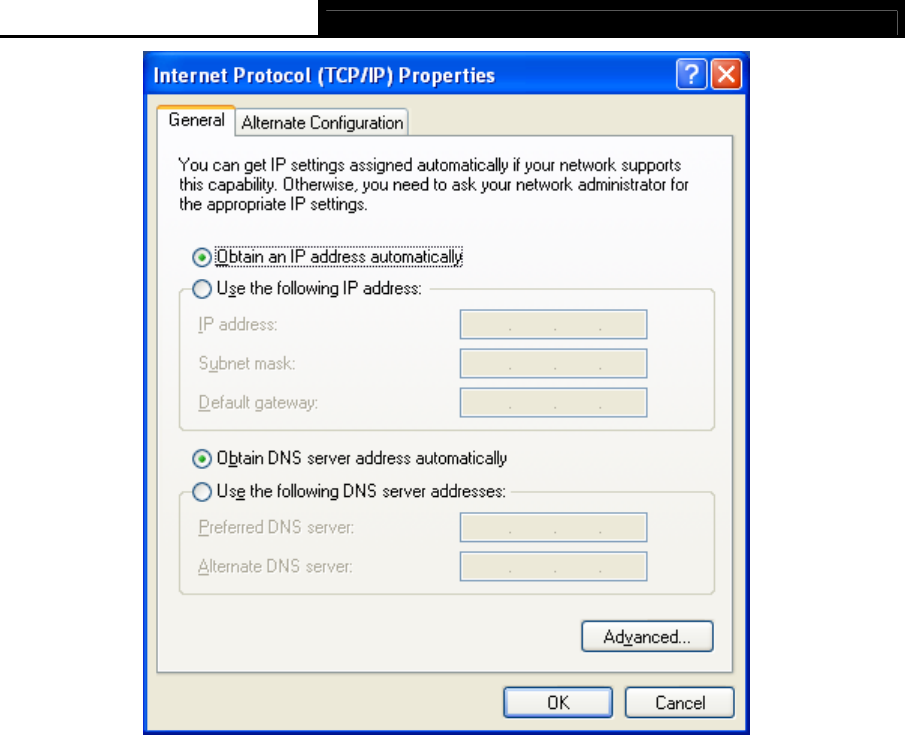
TD-W8961N 300Mbps Wireless N ADSL2+ Modem Router User Guide
73
Figure B-3
Note:
For Windows 98 OS or before, the PC and Router may need to be restarted.
Setting IP address manually
1 Select Use the following IP address radio button. And the following items available
2 If the modem router's LAN IP address is 192.168.1.1, specify the IP address as 192.168.1.x
(x is from 2 to 254), and the Subnet mask as 255.255.255.0.
3 Type the modem router’s LAN IP address (the default IP is 192.168.1.1) into the Default
gateway field.
4 Select Use the following DNS server addresses. In the Preferred DNS Server field you
can enter the same value as the Default gateway or type the local DNS server IP address.
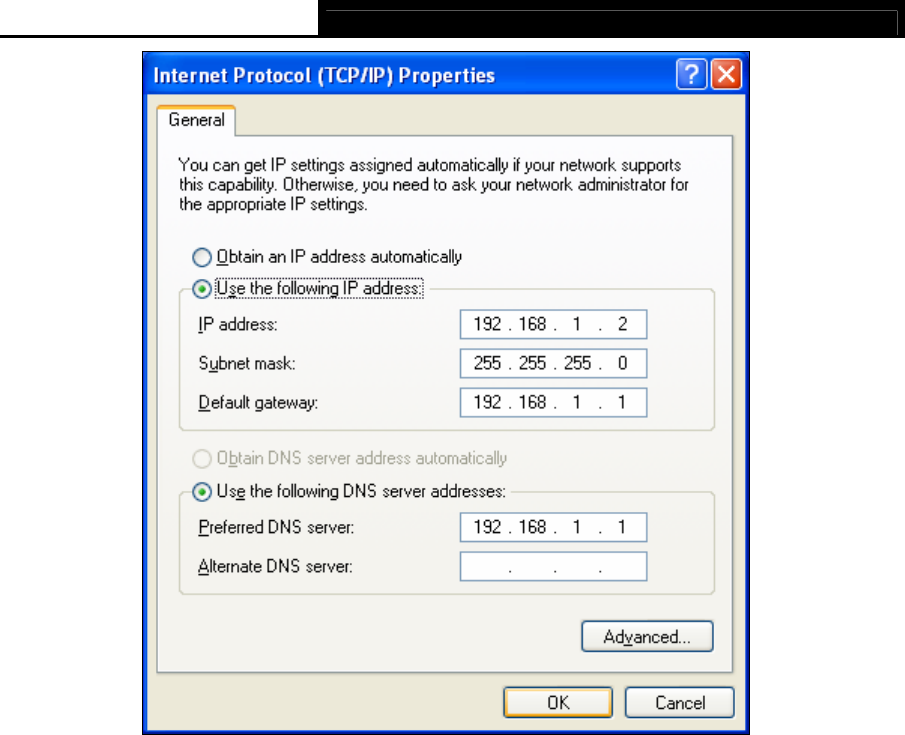
TD-W8961N 300Mbps Wireless N ADSL2+ Modem Router User Guide
74
Figure B-4
Now:
Click OK to keep your settings.

TD-W8961N 300Mbps Wireless N ADSL2+ Modem Router User Guide
75
Appendix C: Troubleshooting
T1. What can I do if I don’t know or forget my password?
1) For default wireless password: Please refer to the “Wireless Password/PIN” labeled on the
bottom of the modem router.
2) For the web management page password: Reset the modem router first and then use the
default user name and password: admin/admin.
T2. How do I restore my modem router’s configuration to its factory default
settings?
With the modem router powered on, press and hold down the WPS/RESET button on the rear
panel for at least 8 seconds until some LEDs go off, then release the button.
Note:
Once the modem router is reset, the current configuration settings will be lost and you will need to
re-configure the router.
T3. What can I do if I cannot access the web-based configuration page?
1) Configure your computer’s IP Address.
For Mac OS X
a) Click the Apple icon on the upper left corner of the screen.
b) Go to “System Preferences -> Network”.
c) Select Airport on the left menu bar, and then click Advanced for wireless configuration; or
select Ethernet for wired configuration.
d) In the Con-figure IPv4 box under TCP/IP, select Using DHCP.
e) Click Apply to save the settings.
For Windows 7
f) Click “Start -> Control Panel -> Network and Internet -> View network status -> Change
adapter settings”.
g) Right-click Wireless Network Connection (or Local Area Connection), and then click
Properties.
h) Select Internet Protocol Version 4 (TCP/IPv4), and then click Properties.
i) Select Obtain an IP address automatically and Obtain DNS server address automatically.
Then click OK.
For Windows XP
j) Click “Start -> Control Panel -> Network and Internet Connections -> Network
Connections”.
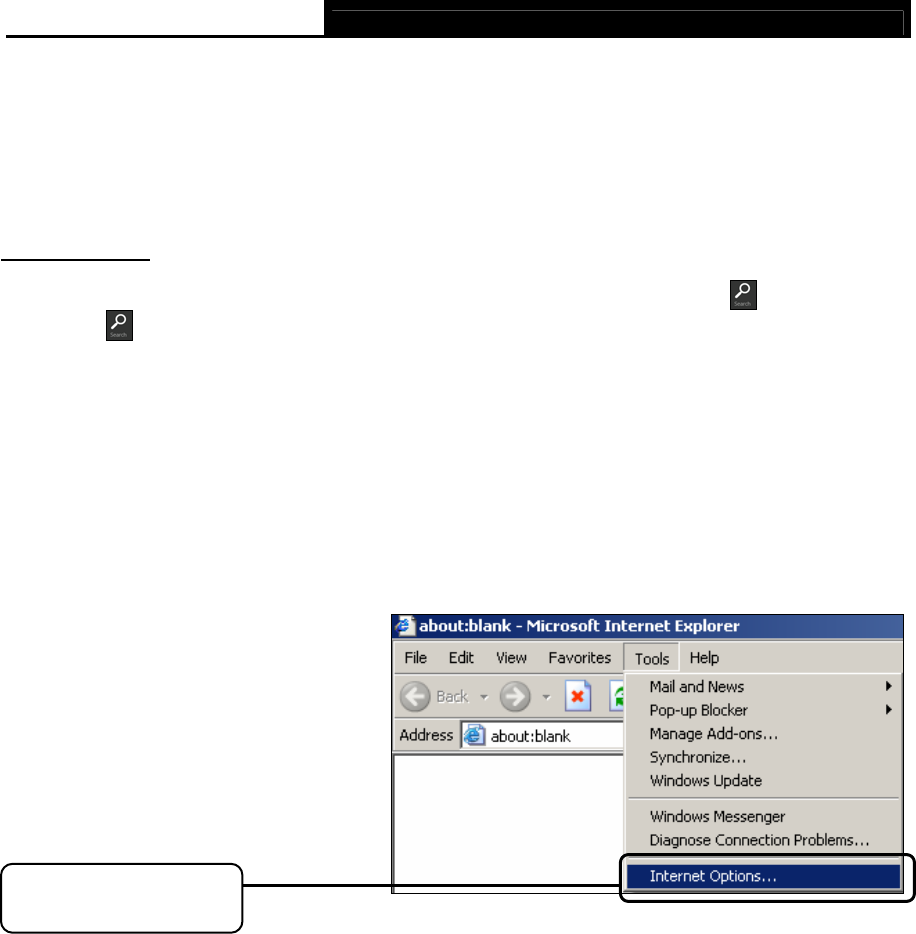
TD-W8961N 300Mbps Wireless N ADSL2+ Modem Router User Guide
76
k) Right-click Wireless Network Connection (or Local Area Connection), and then click
Properties.
l) Select Internet Protocol (TCP/IP), and then click Properties.
m) Select Obtain an IP address automatically and Obtain DNS server address automatically.
Then click OK.
For Windows 8
n) Move your mouse to the lower right corner and you will see Search icon in the Popups.
Go to “ -> Apps”. Type Control Panel in the search box and press Enter, then you will go
to Control Panel.
o) Click “View network status and tasks > Change adapter settings”.
p) Right-click “Ethernet” and then select Properties.
q) Double-click Internet Protocol Version 4 (TCP/IPv4). Select Obtain an IP address
automatically, choose Obtain DNS server address automatically and then click OK.
2) Configure your IE browser
Open your IE browser, click
Tools tab and you will see the
following screen.
Click Internet Options
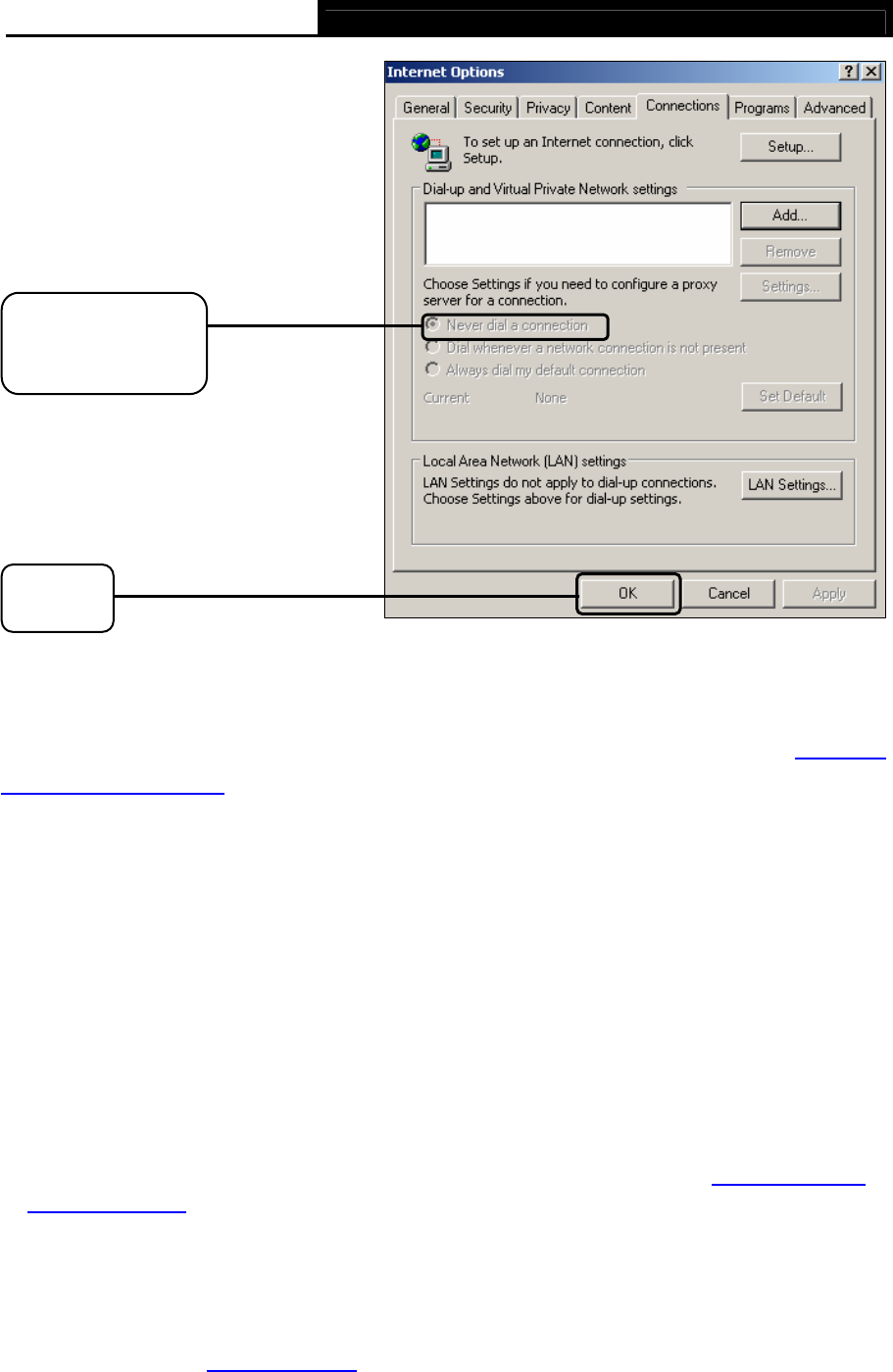
TD-W8961N 300Mbps Wireless N ADSL2+ Modem Router User Guide
77
Click OK
Select Never dial a
connection
Now, try to log on to the Web-based configuration page again after the above settings have been
configured. If you still cannot access the configuration page, please restore your modem router’s
factory default settings and reconfigure your modem router following the instructions in Chapter 3
Quick Installation Guide. Please feel free to contact our Technical Support if the problem still
exists.
T4. What can I do if I cannot access the Internet?
1) Check to see if all the connectors are connected well, including the telephone line, Ethernet
cables and power adapter.
2) Check to see if you can log on to the web management page of the modem router. If you can,
try the following steps. If you cannot, please set your computer referring to T3 then try to see if
you can access the Internet. If the problem persists, please go to the next step.
3) Consult your ISP and make sure all the VPI/VCI, Connection Type, account username and
password are correct. If there are any mistakes, please correct the settings and try again.
4) If you still cannot access the Internet, please restore your modem router to its factory default
settings and reconfigure your modem router by following the instructions in Chapter 3 Quick
Installation Guide.
5) Please feel free to contact our Technical Support if the problem still exists.
Note:
For more details about Troubleshooting and Technical Support contact information, please refer
to the support page at www.tp-link.com.